New NPM integration: design with fully interactive components from top libraries!

Creating A User Research Plan (with Examples)
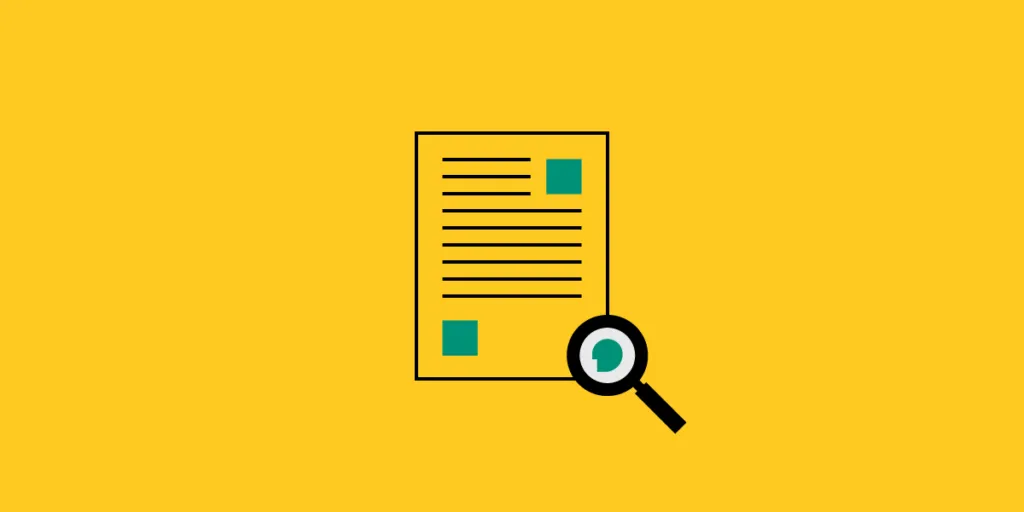
UX research helps to test hypothesis you have about users prior to design. Sadly, not every UX design project starts with user research, and that’s because it takes a lot of time to recruit participants, run UX research projects, and sumamrize findings.
Good research, nevertheless, ensures that your product team doesn’t build the wrong functionality that would cost you valuable resources and make you vulnerable to losing customers.
In this article, you’ll see how you can use UX research plan to get stakeholder’s buy-in and create research reports that’s full of valuable advice for product design. Let’s go.
At the end, when you have your research complete, launch the right tool for your design process. For that, try UXPin, an end-to-end design tool for interactive prototyping that brings design and product development together.
Designers can create a powerful prototypes, show them to product managers who can interact with the design instead of just looking at it. Then, they give the design to engineers who can get all the specs and some code to kickstart front-end design with.
Since with UXPin you work faster, you have ample time for UX research before UX design. Try it for free .
Build advanced prototypes
Design better products with States, Variables, Auto Layout and more.

What is a UX Research Plan?
A UX research plan helps to set expectations and document the essentials you need to communicate to stakeholders and clients. Your company needs a strong business case for every user research session, complete with research objectives, goals, methods, and logistical needs for the study.
UX Research Plan Elements
Every UX research plan should start with a solid outline. That’s where templates come in handy. They help you structure your UX research project in a way that team members and stakeholders see value in completing research process.
Master templates are the best way to create a successful and effective UX research plan. Using a template as a starting point makes planning and writing easier and helps you and your team stay focused on the who, what, why, and when of research. Read on for tips and examples for how you can build a user research plan that works.
UX Research Plan Background
The background section should offer your clients and stakeholders a few sentences on why you are creating a user research plan and what it will accomplish. It should orient readers to the needs and expectations behind the purpose of the study. It should also include a problem statement, which is the primary question you’re setting out to answer with your research findings.
Example Background
The purpose of this study is to understand the major pain points users experience in using our website/app and how these contribute to issues such as cart abandonment, returned items, and low customer loyalty.
We will be using usability testing to follow the user’s experience of our website/app and the obstacles they encounter leading up to the point of purchase. We will also be using generative research techniques to better understand the customer’s experience of our brand and the challenges and needs they face in making a purchase.
UX Research Plan Objectives
Before getting into the nitty-gritty of your user research plan, you first want to focus on your research objectives. This step outlines the reasons you are conducting a UX research plan in the first place. Why are you carrying out this research? What are the end goals you have after completing all the work?
Seeking out answers to these questions should be a collaborative effort between you and your stakeholders. It’s also helpful to consider discussions and learnings from past clients and projects to create metrics for your UX research plan.
Objectives and Success Metrics
Research objectives will be different for every project, but they should always be actionable and specific.
Example Objectives
- Understand how users currently go about tracking orders on our website
- Understand what actions customers take when they consider buying a new [product we offer]
- Learn about competitor websites/apps customers are using to buy [product we offer]
- Evaluate pain points customers are experiencing in using our website/app
And here are some examples to help you determine the success of your UX research plan.
Example Success Metrics
- What information are we trying to collect about users?
- What scales/documents/statistics do we intend to create?
- What decisions will these materials help to make?
UX Research Plan Methodology
This step should be a short and sweet description of the research methods you will use to answer the research objectives. It should include both secondary and primary methods. Generative methods, such as user interviews and open-ended questions, help uncover motivations or more general insights, while UX testing helps to evaluate the usability and experience of your product.

Research Scope & Focus Areas
Clearly outlining the research scope and focus areas helps to facilitate efficient user research planning. The more you’re able to hone in on the specifics of what information you are wanting to collect, the less overwhelmed you will be in the process. It also helps avoid inundating your clients with unnecessary information.
To keep research-focused, this section should include:
- 3-6 question topics (e.g. How do users spend their time on a website?)
- Design Focus Components, including interface qualities (e.g. Usability, Training, Efficiency, Satisfaction)
- Primary User Scenarios (e.g. Scenarios in which pain points are most problematic; scenarios you have the least information about, etc.)
Example Methodology
For this study, we’re conducting a 30-minute usability test to evaluate our user’s experience of our app/website. A secondary method will be to conduct one-on-one generative research interviews to better understand our customers and empathize with their needs.
UX Research Plan Participant Profiles
Once you’ve defined objectives methodology and focus areas, it’s time to outline the participants you’ll need to get the required insights. Participant profiles help you determine who you want to recruit, or an approximation of your users, to optimize recruiting efforts. Here are a few examples of how to ensure you’ll get the best participants for your study.

Define your target user by collaborating with internal stakeholders, marketing, sales, and customer support. With their help, you can create approximations about who your users are. This is a great starting point for finding the right participants for your study.
Compare yourself to your competitors and create participant profiles based on their audiences. Recruiting people who use a competitor’s product can be an excellent way to glean insights into how to further improve your product.
Outline a screening process. Participant profiles should include any relevant information concerning your target audience, including behaviors, needs, demographics, geography, etc. Including the right criteria will help you evaluate whether or not to include certain individuals in your user research plan.
This Nielsen Norman article offers some great information about defining and recruiting the right participants for your study.
UX Research Plan Timeline
This is optional, but many UX research plans include a timeline that offers clients and stakeholders a general overview of how long the research will take. It helps to set expectations for the final results as well as allowing you to create a schedule for research sessions, debriefing, follow-up, and deliverables.
Timeline Example:
Approximately 6-8 weeks for identifying objectives, creating participant profiles, recruitment, in-person meetings, qualitative research, and analysis.
Try an End-to-End Design Solution
UX research plan templates are essential tools for executing a successful project. Having a master template helps you to remember what the process entails, communicate essential information to the right people, and stay on track throughout the user research plan.
UXPin, besides being a great prototyping tool, makes creating such research templates fast and easy. Especially since each project will be a little different and plans will need tweaking in terms of structure and content. Try UXPin for free .
Build prototypes that are as interactive as the end product. Try UXPin

by UXPin on 8th October, 2020
UXPin is a product design platform used by the best designers on the planet. Let your team easily design, collaborate, and present from low-fidelity wireframes to fully-interactive prototypes.
No credit card required.
These e-Books might interest you

Design Systems & DesignOps in the Enterprise
Spot opportunities and challenges for increasing the impact of design systems and DesignOps in enterprises.

DesignOps Pillar: How We Work Together
Get tips on hiring, onboarding, and structuring a design team with insights from DesignOps leaders.
We use cookies to improve performance and enhance your experience. By using our website you agree to our use of cookies in accordance with our cookie policy.
Integrations
What's new?
Prototype Testing
Live Website Testing
Feedback Surveys
Interview Studies
Card Sorting
Tree Testing
In-Product Prompts
Participant Management
Automated Reports
Templates Gallery
Choose from our library of pre-built mazes to copy, customize, and share with your own users
Browse all templates
Financial Services
Tech & Software
Product Designers
Product Managers
User Researchers
By use case
Concept & Idea Validation
Wireframe & Usability Test
Content & Copy Testing
Feedback & Satisfaction
Content Hub
Educational resources for product, research and design teams
Explore all resources
Question Bank
Research Maturity Model
Guides & Reports
Help Center
Future of User Research Report
The Optimal Path Podcast
Maze Guides | Resources Hub
What is UX Research: The Ultimate Guide for UX Researchers
0% complete
Essential elements of an effective UX research plan (examples + templates)
Conducting UX research without a plan is like moving to another country without knowing the language—confusing and exhausting.
To avoid wasting time and resources, it’s crucial to set achievable research goals and work on developing a research plan that’s clear, comprehensive, and aligned with your overarching business goals and research strategy.
A good UX research plan sets out the parameters for your research, and guides how you’ll gather insights to inform product development. In this chapter, we share a step-by-step guide to creating a research plan, including templates and tactics for you to try. You’ll also find expert tips from Paige Bennett, Senior User Research Manager at Affirm, and Sinéad Davis Cochrane, Research Manager at Workday.
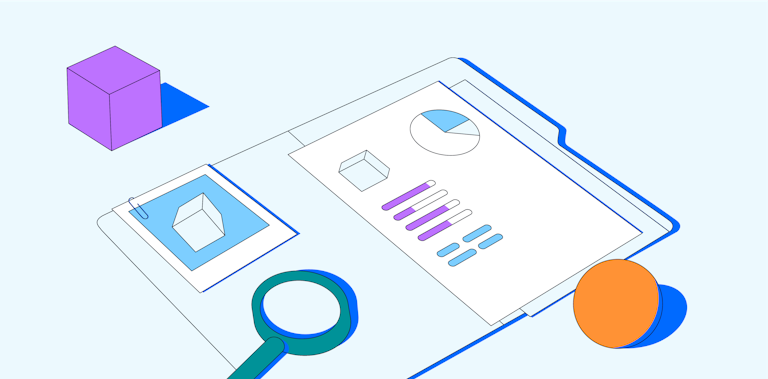
What is a UX research plan?
A UX research plan—not to be confused with a UX research strategy or research design—is a plan to guide individual user experience (UX) research projects.
It's a living document that includes a detailed explanation of tactics, methods, timeline, scope, and task owners. It should be co-created and shared with key stakeholders, so everyone is familiar with the project plan, and product teams can meet strategic goals.
A UX research plan is different to a research strategy and research design in both its purpose and contents. Let’s take a look.
Research plan vs. research design vs. research strategy: What’s the difference?
While your UX research plan should be based on strategy, it’s not the same thing. Your UX strategy is a high-level document that contains goals, budget, vision, and expectations. Meanwhile, a plan is a detailed document explaining how the team will achieve those strategic goals. Research design is the form your research itself takes.
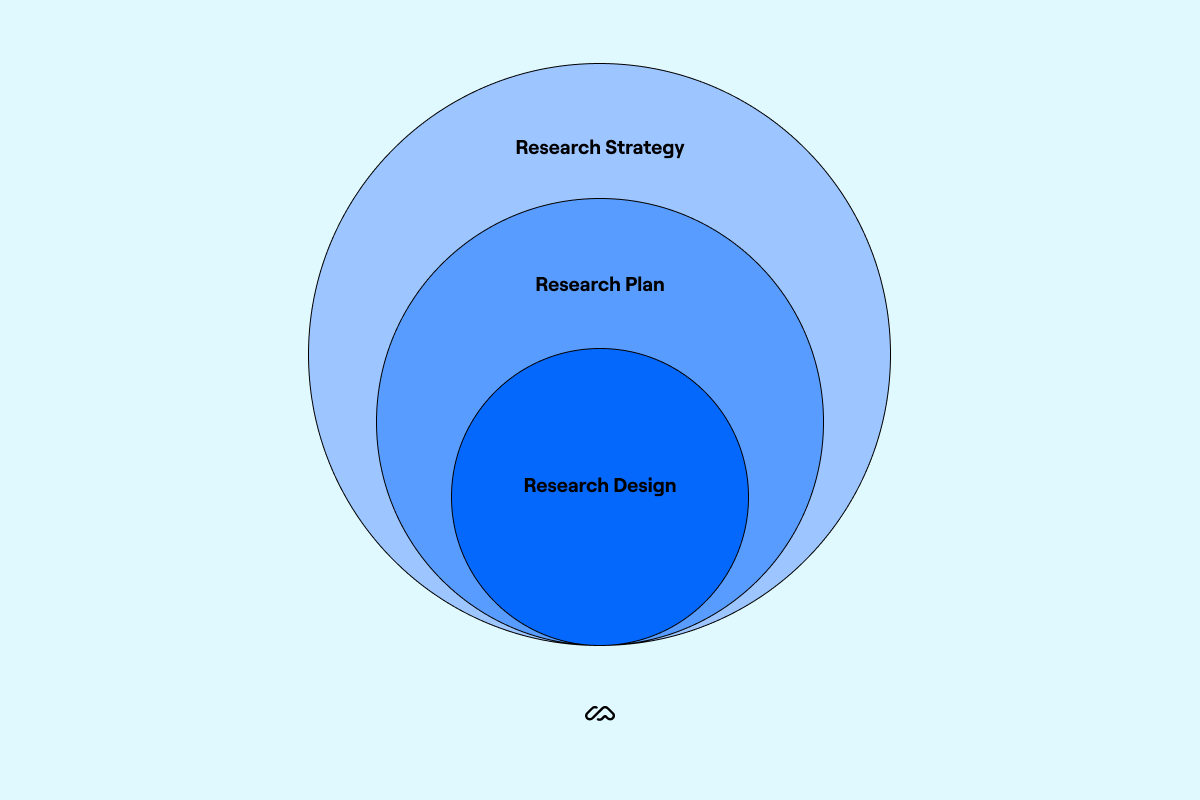
In short, a strategy is a guide, a plan is what drives action, and design is the action itself.
Research design | to be employed and specifics on how they’ll be used in the study (e.g., qualitative interviews, quantitative surveys, experimental trials) that will assist in data collection (sampling size) and how they will be selected | |
|---|---|---|
Research plan | or goals of the research that will be used to gather and analyze data of the project (like budget and personnel) required | |
Research strategy |
What are the benefits of using a UX research plan?
Conducting research without goals and parameters is aimless. A UX research plan is beneficial for your product, user, and business—by building a plan for conducting UX research, you can:
Streamline processes and add structure
Work toward specific, measurable goals, align and engage stakeholders, save time by avoiding rework.
The structure of a research plan allows you to set timelines, expectations, and task owners, so everyone on your team is aligned and empowered to make decisions. Since there’s no second guessing what to do next or which methods to use, you’ll find your process becomes simpler and more efficient. It’s also worth standardizing your process to turn your plan into a template that you can reuse for future projects.
When you set research goals based on strategy, you’ll find it easier to track your team’s progress and keep the project in scope, on time, and on budget. With a solid, strategy-based UX research plan you can also track metrics at different stages of the project and adjust future tactics to get better research findings.
“It’s important to make sure your stakeholders are on the same page with regards to scope, timeline, and goals before you start," explains Paige Bennett, Senior User Research Manager at Affirm. That's because, when stakeholders are aligned, they're much more likely to sign off on product changes that result from UX research.
A written plan is a collaborative way to involve stakeholders in your research and turn them into active participants rather than passive observers. As they get involved, they'll make useful contributions and get a better understanding of your goals.
A UX research plan helps you save time and money quite simply because it’s easier and less expensive to make design or prototype changes than it is to fix usability issues once the product is coded or fully launched. Additionally, having a plan gives your team direction, which means they won’t be conducting research and talking to users without motive, and you’ll be making better use of your resources. What’s more, when everyone is aligned on goals, they’re empowered to make informed decisions instead of waiting for their managers’ approval.
What should a UX research plan include?
In French cuisine, the concept of mise en place—putting in place—allows chefs to plan and set up their workspace with all the required ingredients before cooking. Think of your research plan like this—laying out the key steps you need to go through during research, to help you run a successful and more efficient study.
Here’s what you should include in a UX research plan:
- A brief reminder of the strategy and goals
- An outline of the research objectives
- The purpose of the plan and studies
- A short description of the target audience, sample size, scope, and demographics
- A detailed list of expectations including deliverables, timings, and type of results
- An overview of the test methods and a short explanation of why you chose them
- The test set up or guidelines to outline everything that needs to happen before the study: scenarios, screening questions, and duration of pilot tests
- Your test scripts, questions to ask, or samples to follow
- When and how you’ll present the results
- Cost estimations or requests to go over budget
Collect all UX research findings in one place
Use Maze to run quantitative and qualitative research, influence product design, and shape user-centered products.

How to create a UX research plan
Now we’ve talked through why you need a research plan, let’s get into the how. Here’s a short step-by-step guide on how to write a research plan that will drive results.
- Define the problem statement
- Get stakeholders’ buy-in
- Identify your objectives
- Choose the right research method
- Recruit participants
- Prepare the brief
- Establish the timeline
- Decide how you’ll present your findings
1. Define the problem statement
One of the most important purposes of a research plan is to identify what you’re trying to achieve with the research, and clarify the problem statement. For Paige Bennett , Senior User Research Manager at Affirm, this process begins by sitting together with stakeholders and looking at the problem space.
“We do an exercise called FOG, which stands for ‘Fact, Observation, Guess’, to identify large gaps in knowledge,” says Paige. “Evaluating what you know illuminates questions you still have, which then serves as the foundation of the UX research project.”
You can use different techniques to identify the problem statement, such as stakeholder interviews, team sessions, or analysis of customer feedback. The problem statement should explain what the project is about—helping to define the research scope with clear deliverables and objectives.
2. Identify your objectives
Research objectives need to align with the UX strategy and broader business goals, but you also need to define specific targets to achieve within the research itself—whether that’s understanding a specific problem, or measuring usability metrics . So, before you get into a room with your users and customers, “Think about the research objectives: what you’re doing, why you’re doing it, and what you expect from the UX research process ,” explains Sinéad Davis Cochrane , Research Manager at Workday.
Examples of research objectives might be:
- Learn at what times users interact with your product
- Understand why users return (or not) to your website/app
- Discover what competitor products your users are using
- Uncover any pain points or challenges users find when navigating with your product
- Gauge user interest in and prioritize potential new features
A valuable purpose of setting objectives is ensuring your project doesn't suffer from scope creep. This can happen when stakeholders see your research as an opportunity to ask any question. As a researcher , Sinéad believes your objectives can guide the type of research questions you ask and give your research more focus. Otherwise, anything and everything becomes a research question—which will confuse your findings and be overwhelming to manage.
Sinéad shares a list of questions you should ask yourself and the research team to help set objectives:
- What are you going to do with this information?
- What decisions is it going to inform?
- How are you going to leverage these insights?
Another useful exercise to help identify research objectives is by asking questions that help you get to the core of a problem. Ask these types of questions before starting the planning process:
- Who are the users you’re designing this for?
- What problems and needs do they have?
- What are the pain points of using the product?
- Why are they not using a product like yours?
3. Get stakeholders buy-in
It’s good practice to involve stakeholders at early stages of plan creation to get everyone on board. Sharing your UX research plan with relevant stakeholders means you can gather context, adjust based on comments, and gauge what’s truly important to them. When you present the research plan to key stakeholders, remember to align on the scope of research, and how and when you’ll get back to them with results.
Stakeholders usually have a unique vision of the product, and it’s crucial that you’re able to capture it early on—this doesn’t mean saying yes to everything, but listening to their ideas and having a conversation. Seeing the UX research plan as a living document makes it much easier to edit based on team comments. Plus, the more you listen to other ideas, the easier it will be to evangelize research and get stakeholder buy-in by helping them see the value behind it.
I expect my stakeholders to be participants, and I outline how I expect that to happen. That includes observing interviews, participating in synthesis exercises, or co-presenting research recommendations.

Paige Bennett , Senior User Research Manager at Affirm
4. Choose the right research method

Choose between the different UX research methods to capture different insights from users.
To define the research methods you’ll use, circle back to your research objectives, what stage of the product development process you’re in, and the constraints, resources, and timeline of the project. It’s good research practice to use a mix of different methods to get a more complete perspective of users’ struggles.
For example, if you’re at the start of the design process, a generative research method such as user interviews or field studies will help you generate new insights about the target audience. Or, if you need to evaluate how a new design performs with users, you can run usability tests to get actionable feedback.
It’s also good practice to mix methods that drive quantitative and qualitative results so you can understand context, and catch the user sentiment behind a metric. For instance, if during a remote usability test, you hear a user go ‘Ugh! Where’s the sign up button?’ you’ll get a broader perspective than if you were just reviewing the number of clicks on the same test task.
Examples of UX research methods to consider include:
- Five-second testing
- User interviews
- Field studies
- Card sorting
- Tree testing
- Focus groups
- Usability testing
- Diary studies
- Live website testing
Check out our top UX research templates . Use them as a shortcut to get started on your research.
5. Determine how to recruit participants
Every research plan should include information about the participants you need for your study, and how you’ll recruit them. To identify your perfect candidate, revisit your goals and the questions that need answering, then build a target user persona including key demographics and use cases. Consider the resources you have available already, by asking yourself:
- Do you have a user base you can tap into to collect customer insights ?
- Do you need to hire external participants?
- What’s your budget to recruit users?
- How many users do you need to interact with?
When selecting participants, make sure they represent all your target personas. If different types of people will be using a certain product, you need to make sure that the people you research represent these personas. This means not just being inclusive in your recruitment, but considering secondary personas—the people who may not be your target user base, but interact with your product incidentally.
You should also consider recruiting research participants to test the product on different devices. Paige explains: “If prior research has shown that behavior differs greatly between those who use a product on their phone versus their tablet, I need to better understand those differences—so I’m going to make sure my participants include people who have used a product on both devices.”
During this step, make sure to include information about the required number of participants, how you’ll get them to participate, and how much time you need per user. The main ways to recruit testers are:
- Using an online participant recruitment tool like Maze Panel
- Putting out physical or digital adverts in spaces that are relevant to your product and user
- Reaching out to existing users
- Using participants from previous research
- Recruiting directly from your website or app with a tool like In-Product Prompts
5.1. Determine how you’ll pay them
You should always reward your test participants for their time and insights. Not only because it’s the right thing to do, but also because if they have an incentive they’re more likely to give you complete and insightful answers. If you’re hosting the studies in person, you’ll also need to cover your participants' travel expenses and secure a research space. Running remote moderated or unmoderated research is often considered to be less expensive and faster to complete.
If you’re testing an international audience, remember to check your proposed payment system works worldwide—this might be an Amazon gift card or prepaid Visa cards.
6. Prepare the brief
The next component of a research plan is to create a brief or guide for your research sessions. The kind of brief you need will vary depending on your research method, but for moderated methods like user interviews, field studies, or focus groups, you’ll need a detailed guide and script. The brief is there to remind you which questions to ask and keep the sessions on track.
Your script should cover:
- Introduction: A short message you’ll say to participants before the session begins. This works as a starting point for conversations and helps set the tone for the meeting. If you’re testing without a moderator, you should also include an introductory message to explain what the research is about and the type of answers they should give (in terms of length and specificity).
- Interview questions: Include your list of questions you’ll ask participants during the sessions. These could be examples to help guide the interviews, specific pre-planned questions, or test tasks you’ll ask participants to perform during unmoderated sessions.
- Outro message: Outline what you'll say at the end of the session, including the next steps, asking participants if they are open to future research, and thanking them for their time. This can be a form you share at the end of asynchronous sessions.
It’s crucial you remember to ask participants for their consent. You should do this at the beginning of the test by asking if they’re okay with you recording the session. Use this space to lay out any compensation agreements as well. Then, ask again at the end of the session if they agree with you keeping the results and using the data for research purposes. If possible, explain exactly what you’ll do with their data. Double check and get your legal team’s sign-off on these forms.
7. Establish the timeline
Next in your plan, estimate how long the research project will take and when you should expect to review the findings. Even if not exact, determining an approximate timeline (e.g., two-three weeks) will enable you to manage stakeholders’ expectations of the process and results.
Many people believe UX research is a lengthy process, so they skip it. When you set up a timeline and get stakeholders aligned with it, you can debunk assumptions and put stakeholders’ minds at ease. Plus, if you’re using a product discovery tool like Maze, you can get answers to your tests within days.
8. Decide how you’ll present your findings
When it comes to sharing your findings with your team, presentation matters. You need to make a clear presentation and demonstrate how user insights will influence design and development. If you’ve conducted UX research in the past, share data that proves how implementing user insights has improved product adoption.
Examples of ways you can present your results include:
- A physical or digital PDF report with key statistics and takeaways
- An interactive online report of the individual research questions and their results
- A presentation explaining the results and your findings
- A digital whiteboard, like Miro, to display the results
In your plan, mention how you’ll share insights with the product team. For example, if you’re using Maze, you can start by emailing everyone the ready-to-share report and setting up a meeting with the team to identify how to bring those insights to life. This is key, because your research should be the guiding light for new products or updates, if you want to keep development user-centric. Taking care over how you present your findings will impact whether they’re taken seriously and implemented by other stakeholders.
Your UX research plan template: Free template + example
Whether you’re creating the plan yourself or delegating to your team, a clear UX research plan template cuts your prep time in half.
Find our customizable free UX research plan template here , and keep reading for a filled-in example.
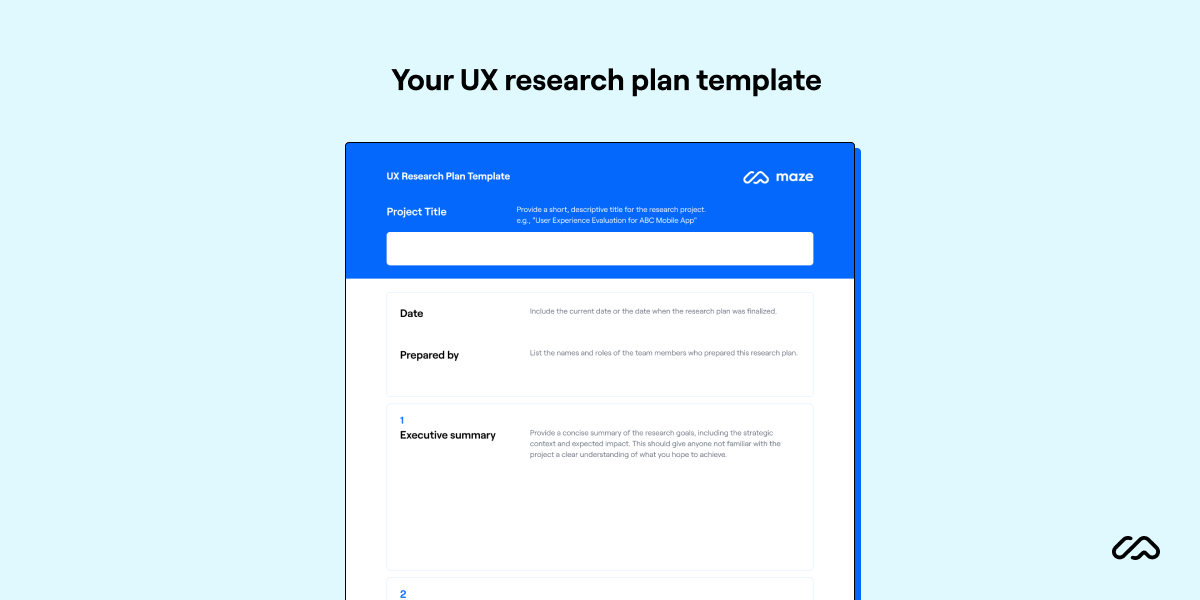
Example: Improving user adoption of a project management tool called Flows
Now, let’s go through how to fill out this template and create a UX research plan with an example.
Executive summary:
Flows aims to increase user adoption and tool engagement by 30% within the next 12 months. Our B2B project management software has been on the market for 3 years and has 25,000 active users across various industries.
By researching the current product experience with existing users, we’ll learn what works and what doesn’t in order to make adjustments to the product and experience.
Research objectives:
| Objective | Description |
|---|---|
| Objective 1 | Identify pain points and areas of friction in the current user experience that stop adoption and engagement |
| Objective 2 | Understand how team members currently use the tool to manage projects and collaborate |
| Objective 3 | Explore desired features, integrations, and capabilities to enhance productivity and team effectiveness |
Purpose of the plan and studies:
The purpose is to gather actionable insights into user needs, behaviors, and challenges to inform updates that will drive increased adoption and engagement of 30% for the B2B project management tool within 12 months.
Target audience, sample size, scope, and demographics:
| Characteristic | Details |
|---|---|
| Target audience | Current customers (teams) using the project management tool |
| Sample size | 20 teams across different client accounts |
| Scope | Full user experience from onboarding to daily use across all tool features |
| Demographics | Teams of 5-15 members from industries like software, marketing, construction, and consulting |
Expectations, deliverables, timings, and type of results:
| Deliverable | Description | Deadline |
|---|---|---|
| Deliverable 1 | User journey maps highlighting friction points | 3 weeks after research study completion |
| Deliverable 2 | Competitive analysis report | 4 weeks |
| Deliverable 3 | Prioritized feature roadmap | 5 weeks |
| Deliverable 4 | Final report with key findings and recommendations | 6 weeks |
Research methodologies:
| Method | Reason |
|---|---|
| Behavioural analytics | Review product stats to uncover friction points that can inform following research |
| Contextual inquiries (8 teams*): | Observe teams using the tool in their workspace |
| User interviews (12 teams*) | 60-min semi-structured interviews |
| Usability testing (5 teams*) | Unmoderated remote usability tests |
*Some teams will take part in more than one research session.
Research analysis methods:
We are doing a mixed methods study.
User interviews are our primary method for gathering qualitative data, and will be analyzed using thematic analysis .
- Quantitative data will be pulled from usability tests to evaluate the effectiveness of our current design.
- Research set up and guidelines:
- Create baselines surveys to gauge current usage and pain points
- Develop interview/discussion guides and usability testing scenarios
- Pilot test materials with two teams
- User interviews: 60 mins, semi-structured; usability tests: 90 mins
- Findings will be presented in a research report for all stakeholders
Research scripts, questions, and samples:
User interview questions:
- What’s your experience with Flows?
- How does Flows fit into your workflow?
- What is your understanding of Flows’ features?
- What do you wish Flows could do that it currently doesn’t?
Usability test sample with Maze:
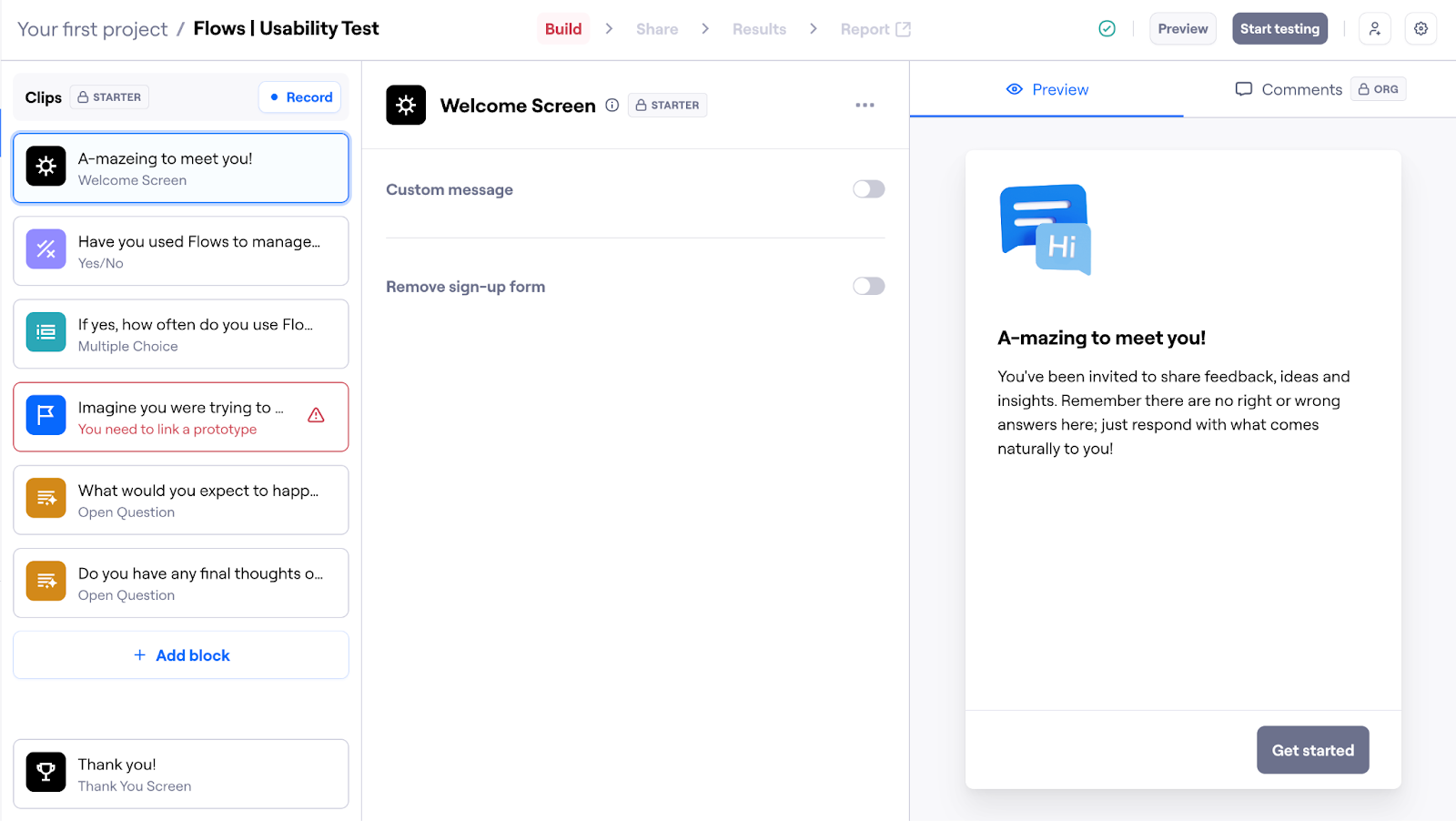
Cost estimations or budget requests/pricing:
Total estimated budget: $8,000
| Item | Estimated costs | Notes |
|---|---|---|
| Participant incentives | $4,000 | |
| Remote usability testing platform | $1,000 | |
| Research tools & software | $3,000 |
More free customizable templates for UX research
Whether you’re creating the plan yourself or are delegating this responsibility to your team, here are six research templates to get started:
- UX research plan template : This editable Miro research project plan example helps you brainstorm user and business-facing problems, objectives, and questions
- UX research brief : You need a clear brief before you conduct UX research—Milanote shares a template that will help you simplify the writing process
- User testing synthesis : Trello put together a sample board to organize user testing notes—you can use this as a guide, but change the titles to fit your UX research purposes
- Usability testing templates : At Maze, we’ve created multiple templates for conducting specific UX research methods—this list will help you create different remote usability tests
- Information architecture (IA) tests template : The way you organize the information in your website or app can improve or damage the user experience—use this template to run IA tests easily
- Feedback survey templates : Ask users anything through a survey, and use these templates to get creative and simplify creation
Everything you need to know about UX research plans
We all know that a robust plan is essential for conducting successful UX research. But, in case you want a quick refresher on what we’ve covered:
- Using a UX research strategy as a starting point will make your plan more likely to succeed
- Determine your research objectives before anything else
- Use a mix of qualitative and quantitative research methods
- Come up with clear personas so you can recruit and test a group of individuals that’s representative of your real end users
- Involve stakeholders from the beginning to get buy-in
- Be vocal about timelines, budget, and expected research findings
- Use the insights to power your product decisions and wow your users; building the solution they genuinely want and need
UX research can happen at any stage of the development lifecycle. When you build products with and for users, you need to include them continuously at various stages of the process.
It’s helpful to explore the need for continuous discovery in your UX research plan and look for a tool like Maze that simplifies the process for you. We’ll cover more about the different research methods and UX research tools in the upcoming chapters—ready to go?
Elevate your UX research workflow
Discover how Maze can streamline and operationalize your research plans to drive real product innovation while saving on costs.
Frequently asked questions
What’s the difference between a UX research plan and a UX research strategy?
The difference between a UX research plan and a UX research strategy is that they cover different levels of scope and detail. A UX research plan is a document that guides individual user experience (UX) research projects. UX research plans are shared documents that everyone on the product team can and should be familiar with. A UX research strategy, on the other hand, outlines the high-level goals, expectations, and demographics of the organization’s approach to research.
What should you include in a user research plan?
Here’s what to include in a user research plan:
- Problem statement
- Research objectives
- Research methods
- Participants' demographics
- Recruitment plan
- User research brief
- Expected timeline
- How to present findings
How do you write a research plan for UX design?
Creating a research plan for user experience (UX) requires a clear problem statement and objectives, choosing the right research method, recruiting participants and briefing them, and establishing a timeline for your project. You'll also need to plan how you'll analyze and present your findings.
How do you plan a UX research roadmap?
To plan a UX research roadmap, start by identifying key business goals and user needs. Align research activities with product milestones to ensure timely insights. Prioritize research methods—like surveys, interviews, and usability tests—based on the project phase and objectives. Set clear timelines and allocate resources accordingly. Regularly update stakeholders on progress and integrate feedback to refine the roadmap continuously.
Generative Research: Definition, Methods, and Examples

- Share on Twitter
- Share on LinkedIn
- Share on Facebook
- Share on Pinterest
- Share through Email
How to Create a UX Research Plan in 6 Steps (with Examples!)
Get the most value out of your research project from day 1.

If you’re a Product Manager without a user research team, are you out of luck? Absolutely not. Though dedicated researchers are truly the dream (I’m biased, as I lead a team of them myself), a user-centric PM can create and execute a UX research plan that answers some of the most crucial questions about users during the product development and product design process.
I’ll walk you through exactly what to do and how to do it—let’s dive in.
How do you know when it’s time to start a user research project?
Before we get into user research tools and the specifics of how to create a user research plan, it’s important to reflect a little bit about when it’s most helpful to conduct user research. Particularly if you’re not a full-time researcher, you’ll want to make sure that you’re investing time in research where it’s most worthwhile.
Here’s a handy chart to guide your thought process about whether or not it’s time to roll up your sleeves and do some research.
| You’re lacking new ideas for features or other initiatives that answer user needs | You don’t have time to make iterations on whatever section of the product you’d like to research |
| You had a highly successful or unsuccessful product initiative and you aren’t sure what you can learn from the experience for future iterations | Your current questions about your users are more because you’re curious and less because you need answers in order to make product decisions |
| There is a disagreement or lack of knowledge on your team about which user pain points or needs are most crucial to solve | You won’t have time to finish up your research before you have to make the relevant product decisions |
| You are working on a new flow or feature and are questioning what the ideal UX is |
Overall, doing user research makes sense when you have a practical reason for doing so and when you have sufficient time to do research and define actionable insights. It also bears noting that skipping user research means running the risk of developing a poorly-designed product .
Now, let’s assume that you’ve put some thought into this and you’re feeling ready to get started. Next is your step-by-step guide for creating a solid user research plan.
Creating a UX Research plan, step-by-step
If you do a quick search, you’ll see that the world is full of many different UX research podcasts , resources, and approaches when it comes to creating a research plan. In my role as a User Research Lead, I’ve found that a short, to-the-point one-pager is the best way to both plan your research in a way that all stakeholders can understand and to leave enough time to, you know, actually do the research. Here are the steps to follow when you go about creating your one-page plan.
Step 1: Align with your team on your research goals
It’s often tempting to start the conversation about user research with methodology—“we’ll do some interviews” or “we’ll conduct a survey.” The truth is, though, that you can’t know what methodology to use, or even whether you want to use a quantitative or qualitative methodology, until you work with your team to define your goals.
Once you’ve defined your goals—in other words, what you want to learn and why—and your whole team is aligned, you’ll be able to start drafting your research plan.

Stay in-the-know on all things product management including trends, how-tos, and insights - delivered right to your inbox.
- Your email *
- By submitting this form, you agree to receive our newsletter and occasional emails related to The Product Manager. You can unsubscribe at any time. For more details, please review our Privacy Policy . We're protected by reCAPTCHA and the Google Privacy Policy and Terms of Service apply.
- Email This field is for validation purposes and should be left unchanged.
My Recommendation:
Get together the smallest, most relevant group of colleagues whose work will be directly impacted by your research. Often, this group includes other product managers, the UX or product design team, product marketing managers, and a representative from senior management on the product team.
Think about what makes sense given your product development workflow and organizational culture and get everyone together.
Consider this meeting a brainstorming meeting where you’ll have the ability to get outside of your own head and hear from other colleagues about what they’d like to learn. Ultimately, since you’re creating the research plan and owning the process, you’ll decide what makes it in and what doesn’t.
Not only does this brainstorming session with your colleagues give you practical information to include in your research plan, but you’ll find that it’s easier to get buy-in for the research process when your colleagues feel that they’re genuinely involved.
When brainstorming with your team, challenge everyone who puts forward a question about users to explain how answering that question will help them make important product decisions. This is a helpful way to whittle down your research goals to the things that will actually have practical, tangible value in the foreseeable future.
Step 2: Write the Story section of your one-page research plan
Now that you’ve brainstormed with your colleagues, and you have all of the information that motivated you to start planning research in the first place, you’re ready to start drafting your plan.
The first section of your research plan should be what is called The Story.
The Story is anywhere from 3 to 6 sentences explaining briefly, in words, what you’re doing and why. The goal of this section is to craft a short narrative such that anyone who reads it knows why you’re doing research and what the expected impact of your knowledge will be.
Let’s look at an example to help you get started. Imagine that your company has a mindfulness app and is planning to build a community feature where people who are interested in mindfulness can interact with each other in a meaningful way. A sample Story may look something like this:
Story Example
This quarter, the product team is beginning an ambitious project to create a mindfulness community within the app. Our goal is to provide genuine value to our users, and we’ll be using metrics in the realm of conversion rate and community engagement to measure our success.
Before we begin creating the product roadmap for the community, the team is going to conduct user research in order to learn more about our target audience and the ways in which our future community can best serve them. This research will allow us to kick off the project by understanding user needs related to the community more in-depth so that we can begin brainstorming product solutions.
Notice that in the Story section, you’re being fairly general in order to give context and background—in the next section, you’ll write out your concrete research goals.
Step 3: Define and write the Scope section of your research plan
After the story, you’ll create your Scope section, which is the section of the research plan where you’ll define your specific research questions. Simply put, this is where you write out, usually in a bulleted list, what exactly you want to learn from your research.
Continuing with our mindfulness community example, a Scope may look something like this:
Example Scope
- Do members of our target audience currently involve others in their mindfulness practice? Why/why not? How?
- Do members of our target audience currently belong to any communities centered around mindfulness? If yes, what are the primary value propositions of these communities? What are these communities lacking, if anything?
- Do members of our target audience have goals related to mindfulness? If yes, how do they articulate them? What’s challenging about reaching those goals? What helps them work toward their goals?
The scope can be longer or shorter than this example, and you can use the syntax that makes the most sense for your team—but the overall idea is that anyone who reads the Scope section of your UX research plan will know exactly what your research questions are and what type of information you’re looking to learn.
Next up, you’ll use your Story and your Scope to decide which research methodology you’ll be using…
Step 4: Define your research methods and write the Methodology section of your research plan
Once you’ve defined your Scope, you can decide which research methods will best help you to answer the research objectives that you’ve defined. There are a lot of decisions to make here, and you’ll likely be asking yourself questions like:
- Should I be doing qualitative research or quantitative research?
- I’ve done usability testing before, but I’m not sure if that’s relevant to the goals of the research – how do I know?
- How many methods should I use? How many research participants do I need?
These are all great and relevant questions—and it’s certainly true that a hugely important part of the research process is choosing the appropriate methodology. Even the most commonly used methods—interviews, surveys , usability testing, and so on—give very different types of information.
The good news is that—even if you’re not yet knowledgeable about which UX research methods to use and when—there are a ton of good user experience research resources out there that can give you some guidance. This guide is a great place to start when it comes to understanding which research techniques will help you with your specific research project.
To understand more about the number of participants to recruit, or how many research sessions to do, for each stage of your UX research project, this article does a great job at defining what to take into account.
Once you’ve defined your methodology, write it out in your research plan. Title the section Methodology and include one bullet point for each method – and yes, it’s definitely possible that you’ll use more than one research method in your research project.
Make sure to define the target research participants for each method.
Here is an example of what bullet points under the Methodology section may look like:
- 10 User Interviews {Current power users who have at least 2 sessions per week for the past month}
- 10 User Interviews {Users who use XYZ competitor app at least twice per week}
You can include other relevant details in this section if you think they’re important to state. For example, will each method be conducted in-person or virtual? Do you want to link to your list of interview questions for transparency about what you’ll ask users if you are doing interviews? As long as the core information is here, you can add details that you think your team needs to align on and/or be aware of.
Step 5: Define and write your Timeline and Budget
Ask any user researcher and they’ll tell you that anyone who gets wind of a user research project will immediately want to know how long it’s going to take. At the end of your one-page research plan, give a target date for when your research deliverables will be ready. Simply, this means: when will you have your research insights and product recommendations ready to present to other stakeholders?
You may want to specifically define your timeline as approximate in your research plan since actually executing research can be somewhat unpredictable. For example, your project timeline may need to be altered depending on how long it takes you to recruit participants, which you can’t always anticipate precisely in advance.
In addition to your Timeline, think about whether it makes sense within your organizational culture to make explicit your Budget for the project in your research plan. If your manager will need to approve your plan and expenses such as paying research participants for their time, it’s a good idea to include it in your plan.
More Articles
The top 10 ux design trends of 2024, 13 brainstorming techniques every product manager needs to know, 10 advanced ideation techniques for product pros, step 6: share your research plan for feedback and final alignment.
Congratulations! You’re finished with the first draft of your UX research plan. It’s one page, it gives all of the necessary context, and it lays out exactly what you’re going to do and when. Just to recap, your very basic UX research plan template is something like this:
Story : Give the general context for this research
Scope : Give a bulleted list of what you’d like to learn from this study
Methodology : List which research methods you’ll use and with whom
Timeline : Give an approximate timeline for your research and tell everyone when you plan to deliver your results
Budget : If needed, define your budget here for approval
The next and final step is to share the main stakeholders with the draft of your plan. Allow comments, and use your judgment as to which user feedback to incorporate (or not). Once you feel that you and your colleagues are reasonably aligned, you’re done! You have your research plan and you’re ready to start doing your user research project.
Executing your research and beyond
Whether this is your first time implementing a user research plan or you have some experience, it’s worth taking a little bit of time to reflect on some best practices right before you get started.
Here are some tips and tricks to keep in mind as you move forward:
- Never Stop Learning: Remember that if you’re unfamiliar with a specific method, there are a ton of online resources. Carve out some time in your calendar to fill in knowledge gaps as needed throughout the research process.
- Over-Communicate: Update your team from time to time as your timeline evolves. It’s inevitable that something won’t go precisely as planned, and that’s usually fine as long as you communicate any timeline changes to the relevant stakeholders.
- Don't Fear Change: I'm not referring to jumping on a hip new UX design trend —I'm talking about the need to pivot when your research isn't going as you hoped. Don’t forget that your research plan can be altered. If you start doing research and realize that you aren’t achieving saturation with your current sample size, or that you need to add an additional research method in order to get the insights that you need—that’s totally fine! Most user researchers experience this from time to time. Do what you need to get the job done.
- Focus on Value: The format of your deliverables depends on your organizational culture but ultimately, everyone wants actionable insights to come from every user research project. Good research is research with practical value, whether it’s delivered as a research report or a presentation.
User experience research is transformative— lean into it!
It can feel overwhelming to initiate and execute user research projects among all of your other tasks, but hopefully, now that you’ve drafted your one-page plan, you feel that it’s more manageable. Most product and UXR professionals who have leaned into user research and integrated it into the product development process describe it as transformative for themselves, the product, and their team members. It’s invigorating to learn from your users and to use your research findings as a starting point for key product initiatives.
As your user research journey continues, be sure to subscribe to The Product Manager newsletter , which is one of my favorite sources for new and timely advice when it comes to user experience research.
Happy researching!

How to Create a Practical User Research Plan

A user research plan usually describes the written form of critical elements of an upcoming research project. The plan contains particular elements around the research subject and the project’s objectives and is often created at the beginning of a new project. But isn't this just paperwork that doesn't really add value? And is it only used to kick-off a new project? How do researchers actually use research plans in their practice?
We spoke with practitioners who plan or conduct research in different settings, from internal enterprise UX research to freelance research for cross-functional teams, to understand the role of research plans in the UXR practice. They shared their perspectives on user research plans and valuable tips to craft good plans. Additionally, you find a user research plan template for your next project in this article, that includes the crucial questions on what to put in a user research plan.
What is a user research plan?
Why write a user research plan at all, how to create the research plan (effectively), research plan template.
A research plan communicates the essential information: what, who, why, when, where - in a written format. A good research plan helps you keep the overarching research goals in mind as you work through how you want to answer your research question(s).
While the research plan is usually crafted at the beginning of a new project, the subsequent use differs: Sometimes, it is rarely used after creation. But in other cases, the plan gets used during research execution and analysis or gets transformed into a final research report.
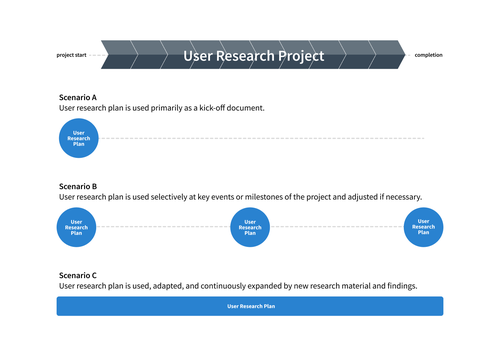
Researchers describe the plans as a crucial point for their research practice. Cordula Hansen , who works as a UX Designer and Developer in the field of Virtual Reality sees it as a moment of focusing on how to get to valuable research output:
„I'm responsible for getting good information from our participants. So making the plan is a really good way of thinking about what we should be doing, what we should be asking, and if we need quantitative research. So obviously rather than having all that in my head, I want to have it on paper and in front of me.“

Research plans (or sometimes also called research designs) are standard research practice, so let’s take a closer look at the benefits of writing a research plan.
Based on our conversations with research practitioners and our own experiences in creating research plans, a UX research plan significantly enriches the project quality and outcomes. These are the main benefits:
Ensure research effectiveness
Creating a plan forces you to think deeply about a research goal and the required steps to learn about the questions you want to uncover successfully. Sometimes you are tempted to go too fast with the risk of overlooking difficulties or finding there is actually no value. A plan can help you anticipate those challenges early and avoid mistakes.
Remain focused
Plans help you to focus on research goals and the research scope during the whole process. We spoke with Srishti Mehrotra , UX Researcher at Airtel, a global telecommunications company. With research plans, she finds it easier to focus on the main topics of interest and describes them as their GPS while researching:
/f/99166/2880x1604/0c84971b9f/srishti.png)
So the plan guides you towards answering the questions you set out to uncover. At the same time, it’s not written in stone, so be open to realigning the plan if needed.
Maximize value from time with participants
A plan helps you get the method, questions, and other administrative tasks ready before speaking to participants. As we all know, finding the right people for a user study is time-consuming and once they do make time for us we want to make the most out of it.
Strengthen team and stakeholder alignment
Research plans support team collaboration and communication. They keep the team informed about the current project. More importantly, a plan helps with expectation setting on research output and timeframe and brings everyone on the same page about the research subject, including your stakeholders.
Build trust in research
Additionally, a research plan can support you in promoting UX research as a discipline in your organization. Introducing a template for research plans makes it easier for everyone, especially non-research colleagues, to get familiar with the research, get into a conversation about it, and this can help gain trust around findings as well. In practice, a UX research plan "skeleton" affects the research perception:
„The more it's repeated, the more people start expecting that particular format. They find it easier to connect back to the same format again and again. So we fill in some of the details, and then we discuss what this is, where we want to plug in the results, and then co-create that plan.“

Every research plan looks different depending on the setting and goals. So instead of showing you what a plan should look like - because we don't know your project - here are some general principles from our research experts that help you develop your own.
Tip 1: Target the outcome (not the method)
When starting with a user research plan, focus on the outcomes. In practice, sometimes, it's easy to get fixated on the methods that need to be applied. But when designing the plan, a focus on the outcome will help you identify the required stepping stones (including the best methods) to get you the type of information you're looking for.
Tip 2: Always adapt the plan’s scope and format
A research plan can consist of some bullet points or a complete strategy document and it varies according to the study and intended use.
In ux research practice, most of the time, no extensive (academic-like) paper is needed. At best, aim for the extent you really need. This means:
What do you (as a researcher) need to come to a thorough research insight or design decision?
Who do you need to get involved in the project? And what information do they need to give their go, get onboard, or use the research insights afterward?
Stéphanie Walter , who works as a User Researcher at Maltem, a global digital transformation and innovation consultancy, describes how the plan’s scope and emphasis need to be adapted, depending on the recipient:
„Sometimes you have to present a research plan to people who don't have a lot of time. That can be tricky. When I was working for a university, it was like: the more detail the better. But if you have to present to stakeholders and need to get buy-in, then you might choose another format, like something short where you're giving the main points, and you have to understand the language of the stakeholders.“

Regarding the research plan format, the practitioners describe that this can be anything from a simple notes document, a presentation, an email to the stakeholders, a paragraph in a research repository tool , to any other format.
The suitable format depends strongly on the role of the plan during the subsequent process. Think of how you want to use the plan during and after the project. For example, using presentation slides eases adding insights and research evidence later on. Or a research analysis tool like Condens enables you to integrate the plan right where you analyze, store and share research findings.
Tip 4: Craft it collaboratively
The process of creating a ux research plan is an opportunity for collaboration with, e.g., product managers, designers, and developers. This will not only strengthen team cohesion but is also the chance to gather required information on research boundaries and dependencies right from the start. Going into that conversation with a draft from an idealistic perspective can be a good conversation starter that will show points that need to be adjusted.
Templates as a basic framework guide your process, create consistency, and ensure you don’t forget essential elements.
All of the researchers we spoke to have crafted their own templates over time. Even if this was not their intention, templates have slipped in as Péter Balázs Polgár , (former) Senior UX Manager at Trustpilot, a leading online review and collaboration platform, describes how their research plan team approach changed: at the beginning, there was a concern that templates would lead to less reflection on user research plans. But that has not proven to be correct, as he goes on:
„We had templates anyway as people were copying and pasting sections from one plan to the next one. So in a sense I think we always had some templates, but they were not like ‘official’ but as we were there, we created official templates.“

So the point of the research plan template is that you can build on existing expertise that will impact all upcoming plans. Some researchers see the plan template as a full shopping shelf that you can go to and pick everything you need for the current research project.
To bring it all together here’s a research plan template, ready to use for your next research plan.

User Research Plan Template
The listed questions will help you to get started by collecting the relevant information for your plan (and, therefore, your research project). Thinking through and entering this information will also help you identify areas to get feedback from your team and stakeholders before conducting the sessions.
Want to read more? Check out our articles about what a UX research repository can do for you and User interview analysis – turning raw data into insights effectively .

Sina is a UX Researcher and Content Strategist at Condens. With a background in social media strategy and digital transformation, she learned how to engage with people in developing products and services and why putting the users in the center will lead to more substantial outcomes and superior user experiences. Sina is excited to drive user research at Condens and to enable better user research for others at the same time by bringing their perspectives into the product development of Condens and by creating valuable content for UX Researchers.

Home > Blog >
How to write a ux research plan that actually works: 7-step tutorial, saviour egbe, august 29, 2023.
A UX research plan is like a map that will help you navigate the complexity of running a research project. It will help you define your goals, choose the right methods, and collect the data you need to make informed design decisions.
But UX research plans don't have to be boring. In fact, they can be quite funny. For example, one UX researcher I know has a section in his plan called " The Things That Make Me Cry ." This is where he lists all the things that he's learned about his users that make him sad, such as the fact that they often have to deal with frustrating interfaces or unhelpful customer service.
But the primary use of a research plan of course is to make sure that your research is effective. So, while it’s helpful to have a sense of humor, you also need to be serious about your research.
In this article, we'll consider:
- What a UX research plan is and why it's important
- How to create a UX research plan
- An example of a well-structured UX research plan and
- A template for a UX research plan you can use to get started
So, whether you're a UX newbie or a seasoned pro, read on for everything you need to know about UX research plans!
What is a UX Research Plan?
A UX research plan is a document that outlines the goals, methods, and timeline for your research. It's a roadmap that will help you stay on track and ensure that your research is productive.
A good UX research plan should include the following:
- A clear statement of the research goals: What do you hope to learn from your research? What are the specific questions you're trying to answer?
- A description of the target audience: Who are the people you're designing for? What are their needs and pain points?
- A selection of research methods: There are many different research methods available, so it's important to choose the ones that are right for your goals and target audience.
- A timeline and budget: How long will your research take? How much money will it cost?
- A plan for data analysis and presentation: How will you analyze your data and communicate the findings to others?
Why is a UX Research Plan Important?
A UX research plan is important for several reasons. It helps you:
- Stay focused and avoids wasting time and resources.
- Ensures that your research is relevant to the needs of your users.
- Get buy-in from stakeholders & align on the goals for the project.
- Provides a framework for organizing and analyzing your data.
- Helps you communicate the findings of your research to others.
How to Create a UX Research Plan
Creating a UX research plan is an important step in ensuring that your product or service is user-friendly and meets the needs of your target audience. Here are the essential steps to create a research plan that drives meaningful insights and successful user experiences:
Step 1: Alignment & Requirements Gathering
Research rarely will happen in a vacuum. Usually you are working with a team—product, engineering, design, for example.
When the need for a research study arises, the first thing you want to do is meet with your team to understand the questions they're trying to answer.
Depending on how formally set up your research practice is, you may even want to supplement this step with a Research Request document where stakeholders can explain the key questions they'd like to answer, why they're important, and any constraints (budgets, timelines) they're working with.
Step 2: Define Your Goals
Once you've gathered your data, the next step is to clearly define & write out your goals. What do you hope to learn from your research? What specific questions are you trying to answer?
Here are some things to consider when framing your goals:
- What are the business objectives for your product or service? Are you trying to grow active users? Or reduce churn? What should the final results of this research project help you do?
- Who are your target users? These are the people you’d like to learn more about.
- What do you want to learn about their behavior and preferences? This will help you determine your research questions. Ideally the answers to these questions should also tie to your business goals so there’s a clear line between what you’re trying to learn and what that learning will do for the company.
Once you’ve thought about and drafted the answers to these questions, make sure to follow the below steps before starting interviews:
i. Assess Internal Data and Identify Research Needs
Before you start collecting new data, take some time to assess any existing data you have. This could include analytics, customer feedback, or previous research findings. This will help you identify any gaps in your knowledge and determine what areas need to be explored further.
Sometimes you’ll find you already have the answer to your research question in-house—saving you weeks of research effort and thousands of dollars of investment!
If you’re trying to build a repository to help you do this more effectively, check out this definitive guide on research repositories .
ii. Link Research Goals to Business Objectives
It's also important to link your research goals to the business objectives of your organization. This will help you justify the time and resources that will be required for your research. By demonstrating how your research will help you achieve your business goals, you'll be more likely to get the support you need.
As a bonus, once your research is complete, you can go back and track its impact against these business goals. This will help you build a case for your own work and the research practice at your company.
As you proceed through Step 1, keep in mind that your research goals should be Specific, Measurable, Achievable, Relevant, and Time-bound (SMART). This framework will help you ensure that your goals are well-defined and actionable.
Step 3: Identify Your Target Audience & Plan a Recruiting Strategy
Knowing your audience is essential for creating a UX research plan that delivers relevant and actionable insights. In this step, we'll talk about how to define your target audience and plan a recruiting strategy for this set of users.
The target audience you’re considering this research study may overlap with your standard target users, or you may want to speak with a subset of this group.
For instance, if you’re doing a research study on why users churn, speaking to a regular active user won’t help. You’ll need to define and recruit users who can actually answer your questions well—in this case it could be “users who have churned in the last 2 weeks”.
When defining the audience for this study, think about whether your target user falls in a specific category based on one of these characteristics:
- Demographics: This includes basic characteristics, such as age, gender, location, and occupation.
- Behaviors and habits: Are you interested in users who have or have not conducted certain actions on your product? For research on how well your Slack integration works, you may want to speak to users who have already installed it, for example.
- Needs and use cases: Sometimes one product can have multiple use cases. For example, a transcription product could be used by researchers, or journalists, or students trying to capture their class notes. Which use case or needs are relevant to your research study?
- Payment type: In today’s world products may have free, freemium / trial, or paid users and each of these groups may behave differently. Think about whether you need one or all of these user types as part of your research.
Now that you know who you need to reach, you also need to think about how to reach them.
Recruiting, as we all know, is a major pain point for (most) researchers. There are some ways to speed it up though.
If you’re running research for a B2C product or an easy to find B2B cohort, you may want to turn to an external recruiting software like UserInterview.com or Respondent.io. There are also local agencies to help you find more local audiences in international markets.
If you are trying to recruit via an external paid channel like this, make sure to budget it in your research plan. These channels are very quick to set up research calls with, but they do come with an added cost.
If you’re running research with a niche B2B audience or are defining your audience based on behaviour on your product (e.g., user who churned in the last 2 weeks), you may need to use internal recruiting methods. This means reaching out to your own users via email, intercom, or via your sales / support team.
If you are recruiting existing customers, make sure to budget in the time it takes to recruit these users. It may take a few days to weeks to gather the relevant user emails and schedule calls, although paid incentives for research help this move much faster.
If you are planning to recruit your own customers, use our Ultimate Guide to Recruiting Your Users for Interviews and Usability Tests . This article has templates for outreach, incentive payment options, and many tactical tips to help you streamline internal recruiting.
Remember, the accuracy and relevance of your research findings depend on the quality of your participants. Take the time to identify and engage users who genuinely reflect your intended audience. This will help you create a research plan that generates insights that drive impactful design decisions.
Step 4: Choose Your Research Methods
Choosing the right research methods is necessary for getting the most out of your UX research plan. Before kicking off your study, make sure to review the possible ways you can answer your research question as well as any constraints you face regarding time, money, or tooling.
If you’re not sure which methods exist, read through this article on UX Research Methods . This article provides an overview of the different methods, so you can choose the ones that are right for your project. It covers everything from usability testing to card sorting, and it includes practical advice on how to conduct each UX research method effectively.
When you’re actually selecting the right method out of the available options, here are the key questions you need to ask yourself:
- Your research goals: What do you hope to learn from your research? The methods you choose should be aligned with your specific goals. For example, if you need to deeply understand user motivations, a user interview is much better fit than a survey.
- Quantitative vs. qualitative: Do you want to collect quantitative data (numbers and statistics) or qualitative insights (in-depth understanding)? Different methods are better suited for different types of data. If you need to know the percentage of users using Zoom vs GoogleMeet, a 5-person user interview won’t get you that data but a 100 person survey with a representative sample might.
- Resources and time: How much time and money do you have to spend on your research? Some methods are more time-consuming or expensive than others. For instance, an ethnographic study where you travel to see your users is obviously more expensive and time-consuming than a 30-minute remote user interview.
By considering these factors, you can choose a combination of research methods that will help you understand your users better.
Step 5: Define your timelines & budgets
Now that you know your target audience (and therefore recruiting method) and your research methods, you can define the timelines and budgets your stakeholders care about.
- Timelines: How long will it take to conduct your research? This will depend on the methods you choose, the number of participants you need to recruit, and the amount of data you need to collect. For example, user interviews can typically be conducted within a few weeks, but usability testing can take anywhere from a few days to a few weeks, depending on the number of participants and the complexity of the product or service being tested.
- Budgets: How much money will you need to conduct your research? This will depend on the methods you choose, the number of participants you need to recruit, and the cost of data collection and analysis. For example, user interviews can be conducted for a few hundred dollars, but usability testing can cost several thousand dollars, depending on the number of participants and the complexity of the product or service being tested.
Step 6: Identify your assumptions
Sometimes without realising it, our research study comes packaged with a set of assumptions about who users are and what they want.
Before kicking off your study, it’s important to identify these assumptions in writing and align on them with your team.
For instance, if you’re running research on how to improve a Slack integration, your in-built assumptions may be:
- Users already use this integration
- It’s worth improving this integration further
Once you’ve laid out these assumptions in advance of your research, you can check them against existing data and keep them in mind when you’re reviewing your research findings.
For example, if analytics data shows that no users use your Slack integration, it may call into question the research you’re running today or change the audience you speak to about it.
Instead of speaking to existing Slack integration users, your audience may need to be companies that have Slack but have not downloaded your Slack integration.
Your research questions may also shift from “Why do you use the Slack integration?” to “Why not? ”
In general, taking a moment to review research assumptions helps you be more aware of them throughout your research study.
Step 7: Define the research questions
This is a pivotal phase in the UX research process. It's when you define the questions that will guide your data collection efforts. These questions will be your compass, directing your research toward meaningful insights that drive product improvements.
Here are some tips for crafting and structuring your research questions:
- Make sure each question is aligned with your overall research objectives. This will ensure that your findings address the core goals of your project.
- Make your questions clear, concise, and specific. Ambiguity can lead to varied interpretations and muddy insights.
- Frame your questions from the user's perspective. Use language that aligns with your target audience to ensure your questions are relatable.
- Avoid leading questions. These are questions that nudge participants towards a particular response. Aim for neutrality to get real insights.
- Use a mix of open-ended and closed-ended questions. Open-ended questions allow participants to provide detailed responses, while closed-ended questions offer predefined answer choices.
- Structure your questions logically, moving from broader inquiries to more specific ones. This will help participants to follow your thought process.
- Limit the number of questions. You want to get comprehensive insights but don't want to overwhelm participants with too many questions.
- Cover the core areas relevant to your project. This could include user pain points, needs, preferences, expectations, and perceptions.
- Pilot-test your questions with a small group of participants. Their feedback can help you to identify unclear or misleading questions.
- Make sure your questions are relevant to the research methods you will be using. For example, usability testing may focus on task-oriented questions, while interviews explore broader experiences.
Here are some examples of well-defined research questions:
1. Usability testing:
- How easily can users navigate the Looppanel account setup process?
- What challenges do users face when uploading their recorded calls to Looppanel?
- How intuitive is the process of setting up Calendar integration on Looppanel?
2. Interviews:
- Can you describe a recent experience you had with the Looppanel customer support?
- What motivated you to sign up for Looppanel for your user research needs instead of other platforms?
- In your view, how does the platform assist in taking your user interview notes effectively?
By carefully defining your research questions, you can ensure that your data collection efforts are focused and meaningful. This will help you to gather the insights you need to improve your product or service and deliver a better experience to your users.
Step 8: Align with your team
Now that you’ve thought through the basics, it's essential to get buy-in from your team and stakeholders on the final plan.
A lot may have happened between your first requirement-gathering meeting and when your plan is finalized. Take the final plan to stakeholders and make sure they are aligned:
- The research question you’re going to answer
- How your study ties to business goals
- Which users you’ll be engaging with
- Which method you’ll be using
- What your timelines look like
- What your budget looks like (if applicable)
This step is really important because if there’s a lack of alignment between you and your key stakeholder, you may end up with findings nobody is going to act on.
Example UX Research Plan
Here is an example UX research plan for improving the onboarding experience of a mobile app. Use this example as a guide to help you create your own plan!
Psst… we also have a template below that you can copy and use!
Project Title: Research study to improve onboarding experience on DuoLingo
Business Goal: We want to increase the activation rate of new users on the app.
Project Goal(s) :
- Identify key drop-off points on the onboarding flow
- Identify why users are dropping off at these points
Target Users: People from the 15-40 age group in North America who have not used Duolingo before.
- MixPanel analytics data to identify existing drop-off points for users
- Usability testing with the think aloud protocol to understand why users are dropping off at those points
Timelines: The study will run for 4 weeks:
- Week 1: Analyzing existing analytics data & recruiting participants
- Week 2: Running usability tests
- Week 3: Analyzing results
- Week 4: Presenting findings
Budget (if applicable): Anticipated spend of $500 on recruiting.
Key Research Questions These are the research questions we’ll be gathering data on :
- At which point(s) in the onboarding process are users most likely to drop off?
- What are the common reasons users cite for discontinuing the onboarding process?
- How do users perceive the clarity of instructions during the initial setup stages?
- Are there any specific usability issues that lead users to abandon the onboarding flow?
- How do users' prior experiences with language learning apps impact their expectations of DuoLingo's onboarding?
UX Research plan template

We’ve also created a UX Research plan template you can use easily duplicate and use for your own work.
Click here to get Looppanel's UX Research Plan template.
This template contains sections for:
- Project Title
- Business Goals
- Project Goals
- Target Users
- Research Methods
- Timelines & Budgets
- Key Research Questions
Follow us on
Get the best resources for ux research, in your inbox, related articles.

Resources & Guides
April 21, 2023
15 Best UX Research Tools for User Researchers, 2024

August 1, 2023
How to Choose the Right UX Research Method

November 8, 2022
A Definitive Guide to the UX Research Repository [2024]
Looppanel automatically records your calls, transcribes them, and centralizes all your research data in one place

UX Research Plan Template
Create a strong business case for UX research and streamline your process with the UX research plan template.
Trusted by 65M+ users and leading companies
About the UX Research Plan Template
A UX research plan, also known as a user research plan, is a brief reference document that outlines your research project’s goals, key contributors, important dates, and timelines.
Think of your research plan as a UX-focused kick-off document for your project. The plan offers an overview of the research initiative, encourages well-defined and agreed-upon goals, and acts as a written guarantee that the research will meet these goals.
What is a UX research plan?
When conducting usability testing or user research with a goal in mind, researchers need to plan. UX researchers often present their findings to stakeholders, like product managers, developers, marketers, and executives, to act on those results.
You should present your UX research plan in plain language with a single document. Keep your findings clear, collaborative, easily accessed, and digestible to get buy-in for your research and your team’s next steps.
A user research plan typically has up to seven segments:
Project background: Reasons for the study and internal stakeholders involved.
Research goals and objectives: What your teams want to learn, or their ideal research outcome.
Research participants: Who they are and how they’ll be recruited.
Method: How you conducted research, and any other information about how the research will be conducted.
Guides: An interview guide or cheat sheet of instructions and questions to follow during the session.
Duration: A rough timeline of how long the research will take and when the team can review the report.
Other helpful information: Additional resources for your team, such as previous studies, scripts, or results, can inform this new round of research.
Research plans keep your team focused on outcomes rather than getting lost in the details or changing the research goal midway through the project. By the end of the project, UX researchers should feel confident that their questions were answered and presented in both the plan and actual research.
When to use UX research plans
UX research plans are useful for teams who need to decide on questions such as:
What do our customers need? Who is our target persona?
Does the proposed or current design work well for our customers? How can we make it better?
Planning UX research also gives researchers an opportunity to:
Decide what works for your stakeholders, especially the questions they’re trying to answer.
Engage stakeholders and keep them invested in your research results.
Clarify your ideas, problems to be solved, and research approaches.
Treat your research plan as a blueprint for aligning expectations, asking for feedback, or generating enthusiasm and support for increasing the value of user research in your organization.
Create your own UX research plan template
Making your own UX research plans is easy, and Miro is the perfect tool to create and share them. Get started by selecting the UX research plan template, then take the following steps to make one of your own.
Give your team or stakeholders a quick project introduction. You can hop on a video chat with up to 25 team members and remind everyone what you’re trying to achieve. Remember that research proves its value when it satisfies a single objective rather than many. If you seem to have lots of different goals or objectives, avoid overreaching and start fresh: what’s the one customer problem and business problem you’re trying to solve?
Define the user and business problems your research needs to solve. The default sticky notes are simply for inspiration — feel free to edit each of these to fix your own context. If you want your team to focus on this area instead of skipping ahead, you can select the “problem” frame and click the “hide frame” (closed eye) icon that appears in the frame’s menu.
Define your research goals. Ask your team to brainstorm their top three research goals or priorities. Remember that the best research sessions are chasing a single objective, so out of the two to three you note down, ask your team to vote for their preferences. Try Miro’s Voting Plugin to help your team reach a decision.
Draft your research questions. Pick three to five questions with your team or stakeholders that are most important to your research. Aim for no more than 10. The more focused your questions, the more focused your research will be.
Link to useful supporting information as needed. Keep this plan to the point in order to get buy-in. For stakeholders who need more detail, there may be other useful data to link to. If you have previous UX research results or relevant studies, link to them on your Miro Board. You can also import survey data, embed tables and charts , or link sticky notes to external sources .
Dive even deeper into how to conduct UX research – and see examples – in our expert guide to user research .
Why should you use the UX Research Template?
Centralized planning: Centralize your UX research plans in one shared space. This ensures that all relevant information, including research objectives, methodologies, and timelines, is easily accessible in one place, reducing the risk of scattered or lost documentation.
Collaborative research: Multiple stakeholders, including designers, researchers, and product managers, can collaborate on your UX research plan template simultaneously, fostering a more inclusive and collaborative approach to research planning.
Visual representation of research steps: Create diagrams, flowcharts, and visual representations of the research process. This visual mapping helps teams better understand the sequence of research activities, identify dependencies, and effectively communicate the overall research strategy.
Iterative refinement: Provide feedback, comments, and suggestions directly on the UX research plan template. Promote continuous improvement, allowing the team to refine the research plan based on insights and changing project requirements.
Integration with user flows and personas: Integrate with other templates, such as user flows and persona maps. By connecting these elements, teams can create a holistic view of the user experience journey. This integration helps align research activities with the overall UX strategy and ensures a more cohesive and user-centric product design.
How can I ensure that a UX Research Plan remains effective?
Regularly review and update the research plan as project requirements evolve. It's crucial to stay flexible and adapt the plan based on the findings and changing project needs.
Get started with this template right now.
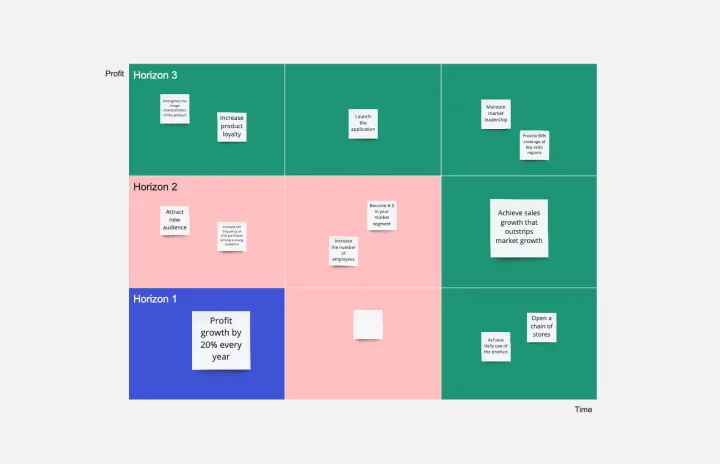
3 Horizons of Growth Template
Works best for:.
Leadership, Strategic Planning, Project Planning
Featured in The Alchemy of Growth, this model gives ambitious companies a way to balance the present and the future—in other words, what’s working in the existing business and what emerging, possibly-profitable growth opportunities lie ahead. Then teams across the organization can make sure that their projects map to and support the organization’s goals. The 3 Horizons of Growth model is also a powerful way to foster a culture of innovation—one that values and depends on experimentation and iteration—and to identify opportunities for new business.

UML Class Diagram Template
UML Class Diagram Template, Mapping, Diagrams
Get a template for quickly building UML class diagrams in a collaborative environment. Use the UML class diagram template to design and refine conceptual systems, then let the same diagram guide your engineers as they write the code.
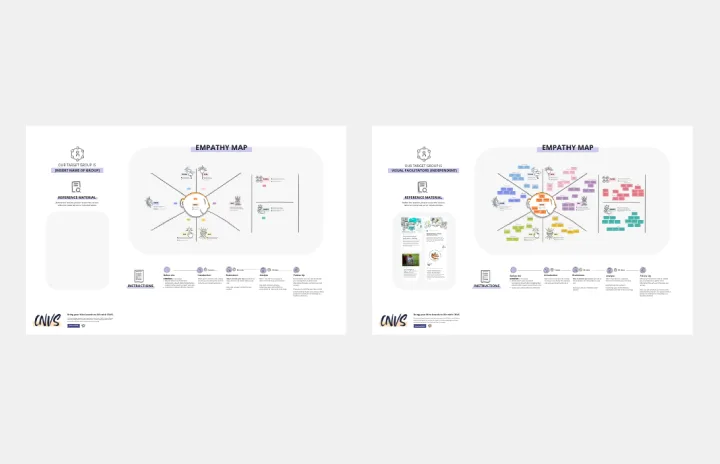
Empathy Map by Lucie Agolini
Research & Design, Market Research
The Empathy Map template offers a straightforward way to visualize user insights. By focusing on what users think, feel, say, and do, you can develop a deeper understanding of their needs. This template is perfect for improving user experiences and driving customer satisfaction.
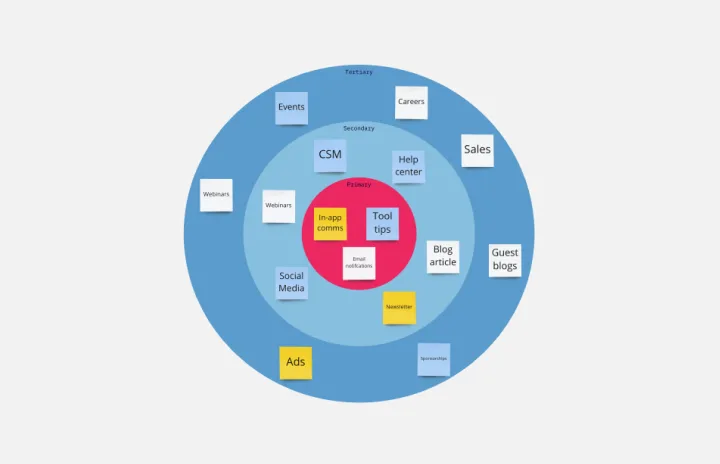
Bull's Eye Diagram Template
Diagrams, Project Management, Prioritization
When you’re a growing organization, every decision can feel like it has make-or-break consequences—which can lead to decision paralysis, an inability to prioritize, inefficient meetings, and even low morale. If that sounds like you, put a Bull’s Eye Diagram to work. True to its name, a Bull’s Eye Diagram uses a model of concentric circles to help companies establish priorities, make critical decisions, or discuss how to remove or overcome obstacles.
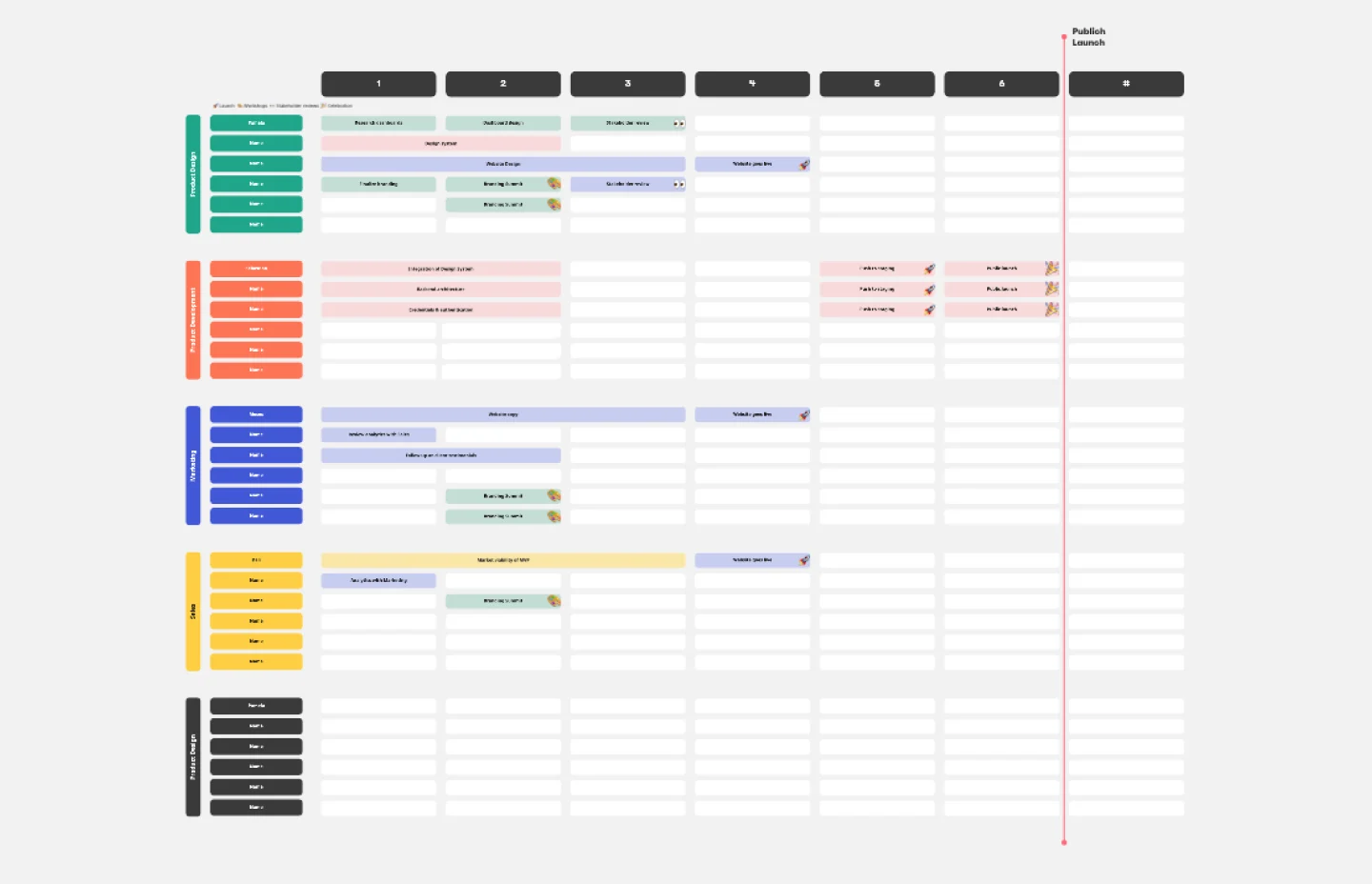
Product Roadmap Template
Product Management, Roadmaps
Product roadmaps help communicate the vision and progress of what’s coming next for your product. It’s an important asset for aligning teams and valuable stakeholders – including executives, engineering, marketing, customer success, and sales – around your strategy and priorities. Product roadmapping can inform future project management, describe new features and product goals, and spell out the lifecycle of a new product. While product roadmaps are customizable, most contain information about the products you’re building, when you’re building them, and the people involved at each stage.
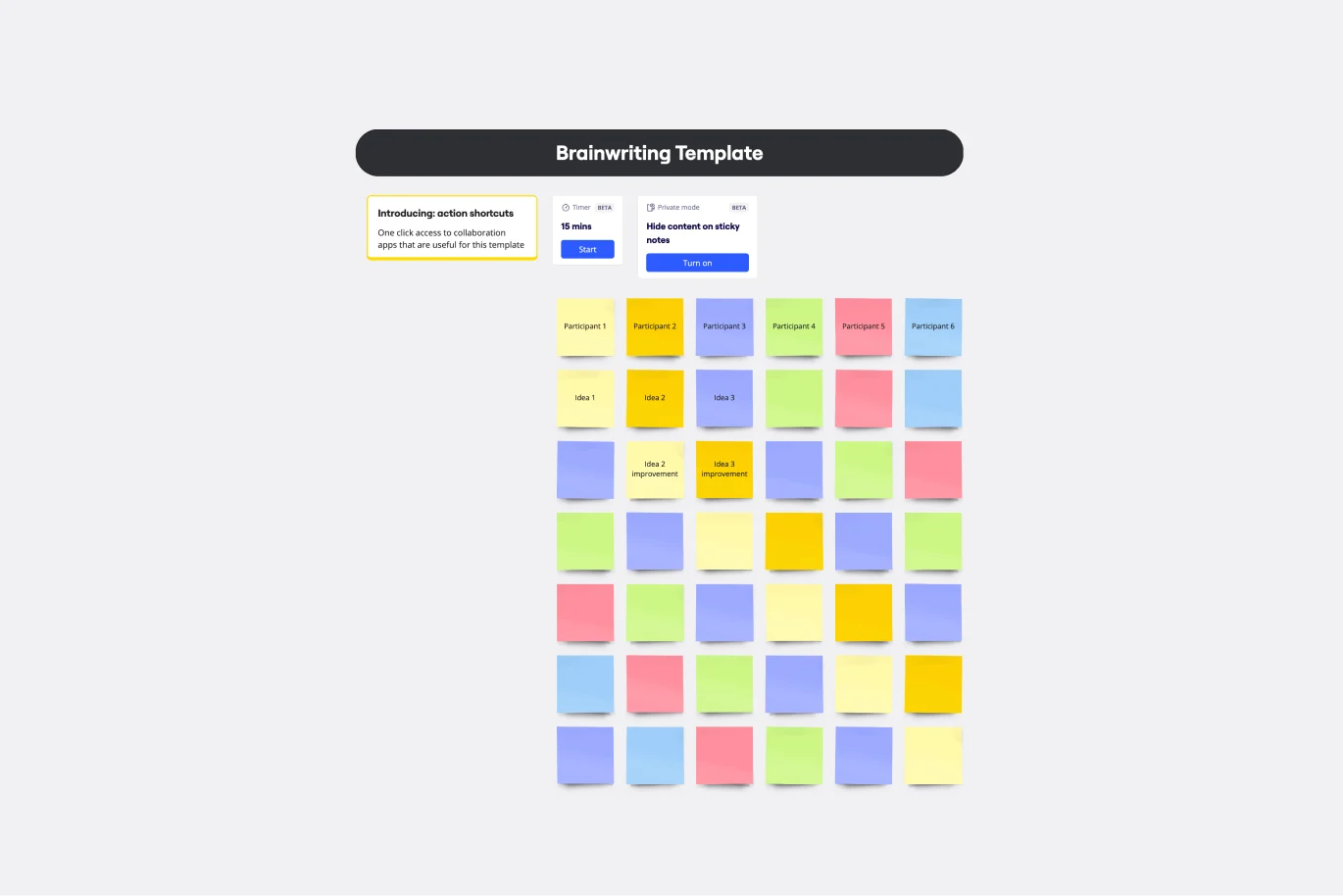
Brainwriting Template
Education, Ideation, Brainstorming
Brainstorming is such a big part of ideation. But not everyone does their best work out loud and on the spot, yelling out thoughts and building on others’ ideas. Brainwriting is a brilliant solution for them—creative thinkers who happen to be more introverted. This approach and template invites participants to reflect quietly and write out their ideas, and then pass them to someone else who will read the idea and add to it. So you’ll get creative ideas from everyone—not just the loudest few.

How to create the best user research plan?
January 13, 2023 3 min read

A user research plan is a detailed and comprehensive document that outlines the strategy and methods for conducting research to gain a deep understanding of the target users of a product or service. It s an essential part of the product development process, as it helps to understand target users’ needs, behaviors, and preferences.
A well-crafted user research plan can provide valuable insights that inform product design and development, ultimately leading to more successful products. It serves as a roadmap for the research process and helps ensure that the research is conducted systematically and effectively.
It’s essential to ensure that the final product meets the needs of its intended users. Creating a user research plan demands a lot of attention, clarity, and smart work. Before we jump to the details, let’s take a look at the benefits of creating a user research plan.
A research strategy will keep your attention on your objective.
It’s absolutely acceptable if your UX research’s objective is ‘to understand your customers better’. However, you’ll need to be more clear about what you want to know about them to know that your study is effective.
Creating a user research plan fosters consensus and gains support.
A solid UX research strategy is a great way to gain stakeholder buy-in and set reasonable expectations for the research process and results. It should meet their goals, connect research to business objectives, and concisely summarize the methods and logistics involved.
You can avoid common research hazards by using a research strategy.
No-show participants, an excessive number of participants who don’t meet your criteria, an insufficient number of participants — overall, technical issues, overbooked schedules, mountains of badly structured data, problems delivering incentives, and unread research reports can be avoided with a well-crafted user research plan.
If you have read so far, I’m assuming you have all the right reasons to continue reading until the end. User research plans are not hard to create; take an extra bit of focus and honest answers. So let’s discuss the steps and best practices for creating a user research plan.
Define the goals and objectives of the research
The objectives, in essence, drive the entire project. Your research objectives should address all that you want to learn from the project and how you will study the problem statement. This step helps to ensure that the research is focused and aligned with the overall product development goals. The research goals and objectives should be specific, measurable, and attainable.
Identify the target audience
This step involves determining who the research will be conducted with, including demographic information and user characteristics. It is important to ensure that the target audience is representative of the intended user base for the product. It’s also important to consider the diversity of the target audience, for example, age, gender, culture, disability, etc.
Choose research methods
There are various research methods that can be used, such as interviews, surveys, usability testing, and diary studies. Each method has its advantages and disadvantages, and it is important to choose the most appropriate method for the research goals and objectives.
Develop a recruitment plan
Once the research methods have been selected, the next step is to develop a recruitment plan. This step involves determining how participants will be recruited for the research. It is important to ensure that the recruitment process is ethical and that participants fully understand the nature of the research and what is expected of them.
Create a research guide
Writing an interview guide ensures that everyone on the team has a place to enter their questions, even if you don’t actively refer to it. Additionally, if you’re planning questions or prompts for unmoderated research, making them accessible to the public for reference enables your team to let you know if anything is unclear. The research guide should also include instructions for conducting the research and any necessary materials, such as consent forms.
Build a research plan timeline
No matter how you look at a project, it is very important that a rough schedule of when the research will be conducted and when a report can be anticipated. It allows you to plan research sessions, debriefings, follow-ups, and deliverables and helps you set expectations for the end results.
Test and refine the plan
This step involves conducting a pilot test of the research plan to ensure that it is effective and to make any necessary adjustments. This step also helps to identify any potential issues that may arise during the research, such as unclear instructions or questions that are too difficult to understand.
Schedule and execute the research
This step involves coordinating the logistics of the research and conducting the study with participants. It is important to ensure that the research is conducted professionally and ethically.
Analyze and report the findings
This step involves carefully reviewing and analyzing the data collected and creating a report that clearly communicates the key findings and recommendations. The report should be presented in a way that is easy to understand and actionable for the product development team .
Incorporate findings into product development
The final step is to incorporate the findings from the user research into the product development process. It is important to ensure that the research findings are communicated clearly and effectively to the relevant stakeholders and actions are taken to address any issues identified during the research.
Creating a user research plan is basically creating a research project in miniature — it can be one of the simplest ways to demand feedback, expectations, and support for your project. A solid research plan can go a long way toward guaranteeing a solid research project.
Creating a user research plan involves:
- Defining the goals and objectives of the research
- Identifying the target audience
- Choosing research methods
- Developing a recruitment plan
- Creating a research guide
- Building a research plan timeline
- Testing and refining the plan
- Scheduling and executing the research
- Analyzing and reporting the findings
- Incorporating findings into product development
Featured Image
- User Experience
- UX Research
- #research strategy
Generative research: A complete guide to running…
User journey vs. user flow: Understanding the…
Get the latest market research insights

How to Create a User Research Plan?
- Bartek Dziegiel
What is a User Research Plan?
A user research plan is a document that outlines the goals, objectives, and logistical considerations of a research project.
A well-written user research plan ensures that the research focuses on the right research questions and that the findings are collected systematically and rigorously. This approach helps ensure that the research findings are reliable and actionable and can be used to improve the user experience.
Why is creating a user research plan essential?
Here are a few reasons why having a well-defined research plan before conducting the study is important:
- It helps to ensure that the research focuses on the right questions. By developing a research plan, you can identify the best questions to answer about your users. It will help you to collect the most relevant data and to make the most of your resources.
- It provides a structure to your study. To gather reliable and trustworthy data, you need to collect it in a rigorous and systematic manner. A research plan should outline your research methods and data collection procedures. Data collected this way will provide reliable insights on which you will be able to base your design decisions.
- It helps with communication across teams. A research plan should also include a section on how you will present the research findings to your stakeholders. I would ensure that your stakeholders understand the findings and that they can use them to make informed design decisions.
What Benefits Come from Using a User Research Plan?
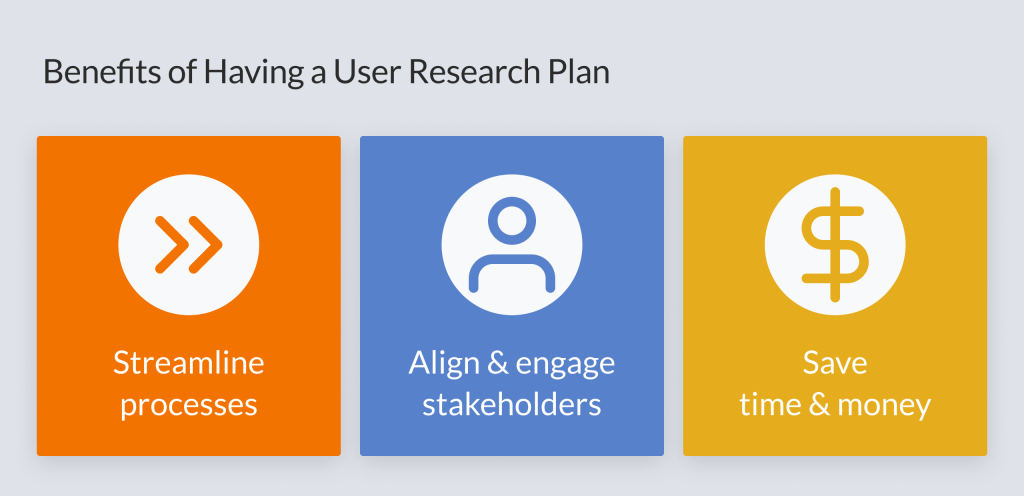
A well-executed user research plan can provide a number of benefits for the entire development project:
- Streamline processes and add structure – a well-written user research plan provides a clear plan for conducting your research. It makes researcher define their goals and establish their methodology from the very beginning. This approach helps to simplify or even eliminate unnecessary tasks related to organizing the study. As a result, it can make the entire process more efficient. It also ensures that you are collecting the right type of data and that your findings are relevant to your goals.
- Align and engage stakeholders – a user research plan helps align and engage stakeholders in the research process. User research plan in the form of a document or presentation will be shared with stakeholders. It is an important step that will allow researchers to get the support of the stakeholders and ensure that they are aware of the goals and objectives of the research. It helps avoid misunderstandings and ensures the research findings will be valuable to the project.
- Save time and money – having a plan provides an overview of the entire study before it begins. It can help researchers to avoid rework and make better use of their time and resources. In the long run, it can lead to significant cost savings.
What User Research Plan Should Include?
A user research plan should include the following key elements:
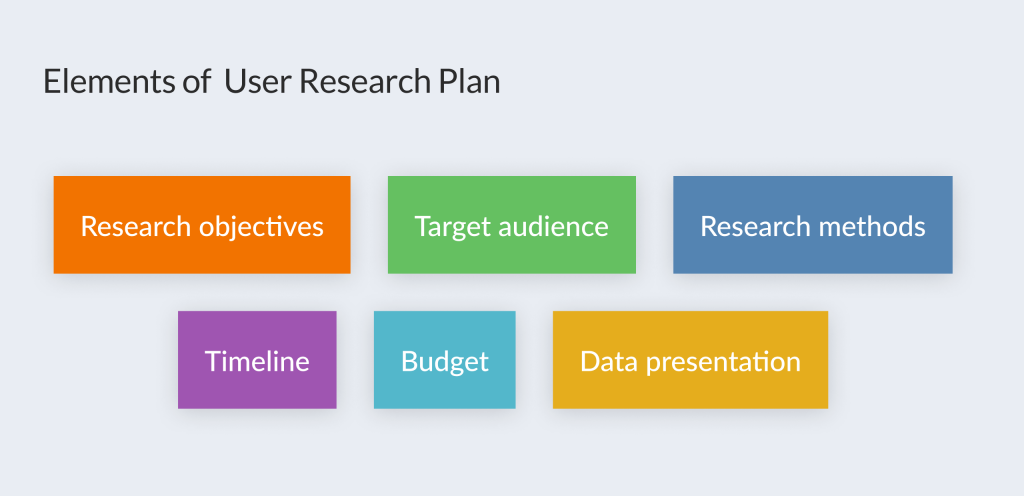
- Research objectives: The most crucial element of the research plan is to define clear research goals at the project’s outset. Research goals will shape the entire study. It is key to ensure you are collecting the most relevant data. Your research objectives should be specific, measurable, achievable, relevant, and time-bound.
- Target audience: The target audience of your project must be identified. Characteristics like their demographics and abilities must be established beforehand. Once you understand your target audience, you can develop research methods tailored to gather the most valuable data. It may also make the recruitment process easier.
- Research methods: There are a variety of research methods that you can use in your user research plan. Some standard methods include user interviews, usability testing, surveys, and focus groups. The best research methods for your project will depend on your specific research objectives and target audience.
Here are some additional elements that you may want to include in your user research plan:
- Timeline: Develop a realistic timeline for your research project. This will help you stay on track and communicate with your stakeholders better.
- Budget: Consider a budget in your user research plan. You must ensure you have the resources necessary to conduct your research effectively.
- Data presentation: It may also be beneficial to consider how you will present your research findings to your stakeholders. Outline the specific communication channels you will use and the key messages you want to convey.
By including these elements in your user research plan, you can ensure that your research is well-organized and likely to produce valuable insights.
How to plan a user research study?
Once you clearly understand your research goals and questions, you need to develop a plan for conducting your research. This plan should outline the specific methods you will use, the participants you will recruit, and the timeline for your study.
The steps outlined in this paragraph will help you develop a comprehensive and well-thought-out user research plan.
Step 1: Identify your research goals
What do you want to learn about your users? What questions do you have about their needs, motivations, and behaviors? Once you have a clear understanding of your research goals, you can develop specific research questions.
Step 2: Choose your research questions
Your research questions should be specific, measurable, achievable, relevant, and time-bound. They should also be aligned with your research goals. For example, if your research goal is to understand how users are interacting with your new product, your research questions might be:
- What tasks are users trying to complete with the product?
- What are the biggest challenges that users are facing?
- What features are users using the most?
- What features are users not using at all?
You can learn more about user research questions in this article.
Step 3: Gather available data and existing insights
Before conducting user research, gather as much available data and insights as possible. This data will put your research in context, further sharpening the focus of your study. You may collect this data using the following methods:
- Stakeholder interviews: Talk to people who have a good understanding of your users, such as product managers, customer support representatives, and sales representatives.
- Secondary research: Look for existing articles and reports of research studies that have already been conducted on your target audience and that answer your research questions.
- Analytics and customer feedback: If you are working on an already launched product, analyze your website analytics and customer feedback data to identify trends and patterns.
Gathering this preliminary data can help you to refine your research questions and to choose the most appropriate research methods.
Step 4: Select the suitable research method
You can choose from various user research methods, such as user interviews, usability testing, surveys, and focus groups. The best research method for your project will depend on your specific research goals and target audience. The few most popular research methods are:
- User interviews: User interviews are a great way to get in-depth feedback from individual users. They can be conducted in person, over the phone, or online.
- Usability testing: Usability testing is a way to observe how users interact with your product or service. It can be conducted in a usability lab or remotely.
- Surveys: Surveys are an excellent way to collect data from a large sample of users. They can be conducted either online or in person.
- Focus groups: Focus groups allow to get feedback from a small group of users on a specific topic. They are typically conducted in person.
There are many more different research methods that researchers can tap into. They will be described in detail in another article on Talebook Blog.
Step 5: Recruit study participants
Once you have selected your research methods, you must recruit study participants.
You will recruit participants that belong to your selected target audience. Obviously, if you are researching a new product targeted at young adults, you will need to recruit young adults (from various backgrounds) to participate in your study. By using screener surveys, you can ensure that participants have the characteristics required for your study.
You can recruit study participants through a variety of methods, such as:
- Social media
- Email lists
- Paid recruitment platforms
- Word of mouth
It is important to offer incentives for participation. Consider this in your research plan and align it with your research budget. An incentive could be as simple as a gift card or a discount on your product or service.
Step 6: Create a script or guide for tests
If you conduct user interviews or usability testing, you must create a script or guide to help you stay on track and collect the most relevant data. The script or guide should include a list of questions you want to ask and a list of tasks that you want users to complete.
Step 7: Define the time frame for your study
Defining a realistic time frame for your user research study is essential. This will help you to stay on track and to communicate your expectations to your stakeholders.
Step 8: Share study details
Once you have planned your user research study, sharing the study details with your stakeholders is essential. Share the research goals, research questions, research methods, recruitment plan, and time frame of your study – everything in a single document or in a form of a presentation.
Research Plan Case Studies
Here are some real-world examples of successful user research plans:
- Airbnb: Airbnb conducted user research to understand how travelers searched for and booked accommodations. The research revealed that travelers needed help finding accommodations that met their needs. Airbnb used this information to redesign its website and search algorithm, which led to a significant increase in bookings.
- Spotify conducted user research to understand how people listened to music on their smartphones. The research revealed that people had difficulty finding new music they liked. Spotify used this information to develop new features for their app, such as personalized recommendations and discovery playlists, which led to a significant increase in user engagement.
- Google: Google conducted user research to understand how people searched for information on the web. The research revealed that people were having difficulty finding relevant and accurate information. Google used this information to improve its search algorithm, which significantly improved the quality of search results.
These are just a few examples of utilizing user research to improve products and services. Creating a user research plan ensures that your research is focused and likely to produce valuable insights.
- A user research plan is a document that outlines the goals, objectives, and logistical considerations of a research project focused on understanding the needs, behaviors, and motivations of users.
- Creating a user research plan helps to ensure that the research focuses on the right questions and that the findings are collected systematically and rigorously.
- A good research plan considers sharing findings with stakeholders clearly and concisely.
- A well-executed user research plan can provide many benefits, including improved decision-making, cost savings, and ensuring the design is user-centric.
- A user research plan should include the following key elements: research objectives, target audience, research methods, timeline, budget, data analysis plan, and communication plan.
- To plan a user research study, you should follow these steps: identify your research goals, choose your research questions, gather available data and existing insights, select the suitable research method, recruit study participants, create a script or guide for tests, define the time frame for your study, and share study details.
Implement the insights gained from this article by creating a user research plan for your next project.
By planning your research, you can ensure that you are collecting the data you need to make informed decisions about your product or service.
Further reading
Project Management for User Research: The Plan by Susan Farrell
User research plan template by Taylor Nguyen
Planning UX Research on UserInterviews.com
The User Research and Insights Tool for Design and Product Teams
How to Create a UX Research Plan [Free Template Inside]
Benjamin Franklin once said, “If you fail to plan, you’re planning to fail”. While Benjamin Franklin wasn’t talking about UX research, the statement applies.
Many researchers fail to plan because they assume they understand user research well enough to create a budget, timeline, process, and more. They conveniently forget that planning is the cornerstone of a successful project and expertise is never enough to see anything through.
Creating a UX research plan allows you to leverage multiple perspectives from project stakeholders and teammates. Stakeholders can help you understand where techniques might not work, timelines may be too tight, or budget insufficient to execute a research project.
Research planning prevents surprises that may come up along the way. It reduces cost and helps you determine how each step of the UX research will be executed to ensure success.
In this guide, we’ll lead you through the steps of creating a UX research plan. You’ll also get a free template so you can create your first research plan immediately.
What Is UX Research?
UX research is the study of user interaction to obtain insights that improve the design process. UX researchers study a group of target users to collect and analyze data that leads to user-friendly products.
The primary goal of UX research is to build products for the end-user based on real data not what you think the user wants. When you conduct UX research, you can give your audience the best solutions because you know what they need.
As a UX researcher, you could begin with qualitative research methods to collect data and understand the user’s needs and motivation. Next, you use quantitative measures such as usability testing to test your hypothesis and results.
What Is a UX Research Plan?
A UX research plan is a document that sets expectations and highlights the most important information you need to communicate with stakeholders in a research project. It is usually a collaboration between all stakeholders to ensure it meets the goals and objectives you’ve laid out.
A user research plan acts as a starting point to help you write easily and keep your team focused on the who, what, why, and when of a UX research project.
What Are the Benefits of Planning User Research?
Show Project Sponsors and Senior Executives the ROI of Your Research
In most scenarios, project sponsors do not care about the process or the user research techniques you choose. They want to know what your research will achieve and how much it will cost to execute. A brief research plan lays out the objective of the research and how it will benefit product design.
Engage Stakeholders
A written research plan is also a great way to engage stakeholders and ensure they’re involved with the research project and the results. You’ll also be leveraging the experience of team members who’ve conducted similar research in the past.
Keeps You Accountable
When you write something down, it looks different from what you pictured in your head. It eliminates the risk of missing steps in the process, going above budget, or losing sight of your research objectives. Think of a research plan as a list of checkpoints to make sure you’ve achieved each goal in your research.
Easier to Plug Holes in Your Process
A research plan helps you to learn what works or doesn’t work and questions you need to be asking. As you write down your plan and process, you can find holes and improve your research plan. It makes it easier to focus and prepare for the study.
How to Create a User Research Plan?
1. Write the Background of the Research
The background section should be brief. Tell stakeholders and clients about the recent history of the project, why you’re conducting the research, and what you’re going to accomplish. In a few sentences (no more than five lines of text), everyone should understand the purpose of the study.
The background section should also include the problem statement. A few ways to identify the problem statement include interviews with stakeholders, a deep analysis of the current data, or team sessions to brainstorm.
2. What Are the Objectives of the Research?
You must have an objective before getting in a room with users. The research objective drives all the research questions you’ll be asking participants during the user interview process.
Why are you conducting user research? What problems do you hope to solve? What is the end goal after completing the research?
Getting answers to these questions should be a collaborative effort between stakeholders and team members involved in the project.
3. Define Stakeholders
Who are the stakeholders that will benefit from the results? Research project stakeholders could be employees in sales, customer support, C-level executives, or product teams.
When you’ve listed everyone you think should be involved, set up a meeting to brainstorm ideas and collect input. It’s easier to deliver the right insights when you’re involving the right stakeholders in your project.
4 . Study Existing Solutions
Have any studies been done on this topic in the past? Perhaps your competitors or in-house teammates have published previous findings that will work as the basis of your research? The answers will help you determine where to begin.
If your team uses Aurelius as a research repository , you’ll be able to easily search through past research projects to quickly find information and make Cross-Project Insights and recommendations from past research with your current project.
5. Recruit Participants
After defining the problem and objectives, it’s time to create a participant profile. Choosing the right participants is one of the most crucial parts of a project.
When creating participant profiles start with characteristics such as occupation, age group, geography, and level of engagement with the product. Next, determine the number of participants to recruit for each UX research method.
We advise internal collaboration with all stakeholders such as sales, marketing, and customer support teams to brainstorm a hypothesis on who your ideal user is. Analyze your competitors to see what type of users they have in their audience.
If you have a database, consider looking inwards to customers who already know your product. If you don’t, use a research recruitment platform to find participants.
When recruiting externally, use a screener to hone in on your ideal participant. Is there a particular behavior you’re looking for? A qualifying action they must have taken within a specific timeframe? Do they need to be a certain age? Screeners ensure you’re bringing in the right users for your research.
6. Establish KPIs and Metrics of Success
How will success be determined? What criteria will you use to check milestone achievements? Examples of success metrics include:
- Time on task
- Specific information about the user
- Decisions that the collected data will help you make
- Statistics you intend to create
7. Outline Scope and Focus of Research
Outlining the focus areas leads to efficient research planning. The deeper you’re able to hone in on the specific information you want to collect from the research, the more clarity you’ll have.
8. Write Research Questions
This is the section where you’ll write down the research questions to ask during user interviews. Start by examining what you already know about the problem such as insights from previous research . Find the knowledge gaps and create questions to answer them.
When brainstorming research questions, it’s important to determine if the goal is to create a new design or to fix an existing design.
If your objective is to build the right design, then your questions will focus on observing user behavior and leveraging mental models.
If the goal is to fix an existing design, then you’ll ask questions about usability to improve the current design. Whatever the goal is, aim for open-ended questions.
Here’s a comprehensive list of questions to ask when conducting UX research interviews
9. Determine Your Budget
Budget plays a role in the amount of data you gather and how you conduct research. More budget equals flexibility to outsource to a dedicated recruitment service, run paid campaigns to attract more people, or even increase the incentives for participants.
More money also makes it easier to choose the right UX research methods that translate into quality insight. Conversely, with a small budget, you have to think of ways to stretch your funds such as using zoom over in-person meetings, limiting the number of research participants, or choosing inexpensive research techniques.
10. Establish Project Timeline
Having a timeline for executing the research plan lets stakeholders and clients know how long the research will take. There might be different expectations between what you think the timeline should be versus the client’s expectation.
When establishing a timeline consider the following:
- The scale of the project
- The time needed to collect data for research analysis
- Time for recruiting research participants
- Number of teammates to engage in research activities
- Unforeseen circumstances such as participants showing up late or needing to reschedule for another day
11. Develop Research Protocols
The research protocol is a list of questions and tasks you’ll cover during in-person sessions. It also includes a list of research methods you’ve chosen.
A common practice is to write down the opening and closing statement of your UX interview. It begins with an explanation of the product, research objectives, and how long each interview session will take. In the end, you thank the participant for their time and answer any questions they might have.
Make sure you get feedback from stakeholders on the research questions as well as the following:
- The duration of each session
- Tasks each research participant will complete during usability testing
- A script to guide each session
- How to record interviews and protect participant data
12. Determine the Research Methods
In this section, you’ll discuss the UX research methods you’ll use during the research and explain why you’ve chosen these techniques.
While there are dozens of research methods to choose from, your choices should be informed by your research questions. Some, like A/B tests and surveys, are suited for quantitative research while others like user interviews and contextual inquiries work best for qualitative research .
Learn more about how to choose a UX research method plus options to choose from during user research
13. Choose UX Research Tools
Similar to research protocols, the research tools you choose should be based on your research objectives and questions.
When choosing UX research tools, consider the following:
- Are you recruiting participants internally from your database or externally?
- Is it going to be a usability test?
- Will you conduct interviews via video conferencing?
- How will you store and analyze research data ?
- Are you going to A/B test certain elements for conversion?
- Will you conduct surveys to collect mass feedback?
There are different tools that fulfill each of these objectives. For example, you can recruit participants from platforms like User Interviews and Userbrain . You can build a research repository to store data and get insights with Aurelius . Tools like Optimizely and Crazy Egg are great for A/B testing.
Get a comprehensive list of UX research tools to complete each stage of the research process in this article
14. Draw Insights and Present your Research Findings
This is the final stage when creating a UX research plan. The insights will be determined by the goals of the research. Is the goal to improve an existing product or create a new product? Which stakeholders will need access to the result?
Make sure you document your process and include details about setbacks you faced along the way, methodologies used, and session materials. This way, your team can have an overview to look back on when conducting the next research project.
To get insight from your research data, use Aurelius to analyze dozens of notes, audio/video recordings as well as spreadsheets.
Create a new project in Aurelius, import your data from anywhere, find information quickly with Tags, search for patterns with Keywords, highlight major findings with Key Insights and make suggestions with Recommendations.
Aurelius turns your recommendations and key insights into shareable reports that you can customize as you like. You can share or present your research findings via email, a PDF, or a live link to your report.
Learn More About How Aurelius Can Help You Improve the Research Process
Asides from having a plan of action for research issues, you must have a plan for working with research participants.
A few things to do during the first interaction with research participants include:
- Inform users about the background of the research and what they’re signing up for
- Tell them how you plan to store their data
- Ask for permission to record the process
- Ask for permission to use their data for research purposes only
- Share details about the UX research process
- Tell them the methods you’re using to collect data
If you feel like it’s too much information, remember that it’s better to overshare than to not give sufficient information.
Use a Template to Streamline UX Research Planning
Templates help you create research plans quickly. Think of it as a starting point for your research project. It includes all the essential elements you need to conduct research and communicate your findings.
Go ahead and download our free UX research plan template. Then, use the tips above to fill out the template.
Download our free UX research plan template
How to create a UX research plan

Steven Carr

The concept of research planning can be met with mixed emotions. Some may say that planning delays action. However, a good plan should really do the opposite by providing a clear guide for action and deliverables. In this post, we’ll detail how a well-conceived UX research plan will help streamline your research and foster understanding and engagement from all stakeholders involved.
What is a UX research plan?
A UX research plan can take many forms. It can be a document, spreadsheet, set of slides, or anything else you can imagine as long as it acts as an overview for kicking off the project.
While a UX research plan doesn’t have to be a formal document, it shouldn’t only live in the mind of a single person. Consolidating ideas, milestones, and deliverables together in one, accessible place allows for a guided conversation that has major benefits on the outcomes of a set of research.
What are the benefits of building a UX research plan?
When it comes to user research, it may seem daunting to be too prescriptive when building your UX research plan. After all, how can you account for everything a user might need, say, or want? Nonetheless, it’s important to try, because making progress on your goals is rarely made through random activity. And, there’s nothing wrong with making adjustments as you go.
Even when faced with uncertainty—often compounded by the everchanging world we live in—effective planning facilitates progress.
The benefits of a UX research plan are numerous, but some include:
- Fosters alignment : Rarely does UX research involve a single stakeholder. With a written UX research plan, you can ensure that all team members involved are on the same page, marching toward agreed-upon goals. Not to mention, a plan allows you to spot conflicting interests before you’re too far down the line.
- Engages stakeholders : An effective UX research plan ensures stakeholders are properly engaged with the study and its results. Without a written plan, there’s a greater chance that stakeholders won’t feel invested and may become observers of the research rather than active participants.
- Ensures UX goals are achieved : A UX research plan should clearly map desired outcomes as well as mileposts to define progress. These provide a standard for assessing how the plan is progressing and if adjustments need to be made to keep the plan on track.
Every organization is different, so the teams within them may be responsible for different business goals. This means that there isn’t a one-size-fits-all approach to creating a UX research plan.
In this section, we’ll provide an overview of steps to consider when creating your plan.
A well-oiled UX research plan should include:
- A clear problem statement
- Objectives for the research
- The research method(s) needed to execute the research
- An overview of the participants
- A test plan
- How you’ll present your findings
Let’s get started.
1. Craft a clear problem statement
As with most plans, you should start by clearly identifying and stating the problem that you’re trying to solve. A UX research plan is no different. Your problem statement should be clear, specific, and give enough detail that stakeholders understand what the research is trying to solve.
Problem statements don’t just stem from nowhere. Some great sources for inspiration might be your support team which deals with customer issues on a daily basis, customer reviews on your website, or feedback from social media. Understanding what data already exists—and what you still need to know—is a fantastic starting point for building a strong UX research plan. Let's take a closer look at some of the steps involved in creating a great problem statement:
Defining the problem:
Begin by articulating the issue in a manner that is concise yet comprehensive. A well-crafted problem statement should communicate the essence of the issue succinctly, making it immediately apparent to all stakeholders what the research will address. It’s important that this statement avoids generalities and is rooted in specific user experiences or observed difficulties. For example, instead of saying "improve website navigation," specify "users are struggling to locate the search function on the homepage, which is impacting conversion rates."
Gathering preliminary data:
Before formalizing your problem statement, gather preliminary data to understand the context better. Chat to your customer support team to identify common complaints or challenges users face. Review customer feedback collected through surveys, feedback forms on your website, or direct interactions. Social media platforms can also be a goldmine of user opinions and issues, often providing raw, unfiltered feedback on what users like or struggle with regarding your product or service.
Analyzing existing data:
Analyze the data you’ve gathered to detect patterns or recurring themes. This analysis might reveal that users feel a particular feature is too complicated or that there are barriers to completing a purchase. Such insights help refine your problem statement by focusing on specific user challenges that your research needs to address.
Crafting a detailed problem statement:
With a clear understanding of user challenges, refine your problem statement to reflect these specifics. Ensure it encapsulates the user's perspective, focusing on their experiences and the difficulties they encounter. For instance, if users find an application form daunting due to its length and complexity, your problem statement could be, "Users are abandoning the application form because its length and complex questions create a perception that the process is tedious and time-consuming."
Communicating the significance:
Ensure your problem statement communicates why addressing this issue is crucial for the business or product. Link the problem directly to business outcomes, such as improved user satisfaction, increased sales, or reduced customer churn. This not only highlights the importance of the research but also aligns it with broader business goals, facilitating stakeholder buy-in.
Seeking feedback:
Once you have a draft, share it with key stakeholders—include team members from design, development, marketing, customer service etc. This will help provide new insights, validate the problem’s relevance, and make sure it resonates across all areas of the business. This feedback might prompt revisions that make the statement more inclusives and more robust.
Finalizing the problem statement:
Once you've used that feedback to refine your problem statement, you'll have a well-defined statement that will lead to powerful and useful reseaarch insights.
Once you’ve put together your problem statement, it’s time to define your objectives.
2. Define your objectives
Think about defining your objectives as telling the story of what you’re doing, why you’re doing it, and what you expect to learn from your UX research . The objectives you set should be the driving force behind every task you assign and every question that you ask research participants.
This means it’s important to be specific. Setting clear objectives will help you define the project scope and the questions you have to ask participants to get the information you need. If the scope is too broad, anything and everything becomes a research question—which becomes overwhelming to manage.
If you like to think visually, consider this chart.
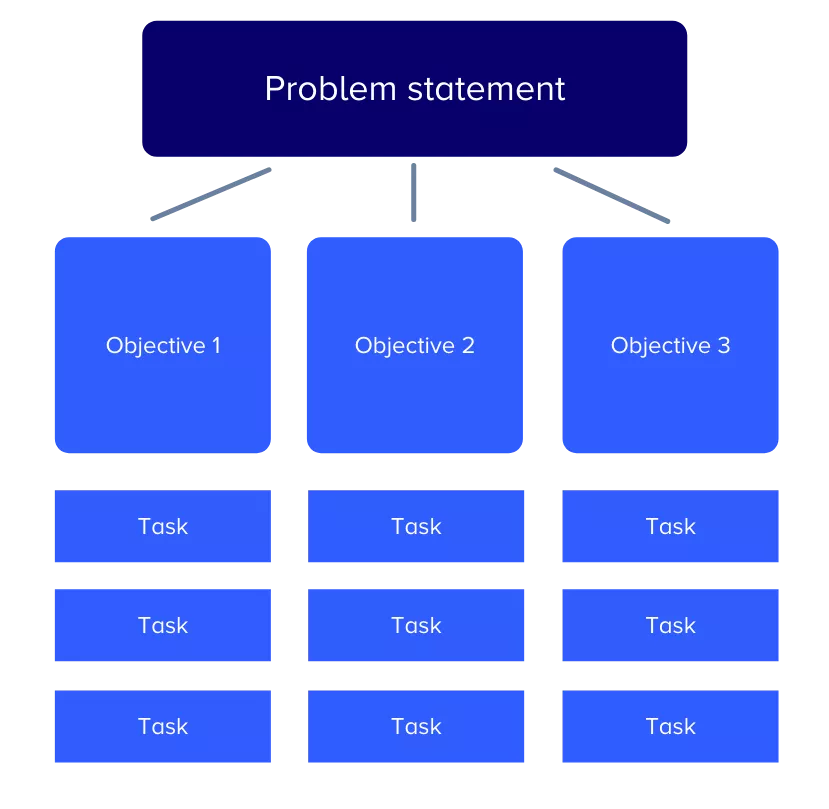
Avoiding the rabbit hole
A well-defined objective keeps you from falling into the rabbit hole of scope creep. Without specific targets, your project can easily grow unwieldy, trying to cover too much ground and diluting the impact of your findings. To avoid this, break down large goals into smaller, focused tasks that you can tackle effectively. For instance, if improving website navigation is your goal, you could focus specifically on enhancing the visibility of the main menu, reducing clicks to reach key content, or improving search functionality.

Using SMART goals
To make your objectives really work for you, frame them using the SMART criteria—Specific, Measurable, Achievable, Relevant, and Time-bound. Here’s how you might apply these to a UX project:
- Specific : Nail down exactly what you want to achieve. Instead of a broad "improve website usability," aim for something like "cut down the time it takes users to complete a purchase by 20%."
- Measurable : Set up ways to measure your success. You could track the average time it takes users to check out before and after you make site improvements.
- Achievable : Keep your objectives realistic, considering the resources and time you have. If user access is limited, opt for in-depth feedback from a smaller user group instead of surface-level input from many.
- Relevant : Tie your objectives to your broader business goals. If increasing online sales is the target, streamlining the checkout process is a no-brainer.
- Time-bound : Put deadlines on your goals to keep the project moving forward. Plan out when you'll conduct phases of research, analysis, and implementation.
Iterative review and adaptation
Objectives aren’t set in stone. As you dive into your research and start gathering data, be ready to tweak and refine your objectives based on what you learn. UX research is inherently iterative, and being flexible allows you to pivot as you uncover new insights or face unexpected challenges. Regularly revisiting your objectives ensures your research stays relevant and aligned with both user needs and business priorities.
By keeping your objectives clear and focused, you make sure that your UX research is effective, impactful, and tightly connected to enhancing user experience. This isn't just about sticking to a plan—it's about making the plan work hard for you, every step of the way.
Start with a problem statement, define the objectives you need to address the problem, then build out tasks and questions that will uncover the necessary information from your participants.
Once you have a clear understanding of what your problem is and how you’re going to aim to solve it, you’ll need to choose the right research method for your plan.
3. Selecting the right UX research method
Next, you'll have to choose the research method that will achieve your stated goals—based on the objectives you've already identified. Before we jump into individual research methods, or the tactics used for conducting UX research, there are big-picture questions that need to be addressed first. And that’s: What types of UX research are there?
We won’t dive too deep into this here, but here’s some additional reading that might help you understand the type of research you’ll need to conduct:
- Qualitative vs. quantitative research : Qualitative methods are all about the 'why' behind user behaviors, giving you insights through interviews, observations, and open-ended interactions. Quantitative methods crunch the numbers—you’ll get stats, percentages, and graphs that show what users are doing at scale.
- Attitudinal vs. behavioral research : Are you looking to find out what users say they do or what they actually do? Attitudinal research focuses on opinions, preferences, and beliefs, often gathered through surveys or interviews. Behavioral research, on the other hand, observes the real actions users take, often in usability tests or through analytics.
- Generative vs. evaluation research : Starting fresh and need ideas? Generative research helps you understand problems and identify new opportunities, perfect when you’re at the drawing board. Evaluation research is your go-to when you’ve got something to test, checking if your designs are hitting the mark or missing it by a mile.
Choosing a method that fits
Now that you’ve got a lay of the land, it’s time to match your research method to your project goals. Here’s how you can ensure the method you pick will deliver the goods:
- Match the method to your objective : If your goal is to understand how users feel about a new feature, a survey might give you broad quantitative data, but in-depth interviews could unveil deeper insights about their feelings and reactions.
- Consider your resources : Some methods, like extensive field studies, can be resource-heavy. Have a think about what’s realistic in terms of time, budget, and available tools.
- Think about the outcome : What kind of data do you need at the end? Numbers that prove a point, or stories that give you direction? Choose a method that aligns with the kind of evidence that will best inform your design decisions.
Mix and match for best results
Often, no single method will tell the whole story. Consider using a mix of approaches to get both the depth and breadth of insights you need. For instance, you might start with a survey to get a general sense of user satisfaction and follow up with interviews to dive deeper into specific issues highlighted by the survey results.Once you understand the types of results you're trying to achieve, make sure that the research method you choose delivers the evidence you need to make informed decisions.
Related reading: The UX research methodology guidebook
4. Select your participants
One of the most important factors that contribute to a successful UX research plan lies in choosing the right participants (and the right number of them). There’s some debate out there over how many participants you should include in UX research, and the right answer depends on what you’re trying to learn.
Figuring out the right number of participants Let’s unpack this a bit:
- The rule of five : Research shows that five test participants will uncover 85% of a product’s usability issues . This is particularly handy when you’re looking to iron out kinks in a prototype or an existing product.
- Looking for trends? Go bigger : If your mission is to catch broader user trends or get data that you can really hang your hat on, you’ll need a bigger crowd. This means pulling in more folks to get that robust quantitative data that’ll make your stakeholders sit up and listen.
Selecting the right participants is more than just filling seats—it’s about ensuring that every voice you hear from can directly contribute to richer, more actionable insights. So take your time, think it through, and choose wisely to make your UX research as impactful as possible.
Ensuring a good fit
Finally, make sure they’re a good fit for what you’re trying to learn:
- Screen effectively : Develop screening surveys or questions that help you verify that potential participants really do match the profile you’re looking for.
- Keep it balanced : Try to maintain a balance in your participant group to avoid skewing your data. If you’re only hearing from one type of user, you might miss out on insights that could be critical for another segment of your audience.
Recruiting the right participants
Finding these people and convincing them to take part in your study is next on the agenda. Here are a few strategies:
- Leverage existing data : Start with what you know. Use your app’s analytics to identify users who fit your criteria, or sift through customer service logs to find people who’ve faced relevant issues.
- Consider your reach : Depending on your resources and the scale of your project, think about how you’ll reach out to these potential participants. Email blasts, social media calls, or leveraging a professional recruiting service can all be effective, depending on your needs and budget.
Matching participants to your target audience
But it’s not just about numbers. Who these people are matters a ton. Here’s how to get the right mix:
- Broad vs. specific : You’ve got two paths here. Either you go broad, casting a wide net to gather a diverse range of insights across a general demographic, which is great for more exploratory or generative research. Or, you get laser-focused, targeting a very specific group of users who represent your core audience or a particular user scenario. This approach is fantastic when your research goals are tightly defined.
- Align with your objectives : Circle back to what you’re aiming to learn. If your goal is to improve the check-out process for a shopping app, your best bet is to zero in on users who’ve abandoned their cart recently. That’s your goldmine for insights.
Defining who your participants should be will require you to go back to the goals you’ve set and the questions that need answering.
5. Build your test plan
There's a certain art to crafting a great test plan. Admittedly, it can take a bit of practice. From moderated user interviews to unmoderated usability tests to prototyping—test plans can take many different shapes and sizes. Lucky for you, our education and research teams have come together to build out this outstanding resource for building test plans.
Check out all of our articles on the UserTesting Knowledgebase for building a test plan .
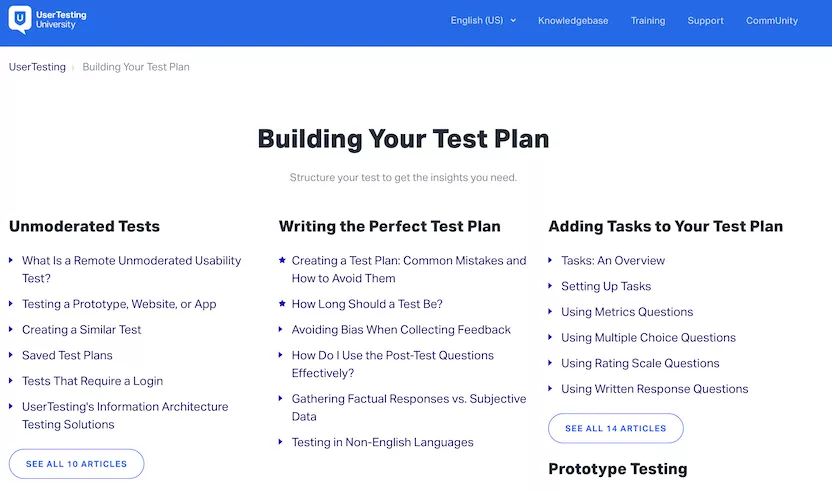
6. Lock in a timeline
Establishing your research project’s timeline is an essential step in creating a UX research plan. Estimating how long the research project will take place and when the findings could be expected are necessary considerations in any project.
Even if not exact, determining an approximate timeline (e.g., 2-3 weeks) will enable you to manage stakeholders’ expectations of the process and the results.
Let’s dive into how to effectively map out the time your research will take and when you can expect to roll out the findings.
Planning your research timeline
Here’s how you can approach it:
- Start with the end in mind : Think about when you need the results and work backward from there. Are there product development deadlines or marketing launches that your research needs to feed into? Pin these dates down first.
- Break it down : Segment your research into phases like planning, recruitment, execution, analysis, and presentation of findings. Assign realistic time frames to each phase based on the complexity of the tasks involved.
Be realistic and flexible
While it’s great to have a timeline, it’s also important to stay flexible:
- Allow for buffers : Research can be unpredictable. Participants might cancel, or you might stumble upon a vein of insights that requires deeper exploration. Build in buffer days to accommodate these uncertainties without throwing off your entire schedule.
- Continuous updates : Keep your stakeholders in the loop with regular updates. If timelines shift, communicate this early and clearly, explaining the reasons and the new expected dates.
Managing expectations
An accurate timeline helps in setting and managing expectations:
- Transparent scheduling : Share your timeline with everyone involved in the project. This transparency helps manage expectations and allows team members to align their schedules and responsibilities accordingly.
- Prepare for adjustments : Be prepared to adjust your timeline based on feedback from interim findings or logistical hiccups. This flexibility can be crucial for maintaining the quality and relevance of your research.
Locking in a timeline isn’t just about sticking to dates. It’s about creating a structured approach to your research that allows for informed planning, anticipates adjustments, and aligns with the broader goals of your project. By taking the time to map out each phase and communicate this effectively, you ensure that your UX research delivers valuable insights in a timely and efficient manner.
7. Present the results
Finally, determining how you’ll present the findings of your project from the start ensures they will be impactful and implemented across the organization. Setting this understanding from the beginning will also determine if all of your stakeholders have been properly identified. It can be frustrating to find out that you need to present to an executive halfway through a project.
Ultimately, for the purpose of your UX research plan, it’s important to choose a presentation medium that’s appropriate for your key stakeholders. Perhaps it’s a UX research report , a set of slides, or even a Jira ticket for your product team; the point is, you want to deliver the information to stakeholders in a way they’re comfortable with—and will be most receptive to.
Using a UX research plan template
So now you’ve built a UX research plan from scratch. While it may seem like an arduous process, we can assure you that it’s well worth your time. Being able to confidently embark on a project with clear deliverables, milestones, stakeholder buy-in, and a plan for presenting results is a major feat—one that will be recognized and appreciated by all of those involved.
Nevertheless, time is money. So once you’ve gone through an entire UX research project, we encourage you to hold a retrospective meeting to identify all the ways you could improve the process. Once you uncover what went well and what can be improved, turn your UX research plan into a template for you and your peers to leverage within your organization.
Need some inspiration for your next UX research project? Check out our list of curated test templates to get you started.
In this Article
Get started now
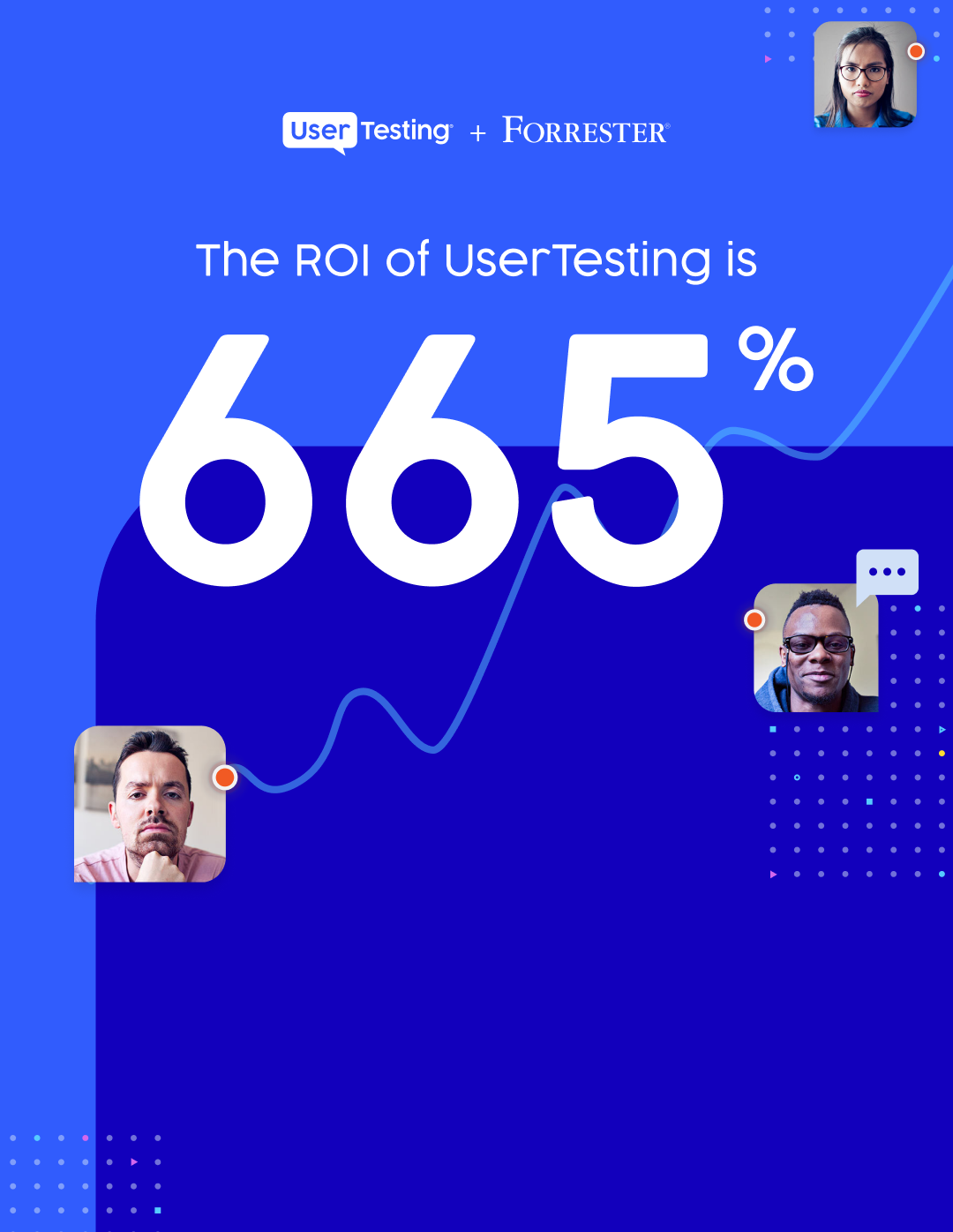
ROI of UserTesting
About the author(s).
Steven is a Marketing Content Strategist. When he’s not inserting oxford commas where they belong, you can find him shooting pool at a local dive or building killer playlists on Spotify.
Human understanding. Human experiences.
Get the latest news on events, research, and product launches
Oh no! We're unable to display this form.
Please check that you’re not running an adblocker and if you are please whitelist usertesting.com.
If you’re still having problems please drop us an email .
By submitting the form, I agree to the Privacy Policy and Terms of Use .
Create a user research plan with these steps
- Usability testing
6 min read Optimal Workshop

A great user experience (UX) is one of the largest drivers of growth and revenue through user satisfaction. However, when budgets get tight, or there is a squeeze on timelines, user research is one of the first things to go. Often at the cost of user satisfaction.
This short sighted view can mean project managers are preoccupied with achieving milestones and short term goals. And UX teams get stuck researching products they weren’t actually involved with developing. As a result no one has the space and understanding to really develop a product that speaks to users needs, desires and wants. There must be a better way to produce a product that is user-driven. Thankfully there is.
What is user research and why should project managers care about it?
User research is an important part of the product development process. Primarily, user research involves using different research methods to gather information about your end users.
Essentially it aims to create the best possible experience for your users by listening and learning directly from those that already or potentially will use your product. You might conduct interviews to help you understand a particular problem, carry out a tree test to identify bottlenecks or problems in your navigation, or do some usability testing to directly observe your users as they perform different tasks on your website or in your app. Or a combination of these to understand what users really want.
To a project manager and team, this likely sounds fairly familiar, that any project can’t be managed in a silo. Regular check-ins and feedback are essential to making smart decisions. The same with UX research. It can make the whole process quicker and more efficient. By taking a step back, digging into your users’ minds, and gaining a fuller understanding of what they want upfront, it can curtail short-term views and decisions.
Bringing more user research into your development process has major benefits for the team, and the ultimately the quality of that final product. There are three key benefits:
- Saves your development team time and effort. Ensuring the team is working on what users want, not wasting time on features that don’t measure up.
- Gives your users a better experience by meeting their requirements.
- Helps your team innovate quickly by understanding what users really want.
As a project manager, making space and planning for user research can be one of the best ways to ensure the team is creating a product that truly is user-driven.
How do you bring research into your product development process?
There are a couple of ways you can bring UX research into your product development process .
- Start with a dedicated research project.
- Integrate UX research throughout the development project.
It can be more difficult to integrate UX research throughout the process, as it means planning the project with various stages of research built in to check the development of features. But ultimately this approach is likely to turn out the best product. One that has been considered, checked and well thought out through the whole product development process. To help you on the way we have laid out 6 key steps to help you integrate UX research into your product development process.
6 key steps to integrate UX research
Step 1: define your research questions.
Take a step back, look at your product and define your research questions .
It may be tempting just to ask, ‘do users like our latest release?’ This however does not get to why or what your users like or don’t like. Try instead:
- What do our users really want from our product?
- Where are they currently struggling while using our website?
- How can we design a better product for our users?
These questions help to form the basis of specific questions about your product and specific areas of research to explore which in turn help shape the type of research you undertake.
Step 2: Create your research plan
With a few key research questions to focus on, it’s time to create your research plan.
A great research plan covers your project’s goals, scope, timing, and deliverables. It’s essential for keeping yourself organized but also for getting key stakeholder signoff.
Step 3: Prepare any research logistics
Every project plan requires attention to detail including a user research project . And with any good project there are a set of steps to help make sense of it.
- Method: Based on your questions, what is the best user research method to use?
- Schedule: When will the research take place? How long will it go on for? If this is ongoing research, plan how it will be implemented and how often.
- Location: Where will the research take place?
- Resources: What resources do you need? This could be technical support or team members.
- Participants: Define who you want to research. Who is eligible to take part in this research? How will you find the right people?
- Data: How will you capture the research data? Where will it be stored? How will you analyze the data and create insights and reports that can be used?
- Deliverables: What is the ultimate goal for your research project?
Step 4: Decide which method will be used
Many user research methods benefit from an observational style of testing. Particularly if you are looking into why users undertake a specific task or struggle.
Typically, there are two approaches to testing:
- Moderated testing is when a moderator is present during the test to answer questions, guide the participant, or dig deeper with further questions.
- Unmoderated testing is when a participant is left on their own to carry out the task. Often this is done remotely and with very specific instructions.Your key questions will determine which method will works best for your research. Find our more about the differences .
Step 5: Run your research session
It’s time to gather insights and data. The questions you are asking will influence how you run your research sessions and the methods you’ve chosen.
If you are running surveys you will be asking users through a banner or invitation to fill out your survey. Unmoderated and very specific questions. Gathering qualitative data and analyzing patterns.
If you’re using something qualitative like interviews or heat mapping, you’ll want to implement software and gather as much information as possible.
Step 6: Prepare a research findings report and share with stakeholders
Analyze your findings, interrogate your data and find those insights that dive into the way your users think. How do they love your product? But how do they also struggle?
Pull together your findings and insights into an easy to understand report. And get socializing. Bring your key stakeholders together and share your findings. Bringing everyone across the findings together can bring everyone on the journey. And for the development process can mean decisions can be user-driven.
Part of any project, UX research should be essential to developing a product that is user-driven. Integrating user research into your development process can be challenging. But with planning and strategy it can be hugely beneficial to saving time and money in the long run.
Published on November 18, 2022

Optimal Workshop
UX research tips, insights and strategies from the team at Optimal Workshop. Got a helpful hint or idea that you'd like to share with our community? Send an email to [email protected].
Recommended for you

How to run fast and affordable usability tests with hard-to-reach, high-earning users
Rounding up participants to test your website or application is a perennial problem for most UX research.

The Evolution of Information Architecture: From Logical and Conceptual Structures to Modern Designs
In many ways, Information architecture (IA) is the backbone of a digital product or service. It is a conceptual structure for information, designed in a way that allows users to navigate and interact with it in a meaningful way. This is done by organizing, structuring, and labeling content that is intuitive for users. IA considers... View Article

Design in the Iron Cage: Part I
Michael Palmyre shares his thoughts on design and the concept of the 'Iron Cage'.
Try Optimal Workshop tools for free
What are you looking for.
Explore all tags
Discover more from Optimal Workshop
Subscribe now to keep reading and get access to the full archive.
Type your email…
Continue reading
Verifying that you are not a robot...
Guides » UX Research Basics » UX Research Plan
Register Now to Beegin Your Journey!
Register Now For Free to Beegin Your Journey!

How to Create a UX Research Plan? (w/Example)
In this guide, you are going to learn how to create a good ux research plan, what it includes and why you should consider having (and following) one..

Last update 11.10.2023
UX research by itself, involves gathering information about target users and their needs in order to provide realistic contexts and insights into design processes. UX researchers apply a range of methods to uncover important facts that can be included in the design process in order to identify challenges and design opportunities.
According to the Interaction Design Foundation (IDF) , UX Research is about discovering insights that will guide effective designs. And, in order to carry out this method efficiently and provide appropriate results, you need a well-thought-out plan.
Table of Contents
What is a ux research plan, why do you need a ux research plan.
- What are the benefits of having a user research plan?
User research plan template
What should your ux research plan include, tips for your ux research plan, examples of a good user research plan, what’s next after your user research plan, ready to get started.
Note: While there are nuances between UX (user experience) research and user research, in this article we will be using UX research and user research interchangeably.
A UX research plan is a document that contains all the important information regarding your planned UX research in one place. It serves as a roadmap for all UX research in your project. It explains the methodology of how the research will be carried out, the types of studies, information about respondents, timing etc.

The goal of creating a plan for UX research is to facilitate the process of managing your UX studies, make it easy for you to keep track of results as well as create a clear research strategy that you can follow.
The amount of information you obtain and analyze during UX research studies may sometimes be overwhelming, so it’s very easy to overlook and even forget important details during the process. Don’t lose track of the bigger picture. A well-maintained UX research plan will store all the key information for you, meaning you can refer to it anytime you need it.
Aside from just saving your memory, there are a number of other advantages to creating a UX research strategy.
Try UX research with UXtweak
The only UX Research tool you need to visualize your customers’ frustration and better understand their issues
What are the benefits of having a UX research plan?
Aside from saving you from keeping everything in your head, a user research plan also has some other significant benefits, such as:
1. Helping you stay focused on the goals
Without a clear plan, it may be difficult to make sure that your user research collects the right type of data at the right moment in time. All information about users may seem important, so it’s easy to get distracted. A crucial part of your plan is defining clear goals that will help everybody involved in the research stay focused and work towards the bigger picture. It assures everybody stays on the same page and helps to avoid going into unnecessary details.
2. Engaging stakeholders in the process
Another big benefit of having a UX research plan at hand is the ability to engage stakeholders in the project . With all the information being stored in one document, it’s easy to update them on the progress, insights, and completed goals.
Describing the objectives of your study in your plan is also an excellent way to demonstrate the value of UX research and keep stakeholders invested in the process. A stakeholder with a focus on specific areas of the project who isn’t up-to-date on all the details will appreciate it if you can point them to past findings relevant to their inquiries or future parts of the roadmap, so they know their concerns are already accounted for.
3. Keeping track of the results
Your UX research plan will function as the roadmap for all the UX research in your project , providing a handy overview of what has already been done, as well as what is yet to be researched. UX research produces a quantum of data, so as time passes it becomes essential to be able to refer to your previous findings and monitor your progress.
Most importantly, a UX plan allows researchers (or whoever else is conducting the research) to concentrate and ensure that they meet the research plan’s objectives in the most effective manner possible .
To save you some time, we created a simple User Research Plan Template which you can copy and adapt to your own research.
It contains everything a user research plan should include. Read the next section, where we will explain in detail what your one-page plan should contain and why.
According to the Interaction Design Foundation, it’s good to start your research from a one-page plan . This way, you’ll be able to keep your plan short, simple, and easy to understand to stakeholders, even if they are people who aren’t completely involved with your study.
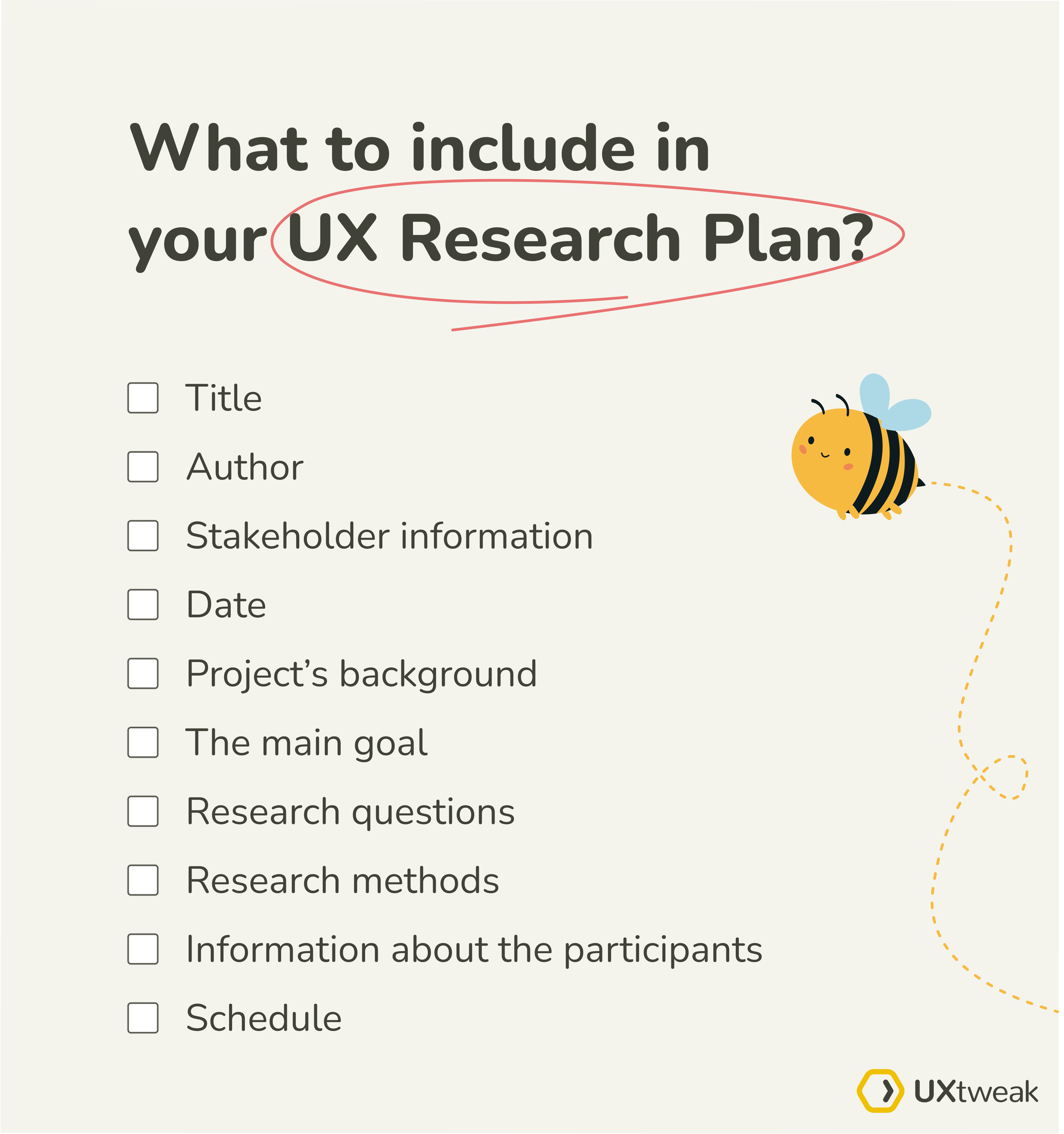
- Title – Every good project needs a name. Include the title of the project you’re working on in order for it to be identified.
- Author – Add the name and contact of the person in charge of executing the plan. You may also include names of other persons to whom readers can send their feedback and inputs about the contents of the document.
- Stakeholders information – Everybody involved in the study and all the people you’ll be sharing your research with. Include their roles and contact details.
- Date – When the project has started. It’s also important to include revision dates so that everybody is aware of all the updates.
- Project’s background – This should be a short summary paragraph where you explain your motivation – the reason why the research is being conducted, what are the problems that need to be resolved, and any other important background information to provide the reader with the required context.
- The main goal – Explain your main objective in 1 sentence. What are you trying to achieve with your research? Keep it short and clear, try to choose a single most important goal instead of a number of small ones.
- Research questions – What are the questions that you’re looking to get answered in your research? Writing them down will assist you in determining the research method you will use, what questions you’ll ask participants during the research, and what you’ll want to focus on while analyzing results. Planning your research questions helps you make sure you don’t forget anything important and that your UX research design corresponds well with your goals. Learn How to ask good questions in usability testing .
- Research methods – There are tons of qualitative and quantitative methods to choose from . Include the ones you’re going to use in your studies, specify if it’s going to be moderated or unmoderated and how long it will take.
- Information about the participants – In this part of your plan, define the target audience of your research (age, gender, potential customers/existing customers…) and specify where you’re going to recruit them. How many participants do you need? Is there one group or multiple segments?
- Schedule – Make a schedule of when each study is going to be conducted as well as an estimation of how long the whole research process is going to take. It’s good to also add milestones to indicate the progress and see when each activity is due.
- Supporting information – if there is any other relevant data that can influence the research project, don’t forget to mention it as well.
Discover our list of best UX Research tools
We reviewed 18 best tools on the market, so you don't have to!

A UX research plan that you and your stakeholders prepare together is key to a successful start of a UX research project. Here are a few things to consider to make you and your stakeholders come to an agreement.
- Gather all your common knowledge, agreements, and understanding of what will occur, why, with whom, and when in a couple of sentences that will represent your main objective.
- Set the right expectations for all stakeholders, and make sure your research plan is focused on the main goal.
- Keep the plan short and simple so that all of your stakeholders can understand it. You can work from a more detailed plan, but for your stakeholders, the Interaction Design Foundation recommends a One Page User Research Plan .
- Make the UX research plan a team effort by incorporating all team members so that everyone understands it.
- The list of questions you’re aiming to answer is at the heart of the user research, choose the appropriate ones and avoid bias.
To give you a better picture of what your plan should look like, we found a great user research plan example on the web. It’s a research study conducted by user researcher Shivang Patwa for the company called “InstaCar”.
This document perfectly describes every step of the research process and provides all the needed information for everybody involved in the study.
Once you’re done with the user research plan consider how you’ll deliver the results of your study to your stakeholders and team. During the session, tell an engaging story and include quotations and videos from your participants to help stakeholders understand the effect of your research. After all is said and done, store your insights in a way that anybody can access and understand at any time. This will guarantee that your research leaves a lasting effect on your team and project.
Now that you’ve finished your user research plan, you can rest comfortably with a strategy for getting information from your users that will help you design your projects.
To get started with your user research, UXtweak is a user research tool that can help you with everything from recruiting participants to running your study. We even have resources to help you get started, such as how to motivate people to attend your research . Create an account today and get ahead of your competitors with quality user research!
Try UXtweak for UX Research!
The only UX research tool you need to visualize your customers’ frustration and better understand their issues
People also ask (FAQ)
When writing a user research plan begin with defining a clear goal. According to the goals, your needs and the budget chose methods and tools that you will use and write down the timeline. Prepare the tasks and questions for the testing. define your target audience and decide on the tester recruitment process.
UX research plan should always include:
- Stakeholders information
- Project’s background
- The main goal
- Research questions
- UX Research methods
- Information about the participants
Remote User Research
Ux research questions, topics: ux research basics.
- 01. UX Research Basics
- 02. Remote User Research
- 03. UX Research Plan
- 04. UX Research Questions
- 05. UX Research Methods
- 06. Quantitative vs. Qualitative Research
- 07. UX Research Process
- 08. UX Research Report
- 09. UX Research Framework
- 10. UX Research Presentation
- 11. UX Research Bootcamp
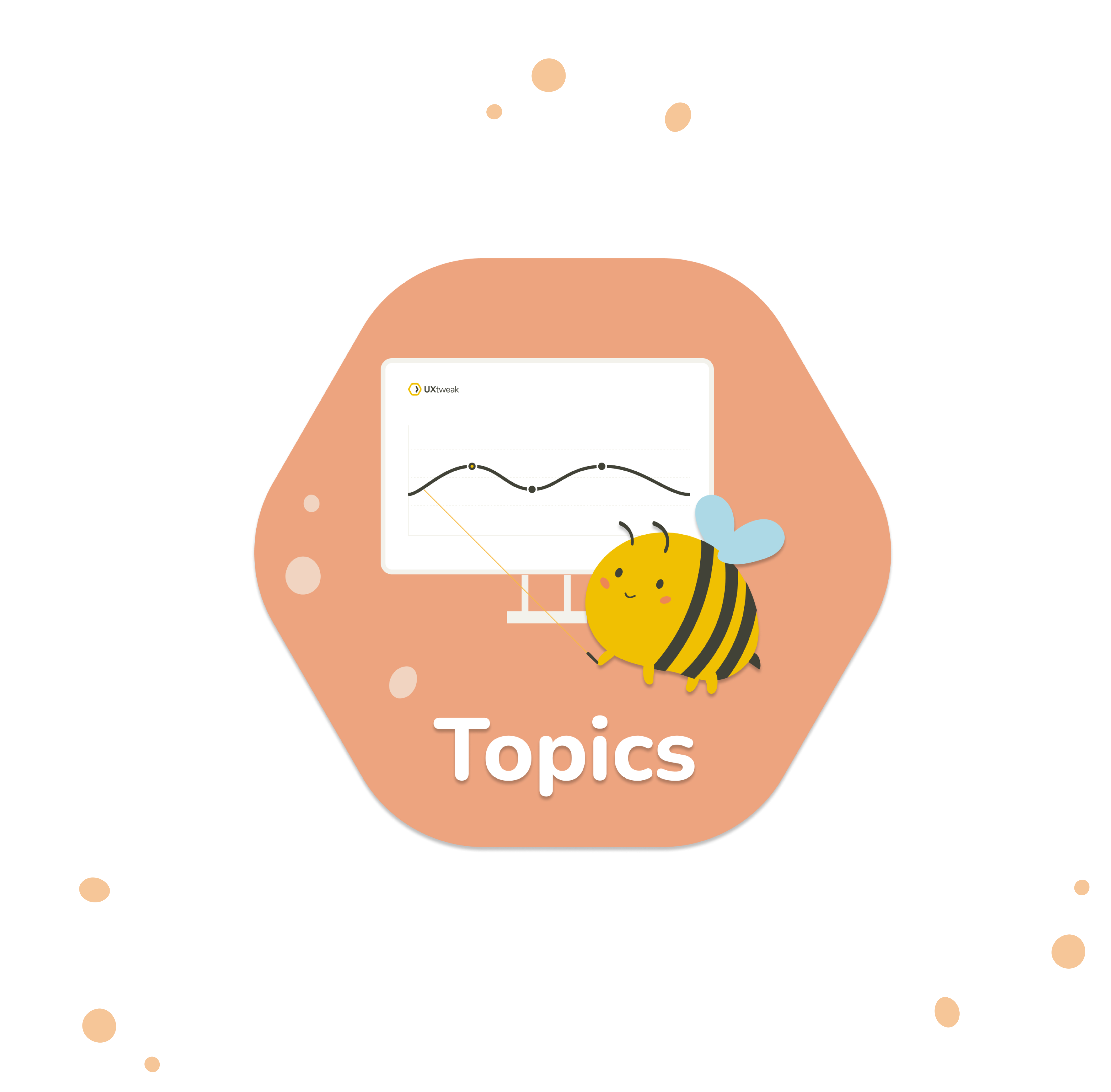
UX Research Basics
Ux research plan, ux research methods, quantitative vs. qualitative research, ux research process, ux research report, ux research framework, ux research presentation, ux research bootcamp.
- Card Sorting
- Tree Testing
- Preference Test
- Five Second Test
- Session Recording
- Freeform Interviews
- Study Interviews
- Mobile Testing
- First Click Test
- Prototype Testing
- Website Testing
- Onsite Recruiting
- Own Database
- Documentation
- Product features
- UX Glossary
- Comparisons
Playback Speed
- 1x (Normal)
Intro to UX Research: Creating a User Research Plan
Nikki anderson, user experience researcher & instructor, watch this class and thousands more, lessons in this class, introduction, what is ux research, what is a user research plan, research methodologies, defining background and objectives, choosing participants, generative interview script, usability test script.
- Beginner level
- Intermediate level
- Advanced level
Community Generated
The level is determined by a majority opinion of students who have reviewed this class. The teacher's recommendation is shown until at least 5 student responses are collected.
About This Class
Do you want to find out what your customers really want and need from your product?
User experience research is becoming more popular in the product and design fields, as a way to gain deep empathy for customers, as well as understanding user’s goals, pain points or needs. User research helps product managers prioritize their backlogs, developers prioritize product improvements, UX designers design the best prototypes and also allows the company to succeed and innovate. But, when tasked with conducting user experience research, where do you start?
There are many articles and videos explaining why user research is important, and common methodologies surrounding the practice, but I want to give you something more actionable. In this class, we will be completing a research plan. What do these bite-sized lessons include?
- Defining research goals and objectives, and tying them back to company goals (very important for stakeholder buy-in!)
- Choosing your target user base for research
- Deciding on research methodologies, based on the aforementioned goals
- Creating a discussion/interview guide (including how to formulate unbiased questions)
- Methods on capturing and sharing results
I will fully explain each step, and why it is important. Examples will be discussed along the way!
This class is ideal for anyone who is currently in a role (or who wants to get into a role) that focuses on creating excellent customer experiences, such as product managers, developers, designers, marketing, innovation teams, and more. No prior experience is necessary.
I would like all students to come out of this class with a better understanding of user research, as well as the confidence and resources to conduct sessions. During this course, we will be working together to complete a full research plan, which will equip you with the knowledge to correctly, and effectively, conduct your own user research sessions. With this, you can start to improve your own product, or help a company solve their user’s problems!
Want to work with me?
Take a look at my mentorship program
Enroll in my Introduction to User Research Course
Sign up for my newsletter!
Find me on:
LinkedIn | dscout | Dovetail | Medium
Meet Your Teacher

Nikki Anderson
User Experience Researcher & Instructor
Hi there, I'm Nikki!
I am a user experience researcher, specializing in qualitative methodologies (I also incorporate quantitative data analysis). I have 5 years of experience in the UX field and 2 years working with/researching patients at a mental health facility during my MA program. I have been teaching user research for over a year! I currently am a Senior UX Research at FromAtoB, and also continue freelance user research projects on the side. I truly care about understanding the implications behind people's thoughts and actions. I have a super power for listening to, both, users and stakeholders, and making relevant UX recommendations (my students and I call this 'nuggetizing' research). I go into each research session with an open mind and empathetic heart.&nbs... See full profile
Related Skills
Hands-on class project.
Create a user research plan based on a current project you are interested in. If you are not currently involved in any projects, use the following prompt when filling out your research plan:
How can we help people form positive, consistent habits to reach their goals?
Your client sees new opportunities emerging in the digital space around how people reach their goals by creating and sticking to positive habits. They want to be top of mind for the whole customer journey—from when people decide on a goal, and the habits it takes to get there, through the time they reaching their goal.
Focus on an age group from below:
18-25 25-35 35-50 50
Choose two goals to focus on from the following list:
- Weight loss/exercise (20 pounds/exercise X times a week)
- Wake up earlier
- Save for travel (save X amount in X time)
- Achieve better grades
- Spend more time with family
- Read X books a month
- Perform a daily act of kindness
- Write in a journal (daily, weekly)
- Write a novel in X amount of time
As we go through this class, you can fill out each section during the video, or wait until the end to complete the entire plan. As you progress, your answers may change, and that is okay! By the end of the course, you will have a fully completed research plan, which will enable you to go and complete your research.
Please take advantage of this wonderful community and post any drafts, questions or your final research plan to the Project Workspace - ask for feedback, it is the best way to learn! Some wonderful questions I ask my colleagues are: “How would you improve this?” “What makes sense? What doesn’t make sense?” “What is something you would change or dig deeper into?”
User Research Plan Template
Usability Testing Plan Example
Generative Research Plan Example
Take a look at my mentorship program
Enroll in my Introduction to User Research Course
LinkedIn | dscout | Dovetail | Medium
Class Ratings
Why join skillshare.
Take award-winning Skillshare Original Classes
Each class has short lessons, hands-on projects
Your membership supports Skillshare teachers
Learn From Anywhere
Take classes on the go with the Skillshare app . Stream or download to watch on the plane, the subway, or wherever you learn best.

How Many Participants Are Enough? Sample Sizes for UX Research

Personas: Improve Your UX with Human-Centered Design
Ash Graydon

Intro to UX: Conducting Smart User Research
Janelle Estes

Introduction to UX Research
Tiffany Eaton
- Affiliate Program
- Partnerships
- Gift Membership Cards
- Corporate Gift Cards
- Scholarships
- Become a Teacher
- Teacher Help Center
- Teacher Rules & Requirements
- Download_on_the_App_Store_Badge_US-UK_RGB_blk_4SVG_092917

Skip navigation

World Leaders in Research-Based User Experience
Project management for user research: the plan.

November 20, 2016 2016-11-20
- Email article
- Share on LinkedIn
- Share on Twitter
In This Article:
Why plans matter, what to include in your research plan, important planning considerations, what to include in your final research plan, what to deliver.
Creating a project plan structures your thinking around the research activity. Plans keep stakeholders involved and informed, while reducing the need for calls and meetings. Documenting your research-project planning can help prevent misunderstandings, unwanted method variation, and unnecessary rework.
A research-project plan is a living document that is shared and updated as needed. After your study, edit the plan to serve as the record of your research method. Plans take the work away from your limited memory and provide a convenient place to keep track of the many documents generated by each project.
The benefits of checklists are well known to people doing complex tasks, such as surgical staff and pilots. Busy people in distracting situations often forget to do something important, despite having many years of experience with a procedure. This checklist is meant to ensure that you don’t overlook any important elements when planning research studies .
In the beginning, your research project plan should include not only the information needed during the actual study sessions, but also various information that the team may make use of beforehand. Most plans should cover:
- Purpose of the plan
- Information about what you will be conducting research on, such as basics about the product, method, and rationale
- Purpose and goals of the research study
- User tasks, metrics, and usability goals, such as maximum time on task and other success criteria (if applicable)
- User profiles (characteristics of target participants for the research)
- Screening questionnaire and recruitment plan (if applicable)
- Expectations about deliverables and timing
- Expectations and roles
- To-do lists
- Note-taking and question-asking guidelines for observers, including how to collaborate in effective data gathering without biasing the sessions
- Facilitator script with questions for participants, including user scenarios (if applicable) and consent forms
- Location information and contact details
- Test setup, including equipment and supplies
- Get stakeholders’ signoff on plans, so everyone understands what’s in scope and how you will meet the research goals . Provide written goals, user profiles, tasks, and participant scenarios as soon as possible, so any concerns and questions can be discussed well in advance.
- Research participants can sometimes be controversial, so keep stakeholders informed periodically by sharing the details of the recruits as they are scheduled. But don’t include participants’ names and identifying information in plans — use numbers (P1, P2, etc.) instead to preserve their privacy. If screening criteria need to be adjusted during recruitment, having this shared understanding can make rapid changes easier to accomplish.
- First, consider the schedule for research sessions, building in time for pilot session(s), lunches, and debrief and regroup time between participants, so you can have solid appointment times for recruitment.
- Choose the location where you will conduct the research. Gather logistic information (such as maps, nearest hotels, and travel contacts) to help the research team have a great experience.
- Arrange any needed onsite support , such as IT staff, equipment, chairs, desks, tables, catering, beverages, and snacks.
- Decide how to compensate study participants. If you will pay them directly at the time of the study, plan to obtain the needed cash, gift certificates, or checks.
- If you have observers , consider how many you can accommodate and how they can best help with data capture.
- Make a checklist of items needed for a user study.
- Share contacts , including everyone’s mobile phone numbers for urgent issues.
- Consider information sharing : when and how to disseminate information during and after the study.
- Consent forms are required for all participants in order to inform them of the purpose of the study and get their agreement in a way that protects everyone legally. The exact wording may require approval in advance by stakeholders and any businesses you may visit for the research. Include at a minimum: what the study involves, who is conducting the research, why you’re doing it, the date, any incentive paid (phrase this part to double as a receipt), which information will be collected and how (including recording details), and which information will be shared with whom (including any NDA requirement).
- Provide tips for observers . Coach people in what to look for, how to take good notes, and how best to participate without interrupting. Set expectations about what to do and not do, and explain why that’s important to the research. Print observer guidelines to help everyone stay on track.
- Plan data capture, analysis, and reporting . Consider carefully how you will analyze the data and report it. Then plan a data-capturing method (and a fallback method) that meets your needs. Consider the abilities of the observers, the situation, and concerns of your participants. Plan to keep data confidential, and identify who will be responsible for protecting it appropriately.
- Make a Plan B . What could possibly go wrong? Don’t assume that you’ll be able to record audio or video, even if that’s the plan. Plan around not being able to print, get text messages, or use your devices. Decide what to do if anyone runs late or cancels at the last minute.
- Thank the participant.
- Introduce yourself and explain why you are doing the study.
- Set expectations for how the session will proceed.
- Get consent from the participant in writing.
- If applicable, give the participant the compensation for the study.
- Go over any instructions and, if you’re using a think-aloud method , read the think-aloud instructions to the participants and maybe show them a quick demo of what’s expected . Alternatively, ask people to read the instructions to you, and then ask if they have any questions about the process.
- Depending on the type of research you’re doing, you may want to ask some questions at the beginning of the session. For example, you might want to ask open-ended questions about the person’s role, experience with the task domain, industry, product, competitors, and so on. It might be helpful to ask what participants expect and what they hope for when using a system like yours.
- Depending on your research, you might be asking structured interview questions or watching people do tasks. Your script should contain planned wording for you to read as needed, so that you won’t accidentally introduce variations that might bias the answers.
- It’s often necessary to change wording, or to add or remove questions in the script between sessions. Some situations could require you to invent probing questions on the spot, as well, when interesting things occur. Set expectations with stakeholders that some variation will occur.
- If your research will have a hands-on component, ask participants to read scenarios (one at a time) and show you how they would do the activities, while you watch quietly and take notes.
- Optional: After each scenario is complete, you might want to ask people to rate how easy or difficult it was for them. The Single Ease Question is designed for this purpose. The best reason to use rating questions in qualitative research is to ask, “Why did you give it that rating?” afterward, so be sure to ask that each time too. You might also want to compare ratings over many research projects having the same scenarios. People are notoriously inconsistent at assigning numbers to ease of use, however, so you may find that the numbers or the reasons people state for their rating are at odds with what you observed in the session. Even so, the rationale for the rating may point to top-of-mind concerns.
- What did you like the most and the least about [X], and why?
- How do you normally do [Y activity] today; what’s easy and difficult about that? What could make that easier to do?
- Do you have any questions for me?
- Leave time for any observer questions and answers.
- Consider asking for permission to follow up with an additional question later. Ask people to contact you if they think of something else they want to tell you. You could also ask if the participant would like to be contacted for future research projects. If you used an outside recruiter , however, you should talk with the recruiter about that, not the participant.
The final version of your project plan should serve as a record of the research at the level of detail required to replicate the study in the future. Start with the plan you used for the study and remove unneeded detail or add new sections as needed. Be sure to update anything that changed, such as script and scenario wording.
Include information about:
- Team and product basics
- Research purpose, method, and goals
- User profiles and anonymized participant profiles
- Checklists, schedule, script, documents, and forms
- Anything that might be helpful to know about the location and travel
- Any tested prototypes, any photos, screenshots, or other important artifacts from the research study
- Deliverables list (file names, formats, responsible person, location), for the raw data, recordings, and report, if any
- Preliminary findings list
- Bug list (for the developers)
- Report, slide deck, or end prototype
- Recordings and other raw data
- Final research plan
Research-project plans are essential tools that help keep stakeholders informed. Planning helps you to remember what to do and to keep track of where you are in the research process. Each research project is a little different, so plans differ in structure and content. Make a research-plan template that you can modify as needed to save time in the future.
Related Courses
Usability testing.
Learn how to plan, conduct, and analyze your own studies, whether in person or remote
Designing Influence
Get your best ideas adopted while building trusted relationships
New UX Managers
Essential skills and tools for exceptional management
Related Topics
- User Testing User Testing
- Managing UX Teams
Learn More:

Data vs. Findings vs. Insights
Sara Ramaswamy · 3 min

Usability Test Facilitation: 6 Mistakes to Avoid
Kate Moran and Maria Rosala · 6 min

Help Users Think Aloud
Kate Kaplan · 4 min
Related Articles:
UX Stories Communicate Designs
Sarah Gibbons · 8 min
Qualitative Usability Testing: Study Guide
Kate Moran · 5 min
Employees as Usability-Test Participants
Angie Li · 5 min
Team Members Behaving Badly During Usability Tests
Hoa Loranger · 7 min
Checklist for Planning Usability Studies
Hoa Loranger · 5 min
Using the Microsoft Desirability Toolkit to Test Visual Appeal
Kate Moran · 4 min
How to Create a Social Media Marketing Strategy in 9 Easy Steps [Free Template]
Creating your social media marketing strategy doesn’t need to be painful. Create an effective plan for your business in 9 simple steps.

A social media marketing strategy is a summary of everything you plan to do and hope to achieve on social media. It guides your actions and lets you know whether you’re succeeding or failing.
The more specific your plan is, the more effective it will be. Keep it concise. Don’t make it so lofty and broad that it’s unattainable or impossible to measure.
In this post, we’ll walk you through a nine-step plan to create a winning social media strategy of your own. We’ve even got expert insights from Amanda Wood, Hootsuite’s Senior Manager of Social Marketing.
How to create a social media strategy:
Bonus: Get a free social media strategy template to quickly and easily plan your own strategy. Also use it to track results and present the plan to your boss, teammates, and clients.
What is a social media marketing strategy?
A social media strategy is a document outlining your social media goals, the tactics you will use to achieve them and the metrics you will track to measure your progress.
Your social media marketing strategy should also list all of your existing and planned social media accounts along with goals specific to each platform you’re active on. These goals should align with your business’s larger digital marketing strategy.
Finally, a good social media plan should define the roles and responsibilities within your team and outline your reporting cadence.

Create. Schedule. Publish. Engage. Measure. Win.
Creating your own social media marketing strategy (video guide)
No time to read the whole article? Let Amanda, Hootsuite’s own Senior Manager of Social Media Marketing, guide you through our free social media marketing strategy template in less than 10 minutes:
How to create a social media marketing strategy in 9 steps
Step 1. choose goals that align to business objectives, set s.m.a.r.t. goals.
The first step to creating a winning social media strategy is to establish clear objectives and goals. Without goals, you have no way to measure success and return on investment (ROI) .
Each of your social media marketing goals should be SMART : s pecific, m easurable, a ttainable, r elevant and t ime-bound.
Psst: Need help getting started? We’ve got social strategy guides for small businesses , financial services , government , higher education , healthcare , real estate , law firms , and non-profits .
Oh, and if you need examples of smart social media goals , we’ve got you covered there too.

Once you’ve decided on your goals, track them in a social media strategy doc — grab our free template if you don’t have one already.
Track meaningful metrics
Vanity metrics like number of followers and likes are easy to track, but it’s hard to prove their real value. Instead, focus on things like engagement, click-through, and conversion rates.
For inspiration, take a look at these 19 essential social media metrics .
You may want to track different goals for different social media networks, or even different uses for each network.
For example, if you use LinkedIn to drive traffic to your website, you would measure click-throughs. If Instagram is for brand awareness, you might track the number of Instagram Story views. And if you advertise on Facebook, cost-per-click (CPC) is a common success metric.
Social media goals should align with your overall marketing objectives. This makes it easier to show the value of your work and secure buy-in from your boss.

Start developing a successful social media marketing plan by writing down at least three goals for social media.
“ It’s easy to get overwhelmed by deciding what to post and which metrics to track, but you need to focus on what you want to get out of social media to begin with,” says Amanda Wood, Hootsuite’s Senior Manager of Social Marketing. “Don’t just start posting and tracking everything: match your goals to your business, and your metrics to your goals.”
Step 2. Learn everything you can about your audience
Get to know your fans, followers, and customers as real people with real wants and needs, and you will know how to target and engage them on social media.
When it comes to your ideal customer, you should know things like:
- Average income
- Typical job title or industry
Here’s a simple guide and template for creating audience/buyer personas .

Don’t forget to document this information in your strategy doc!
Social media analytics can also provide a ton of valuable information about who your followers are, where they live, and how they interact with your brand on social media. These insights allow you to refine your strategy and better target your audience.
Jugnoo, an Uber-like service for auto-rickshaws in India, used Facebook Analytics to learn that 90% of their users who referred other customers were between 18- and 34-years-old, and 65% of that group was using Android. They used that information to target their ads, resulting in a 40% lower cost per referral.
Check out our guide to using social media analytics and the tools you need to track them .
Step 3. Get to know your competition
Odds are your competitors are already using social media, and that means you can learn from what they’re doing.
Conduct a competitive analysis
A competitive analysis allows you to understand who the competition is and what they’re doing well (and not so well). You’ll get a good sense of what’s expected in your industry, which will help you set social media targets of your own.
It will also help you spot opportunities and weaknesses you can document in your social strategy doc.

Maybe one of your competitors is dominant on Facebook, for example, but has put little effort into X (Twitter) or Instagram. You might want to focus on the social media platforms where your audience is underserved, rather than trying to win fans away from a dominant player.
Use social media listening
Social listening is another way to keep an eye on your competitors.
Do searches of the competition’s company name, account handles, and other relevant keywords on social media. Find out what they’re sharing and what other people are saying about them. If they’re using influencer marketing, how much engagement do those campaigns earn them?
Pro tip : Use Hootsuite Streams to monitor relevant keywords, hashtags and accounts in real-time.
Try Hootsuite for free. You can cancel anytime.
As you track, you may notice shifts in how your competitors and industry leaders are using social media. You may come across new, exciting trends. You might even spot specific social content or a campaign that really hits the mark—or totally bombs.
Use this kind of intel to optimize and inform your own social media marketing strategy.
Just don’t go overboard on the spy tactics, Amanda advises. “ Make sure you aren’t ALWAYS comparing yourself to the competition — it can be a distraction. I’d say checking in on a monthly basis is healthy. Otherwise, focus on your own strategy and results.”
Step 4. Do a social media audit
If you’re already using social media, take stock of your efforts so far. Ask yourself the following questions:
- What’s working, and what’s not?
- Who is engaging with you?
- What are your most valuable partnerships?
- Which networks does your target audience use?
- How does your social media presence compare to the competition?
Once you collect that information, you’ll be ready to start thinking about ways to improve.
We’ve created an easy-to-follow social media audit guide and template to walk you through each step of this process.

Your audit should give you a clear picture of what purpose each of your social accounts serves. If the purpose of an account isn’t clear, think about whether it’s worth keeping.
To help you decide, ask yourself the following questions:
- Is my audience here?
- If so, how are they using this platform?
- Can I use this account to help achieve my goals?
Asking these tough questions will keep your social media strategy focused.
Look for impostor accounts
During the audit, you may discover fake accounts using your business name or the names of your products.
These imposters can be harmful to your brand—never mind that they’re capturing followers that should be yours.
You may want to get your accounts verified too to ensure your fans know they are dealing with the real you.
Here’s how to get verified on:
- X (Twitter)
Step 5. Set up accounts and improve profiles
Decide which networks to use.
As you decide which social networks to use, you will also need to define your strategy for each.
Benefit Cosmetics’ social media manager, Angela Purcaro, told eMarketer : “For our makeup tutorials … we’re all about Snapchat and Instagram Stories. [X], on the other hand, is designated for customer service.”
Hootsuite’s own social team even designates different purposes for formats within networks. On Instagram, for example, they use the feed to post high-quality educational infographics and product announcements and Stories to cover live events or quick social media updates.
View this post on Instagram A post shared by Hootsuite 🦉 (@hootsuite)
Pro tip : Write out a mission statement for each network. A one-sentence declaration to keep you focused on a specific goal.
Example: “We will use X for customer support to keep email and call volumes down.”
Or: “We will use LinkedIn for promoting and sharing our company culture to help with recruitment and employee advocacy.”
One more: “We will use Instagram to highlight new products and repost quality content from influencers.”
If you can’t create a solid mission statement for a particular social media channel, you may want to ask yourself if it’s worth it.
Note : While larger businesses can and do tackle every platform, small businesses may not be able to — and that’s ok! Prioritize social platforms that will have the most impact on your business and make sure your marketing team has the resources to handle content for those networks. If you need help focusing your efforts, check out our 18-minute social media plan .
Set up your profiles
Once you’ve decided which networks to focus on, it’s time to create your profiles. Or improve existing ones so they align with your strategy.
- Make sure you fill out all profile fields
- Include keywords people would use to search for your business
- Use consistent branding (logos, images, etc.) across networks so your profiles are easily recognizable
Pro tip : Use high-quality images that follow the recommended dimensions for each network. Check out our always-up-to-date social media image size cheat sheet for quick reference.
We’ve also got step-by-step guides for each network to walk you through the process:
- Create a Facebook business page
- Create an Instagram business account
- Create a TikTok account
- Create a X (Twitter) business account
- Create a Snapchat account
- Create a LinkedIn Company Page
- Create a Pinterest business account
- Create a YouTube channel
Don’t let this list overwhelm you. Remember, it’s better to use fewer channels well than to stretch yourself thin trying to maintain a presence on every network.
Optimize your profiles (and content) for search
Never heard of social SEO ? It’s time to learn.
44% of Gen Z consumers use social platforms to research their purchase decisions, which means it’s extra critical that your channels are optimized for social search.
That means making sure your profile names are clear and descriptive, you’re including relevant hashtags and keywords in your bio and on every post, and you’re using features like alt text and captions to include your target keywords as naturally as possible.
Step 6. Find inspiration
While it’s important that your brand be unique, you can still draw inspiration from other businesses that are great on social.
“ I consider it my job to stay active on social: to know what’s trending, which campaigns are winning, what’s new with the platforms, who’s going above and beyond,” says Amanda. “This might be the most fun step for you, or the hardest one, but it’s just as crucial as the rest of them.”
Social media success stories
You can usually find these on the business section of the social network’s website. ( Here’s Facebook’s , for example.)
Case studies can offer valuable insights that you can apply to your own social media plan.
Award-winning accounts and campaigns
You could also check out the winners of The Facebook Awards or The Shorty Awards for examples of brands that are at the top of their social media game.
For learning and a laugh, check out Fridge-Worthy, Hootsuite’s bi-weekly awards show highlighting brands doing smart and clever things on social media.
Your favorite brands on social media
Who do you enjoy following on social media? What do they do that compels people to engage and share their content?
National Geographic, for example, is one of the best on Instagram, combining stunning visuals with compelling captions.
View this post on Instagram A post shared by National Geographic (@natgeo)
Then there’s Shopify. The ecommerce brand uses Facebook to sell themselves by showcasing customer stories and case studies.
And Lush Cosmetics is a great example of superior customer service on X. They use their 280 characters to answer questions and solve problems in an extremely charming and on-brand way.

Source: lushcosmetics on X
Notice that each of these accounts has a consistent voice, tone, and style. That’s key to letting people know what to expect from your feed. That is, why should they follow you? What’s in it for them?
Consistency also helps keep your content on-brand even if you have multiple people on your social media team.
For more on this, read our guide on establishing a compelling brand voice on social media .
Ask your followers
Consumers can also offer social media inspiration.
What are your target customers talking about online? What can you learn about their wants and needs?
If you have existing social channels, you could also ask your followers what they want from you. Just make sure that you follow through and deliver what they ask for.
Step 7. Create a social media content calendar
Sharing great content is essential, of course, but it’s equally important to have a plan in place for when you’ll share content to get the maximum impact.
Your social media content calendar also needs to account for the time you spend interacting with the audience (although you need to allow for some spontaneous engagement as well).
Set your posting schedule
Your social media content calendar lists the dates and times at which you will publish types of content on each channel. It’s the perfect place to plan all of your social media activities—from images, link sharing, and re-shares of user-generated content to blog posts and videos. It includes both your day-to-day posting and content for social media campaigns.
Your calendar also ensures your posts are spaced out appropriately and published at the best times to post .
Pro tip: You can plan your whole content calendar and get recommended best times to post on every network based on your past engagement rate, impressions, or link click data in Hootsuite.

Hootsuite’s Best Time to Publish feature
Determine the right content mix
Make sure your content strategy and calendar reflect the mission statement you’ve assigned to each social profile, so that everything you post is working to support your business goals.
(We know, it’s tempting to jump on every meme, but there should always be a strategy behind your social media marketing efforts!)
You might decide that:
- 50% of content will drive traffic back to your website
- 25% of content will be curated from other sources
- 20% of content will support lead-generation goals (newsletter sign-ups, ebook downloads, etc.)
- 5% of content will be about your company culture
Placing these different post types in your content calendar will ensure you maintain the right mix.
If you’re starting from scratch and you’re not sure what types of content to post, try the 80-20 rule :
- 80% of your posts should inform, educate, or entertain your audience
- 20% can directly promote your brand.

You could also try the social media content marketing rule of thirds :
- One-third of your content promotes your business, converts readers, and generates profit.
- One-third of your content shares ideas and stories from thought leaders in your industry or like-minded businesses.
- One-third of your content is personal interactions with your audience

Whatever you decide on, be sure to document it in your strategy doc.

Don’t post too much or too little
If you’re starting a social media marketing strategy from scratch, you may not have figured out how often to post to each network for maximum engagement yet.
Post too frequently and you risk annoying your audience. But, if you post too little, you risk looking like you’re not worth following.
Start with these posting frequency recommendations:
- Instagram (feed): 3-7 times per week
- TikTok: 3-5 times per week
- Facebook: 1-2 times per day
- X (Twitter): 1-5 times per day
- LinkedIn: 1-5 times per day

Pro tip : Once you have your social media content calendar planned out, use a scheduling tool to prepare messages in advance rather than updating constantly throughout the day.
We might be biased, but we think Hootsuite is the best social media management tool. You can schedule social media posts to every network and the intuitive calendar view gives you a full picture of all your social activity each week.
Try It Free
Step 8. Create compelling content
Remember those mission statements you created for each channel in Step 5? Well, it’s time to go a bit deeper, a.k.a. provide some examples of the type of content you’ll post to fulfill your mission on each network.
If you’re not sure what to post, here’s a long list of social media content ideas to get you started. Or (to make it even easier) you can use an AI tool like OwlyWriter to generate on-brand content in a flash.
The idea here is to:
- Keep your content aligned with the purpose of each network;
- Show other stakeholders (if applicable) what kind of content they can expect to see on each network.
This last point especially will help you avoid any tension when your colleagues want to know why you haven’t posted their case study/whitepaper/blog post to TikTok yet. It’s not in the strategy, Linda!
Ideally, you will generate content types that are both suited to the network and the purpose you’ve set out for that network.
For example, you wouldn’t want to waste time posting brand awareness tweets if you’ve designated X/Twitter for primarily customer support. And you wouldn’t want to post super polished corporate video ads to TikTok, as users expect to see short, unpolished videos on that platform.
It might take some testing over time to figure out which type of content works best on which type of network, so prepare to update this section frequently.
We won’t lie: content creation isn’t as easy as everyone not on the social team seems to think. But if you’re struggling, Amanda suggests going back to basics.
The first question to ask is: is there cohesion between your content types? Is your content providing value? Do you have a good mix of entertaining, or educational content? What does it offer that makes a person stop and spend time? Creating a few different content pillars or categories that encompass different aspects of storytelling for your brand, and what you can offer your audience is a good start.
This brings us to Step 9.
Step 9. Track performance and make adjustments
Your social media marketing strategy is a hugely important document for your business, and you can’t assume you’ll get it exactly right on the first try.
As you start to implement your plan and track your results, you may find that some strategies don’t work as well as you’d anticipated, while others are working even better than expected.
That’s why it’s important to document your progress along the way.

Look at performance metrics
In addition to the analytics within each social network (see Step 2), you can use UTM parameters to track social visitors as they move through your website, so you can see exactly which social posts drive the most traffic to your website.
Benchmark your results
You’ve got your numbers, but how do they stack up to the competition in your industry? Industry benchmarks are a great way to evaluate your performance against other businesses in your category.
If you’ve got Hootsuite Analytics , you can use our built-in social media benchmarking tool to compare the performance of your social accounts against the average of brands in your industry with just a couple of clicks.
You can set up custom timeframes, switch between networks — Instagram, Facebook, X (Twitter), LinkedIn, and TikTok — and look up benchmarks for metrics like followers, audience growth rate, engagement rate, clicks, shares, and much more.
You’ll also find resources to improve your performance right in the summary section:

Re-evaluate, test, and do it all again
Once this data starts coming in, use it to re-evaluate your strategy regularly. You can also use this information to test different posts, social marketing campaigns, and strategies against one another. Constant testing allows you to understand what works and what doesn’t, so you can refine your social media marketing strategy in real time.
You’ll want to check the performance of all your channels at least once a week and get to know the basics of social media reporting so you can track your growth over time.
Pro tip: If you use Hootsuite, you can review the performance of all your posts on every network in one place. Once you get the hang of checking your analytics, you may even want to customize different reports to show specific metrics over a variety of different time periods.
Surveys can also be a great way to find out how well your social media strategy is working. Ask your followers, email list, and website visitors whether you’re meeting their needs and expectations, and what they’d like to see more of. Then make sure to deliver on what they tell you.
Finalizing your social media strategy
Spoiler alert: nothing is final.
Social media moves fast. New networks emerge, others go through demographic shifts.
Your business will go through periods of change as well.
All of this means that your social media marketing strategy should be a living document that you review and adjust as needed. Refer to it often to stay on track, but don’t be afraid to make changes so that it better reflects new goals, tools, or plans.
When you update your social strategy, make sure to watch our 5-step video on how to updating your social media strategy for 2024:
Social media strategy template
Ready to start documenting? Grab your free social media strategy template below!

What’s next? When you’re ready to put your plan into action, we’re here to help…
Save time managing your social media marketing strategy with Hootsuite. From a single dashboard you can easily:
- Plan, create, and schedule posts to every network
- Track relevant keywords, topics, and accounts
- Stay on top of engagement with a universal inbox
- Get easy-to-understand performance reports and improve your strategy as needed
Try Hootsuite for Free
With files from Shannon Tien .
Do it better with Hootsuite , the all-in-one social media tool. Stay on top of things, grow, and beat the competition.
Become a better social marketer.
Get expert social media advice delivered straight to your inbox.
Christina Newberry is an award-winning writer and editor whose greatest passions include food, travel, urban gardening, and the Oxford comma—not necessarily in that order.
Amanda Wood is a senior social marketing professional who combines analytical and creative thinking to build brands.
As head of social at Hootsuite, Amanda oversees the global social strategy encompassing organic and paid social on Instagram, Facebook, Twitter, TikTok, and LinkedIn, a social engagement and listening strategy, and an employee advocacy program.
As the leader of a high-performing social team, she has extensive experience collaborating with creatives to bring campaigns to life on social and drive business results.
Related Articles

How To Set and Exceed Social Media Goals [9 Examples]
Struggling with structuring your efforts on social? Set yourself up for success with our guide to setting and achieving smarter social media goals.

How to Run the Easiest Social Media Audit [FREE TEMPLATE]
A social media audit is the best way to review and improve any social marketing strategy. Check in on your efforts with this free template.

How to Create a Social Media Calendar and Stay Organized
Social media content calendars are the best way to plan and organize your content. Build one in 4 easy steps or use our free templates.

Social Media Marketing Tools: The Complete Guide
Automate your work, save time, and build better relationships with your audience by using the right social media marketing tools.

An official website of the United States government
Here’s how you know
Official websites use .gov A .gov website belongs to an official government organization in the United States.
Secure .gov websites use HTTPS A lock ( Lock A locked padlock ) or https:// means you’ve safely connected to the .gov website. Share sensitive information only on official, secure websites.
https://www.nist.gov/chips
CHIPS for America

About CHIPS for America
Semiconductors, or chips, are tiny electronic devices that are integral to America’s economic and national security. These devices power tools as simple as a light switch and as complex as a fighter jet or a smartphone. Semiconductors power our consumer electronics, automobiles, data centers, critical infrastructure, and virtually all military systems. They are also essential building blocks of the technologies that will shape our future, including artificial intelligence, biotechnology, and clean energy.
While the United States remains a global leader in semiconductor design and research and development, it has fallen behind in manufacturing and now accounts for only about 10 percent of global commercial production. Today, none of the most advanced logic and memory chips—the chips that power PCs, smartphones, and supercomputers—are manufactured at commercial scale in the United States. In addition, many elements of the semiconductor supply chain are geographically concentrated, leaving them vulnerable to disruption and endangering the global economy and U.S. national security.
That’s why President Biden signed the bipartisan CHIPS and Science Act of 2022 into law. The law provides the Department of Commerce with $50 billion for a suite of programs to strengthen and revitalize the U.S. position in semiconductor research, development, and manufacturing—while also investing in American workers. CHIPS for America encompasses two offices responsible for implementing the law: The CHIPS Research and Development Office is investing $11 billion into developing a robust domestic R&D ecosystem, while the CHIPS Program Office is dedicating $39 billion to provide incentives for investment in facilities and equipment in the United States. Learn more about CHIPS for America from this video message from the Secretary of Commerce .
News and Press Releases

Biden-Harris Administration Announces Preliminary Terms with Absolics to Support Development of Glass Substrate Technology for Semiconductor Advanced Packaging
Biden-harris administration announces preliminary terms with polar semiconductor to establish an independent american foundry, chips for america announces $285 million funding opportunity for a digital twin and semiconductor chips manufacturing usa institute, u.s. department of commerce launches chips women in construction framework with initial voluntary commitments from intel and micron.

Marla Dowell Recognized as a Distinguished Executive with 2023 Presidential Rank Award
For general inquiries about CHIPS for America, contact askchips [at] chips.gov (askchips[at]chips[dot]gov) .
For inquiries about the CHIPS Incentives Program, contact apply [at] chips.gov .
For Congressional inquiries about CHIPS for America, contact legislativeaffairs [at] chips.gov (legislativeaffairs[at]chips[dot]gov) .
To request a meeting with a CHIPS staff member or an appearance at an event, visit https://askchips.chips.gov .
The CHIPS Incentives Program Portal can be found at https://applications.chips.gov .
Free AI Presentation Maker for Generating Projects in Minutes
- Generate ready-to-use presentations from a text prompt.
- Select a style and Visme’s AI Presentation Maker will generate text, images, and icon.
- Customize your presentation with a library of royalty-free photos, videos, & graphics.
Generate a presentation with AI
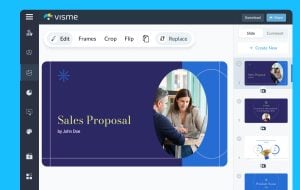
Brought to you by Visme
A leading visual communication platform empowering 27,500,000 users and top brands.
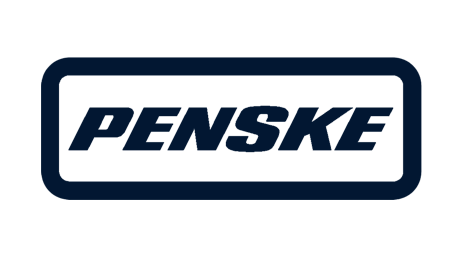
Presentations Engineered With Visme’s AI Presentation Maker
Ai presentation prompt 1.
Craft a presentation outlining a leading company’s cutting-edge innovations in AI-powered hardware, emphasizing their impact on enhancing workplace productivity and efficiency.
AI Presentation Prompt 2
Generate a comprehensive presentation highlighting the latest digital marketing trends, focusing on strategies for enhancing brand visibility and customer engagement across diverse platforms.
AI Presentation Prompt 3
Create a detailed presentation elucidating a company’s diversified investment portfolio, emphasizing its robust performance, risk mitigation strategies, and the potential for sustainable long-term growth.
AI Presentation Prompt 4
Develop a compelling presentation showcasing a company’s groundbreaking medical devices and software solutions, emphasizing their role in revolutionizing patient care, treatment efficacy, and healthcare accessibility worldwide.
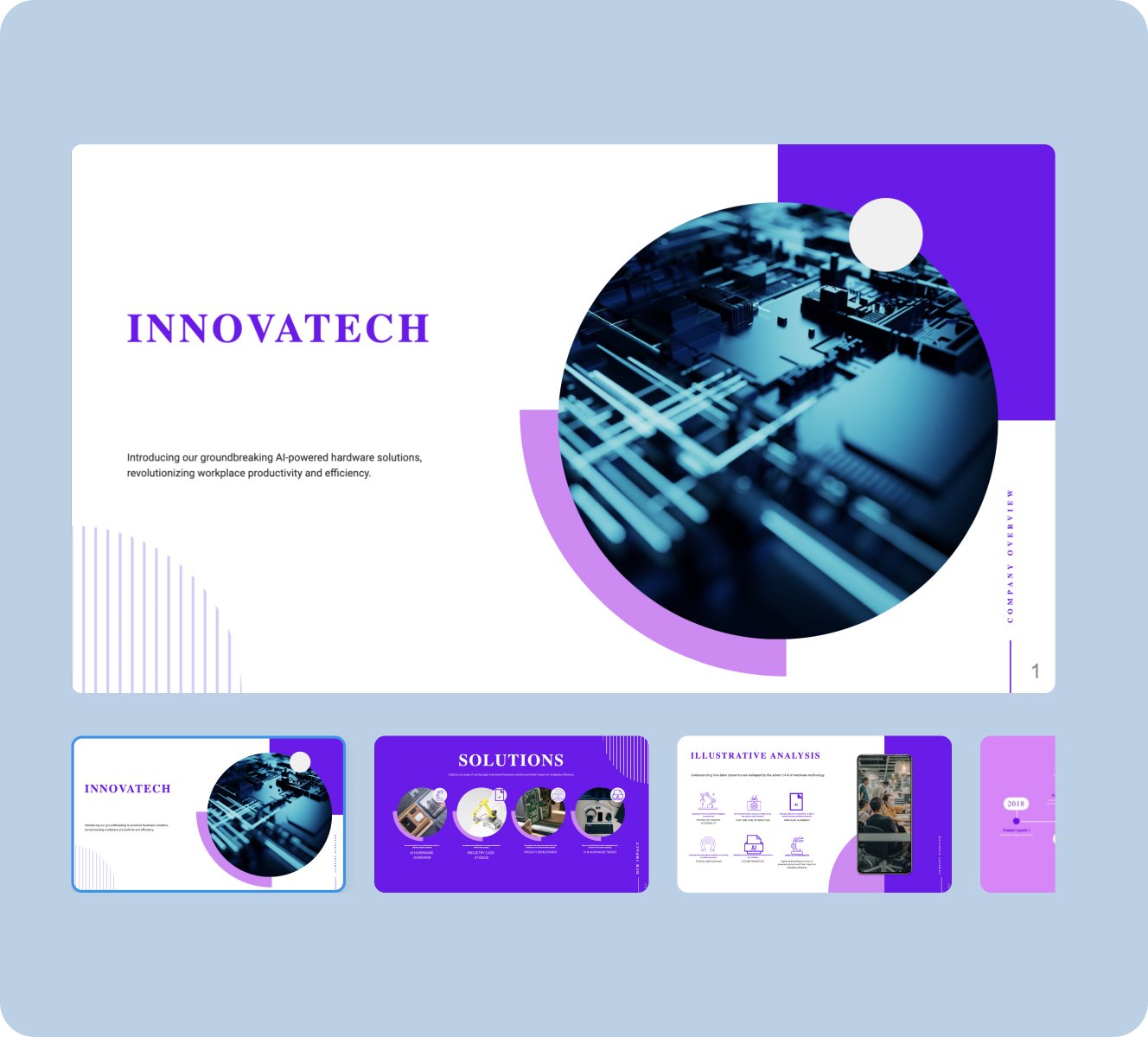
How it works
How to generate AI presentations with Visme
Save time and create beautiful designs quickly with Visme AI Designer. Available inside the Visme template library, this generator tool is ready to receive your prompts and generate stunning ready-to-use presentations in minutes.
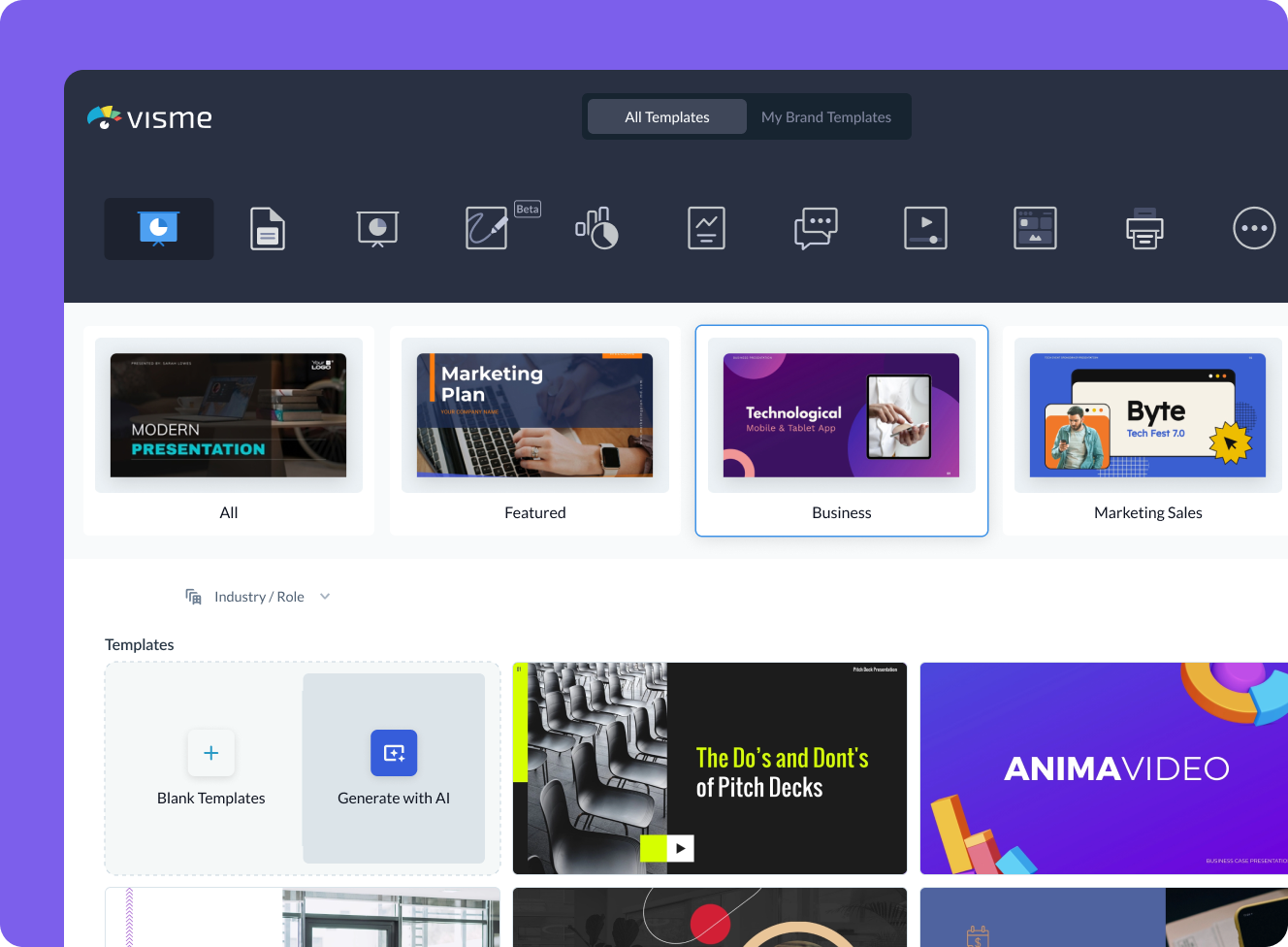
- Log in to the Visme dashboard, and open the template library by clicking on Create New button -> Project -> Presentations. Inside the template library, scroll down and click on the Generate with AI option.
- In the popup that opens, type in a prompt and describe in detail what aspects your presentation should feature. If you don’t provide enough information, chatbot will ask you follow-up questions.
- Visme Chatbot will suggest template styles; choose the most relevant for your presentation, and wait for the AI to create the design. Preview, regenerate or open your project in the Visme editor.
- Customize your project in Visme: Pick a color theme or create your own, edit text, and use assets from Visme’s royalty-free library of photos, videos, and graphics, or create your own with AI tools.
Features of the AI Presentations Maker
Ready-to-use presentations in minutes.
Starting is often the hardest part of a project. Visme’s free AI presentation maker helps you overcome this block and generates results within minutes. It gives you a headstart and a good first draft that is ready-to-use with minimal or no customization.
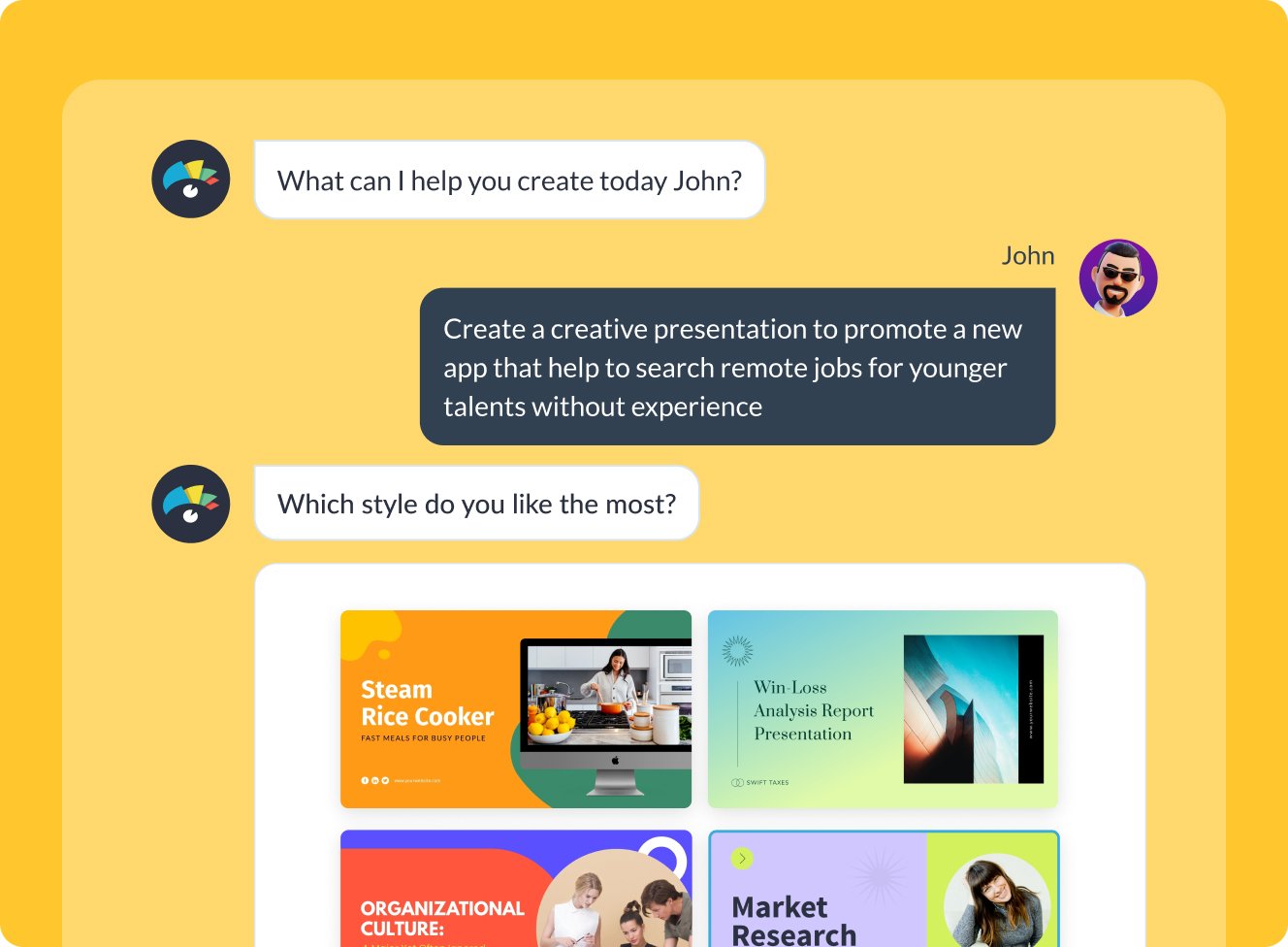
Customize every part of your presentation
Visme editor is easy to use and offers you an array of customization options. Change the color theme of your presentation, text, fonts, add images, videos and graphics from Visme royalty-free library of assets or generate new ones with AI image generator, AI image touchup tools, or add your own. For more advanced customization, add data visualizations, connect them to live data, or create your own visuals.

Add your branding
Stay on-brand even with AI-generated presentations. Quickly and easily set up your brand kit using AI-powered Visme Brand Wizard or set it up manually. Use your brand colors and fonts in AI-generated presentations. Add your logo and upload your brand assets to make a presentation match your company’s branding.
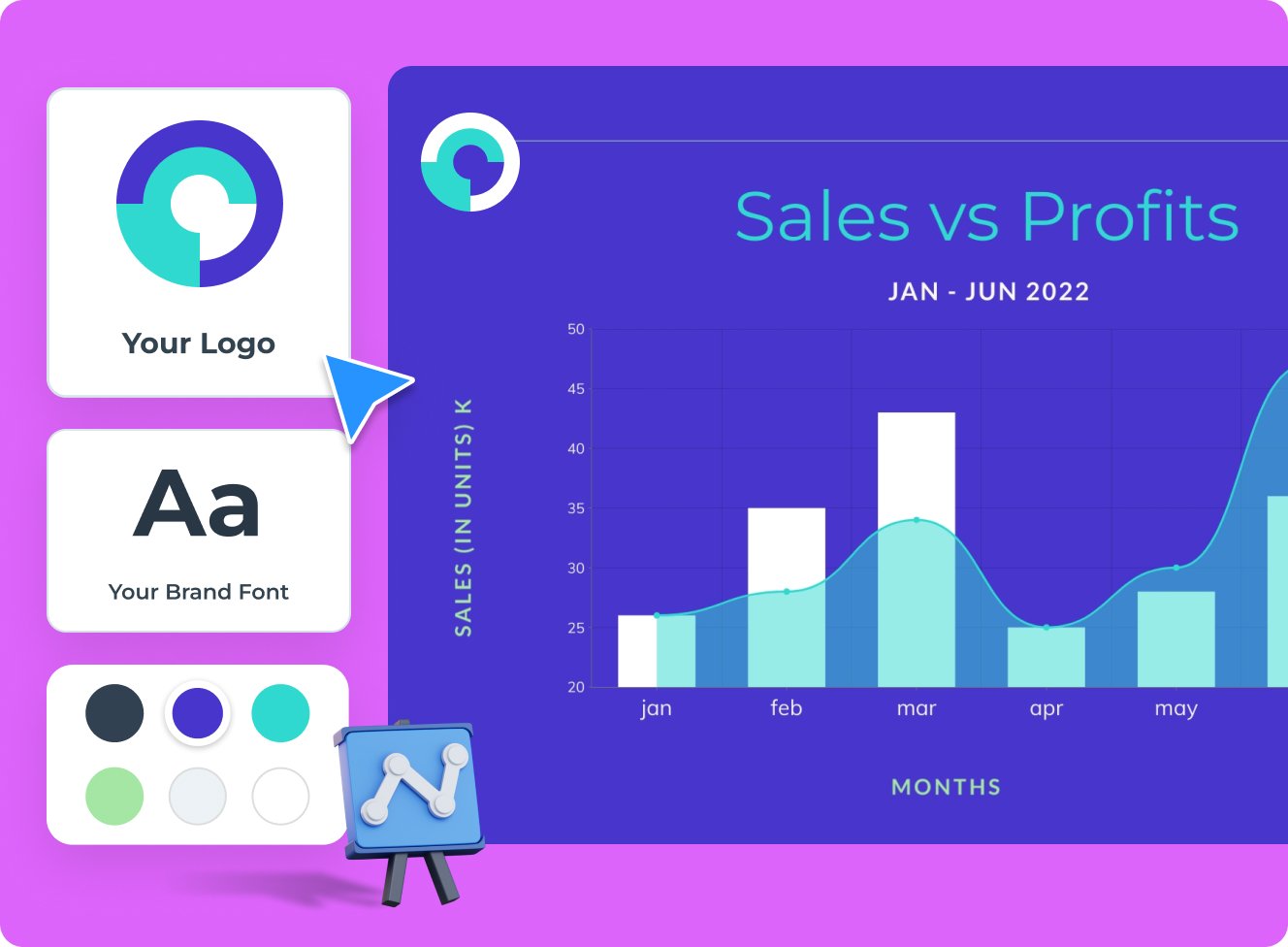
Download, share or schedule your presentation
Share your presentations generated with Visme AI Designer in many ways. Download them in various formats, including PPTX, PDF and HTML5, present online, share on social media or schedule them to be published as posts on your social media channels. Additionally, you can share your presentations as private projects with a password entry.
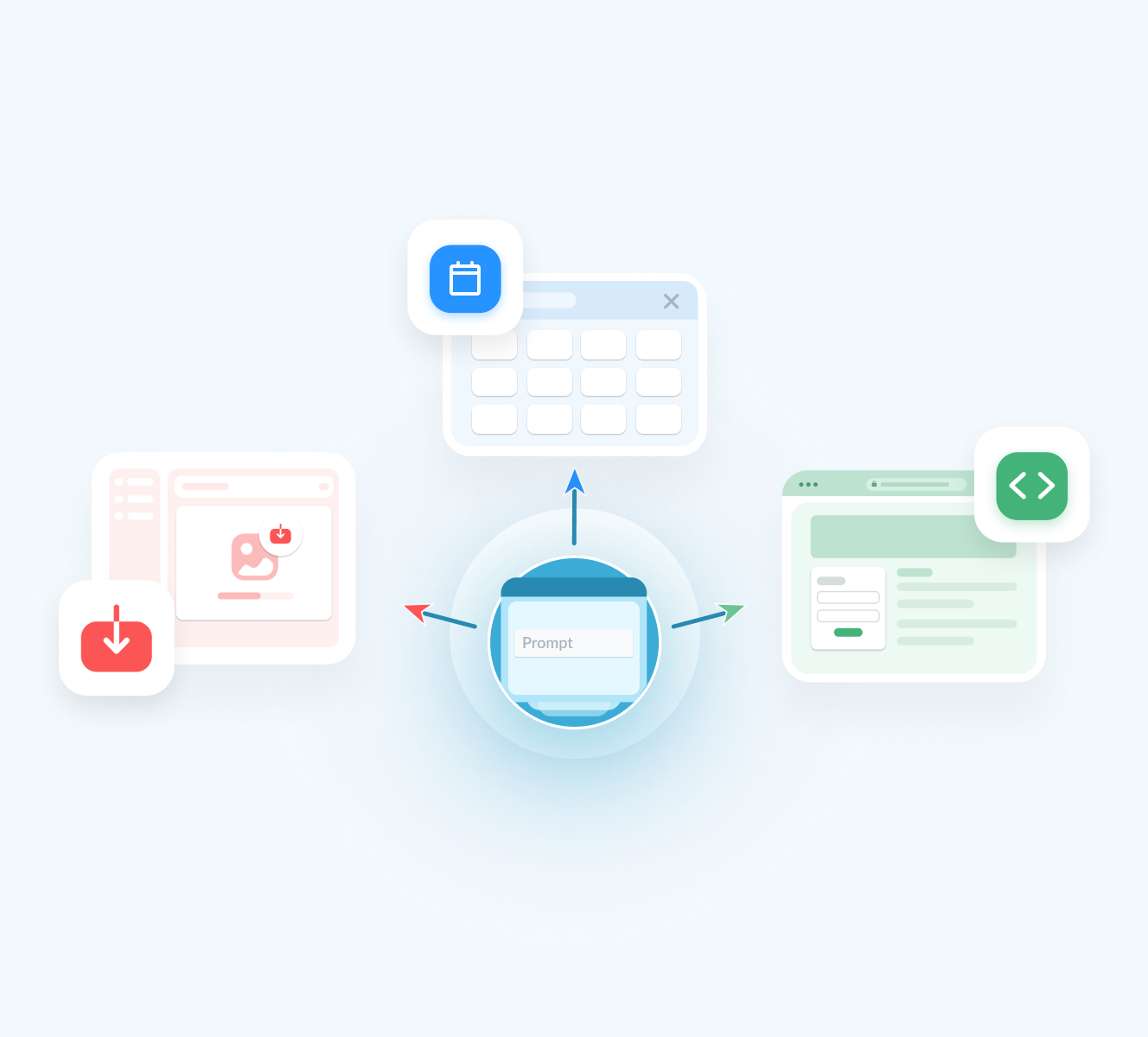
More than just an AI Presentation Maker
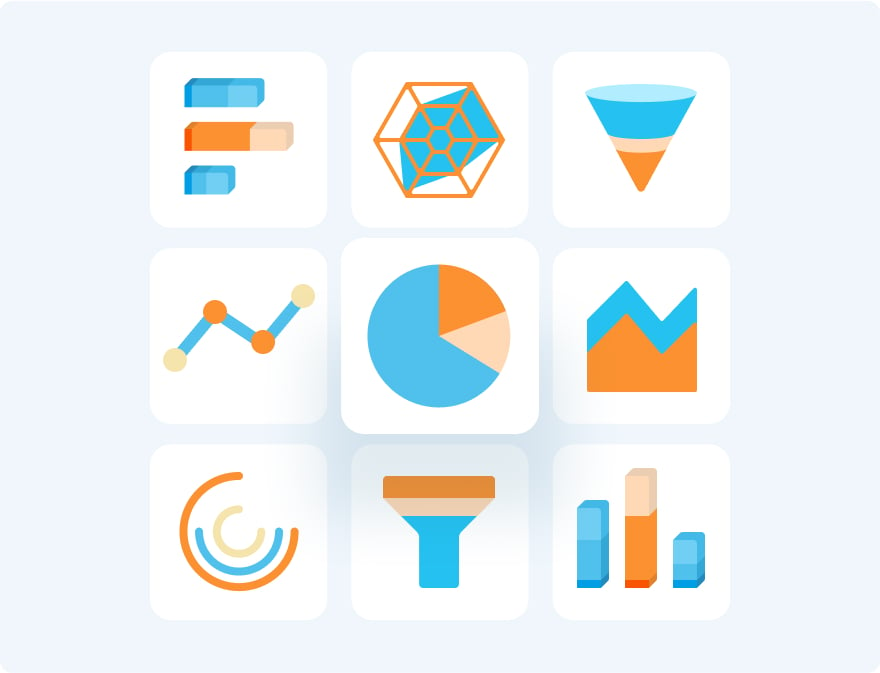
Beautify your content
Unique Elements & Graphics
Browse through our library of customizable, one-of-a-kind graphics, widgets and design assets like icons, shapes, illustrations and more to accompany your AI-generated presentations.

Visualize your data
Charts & Graphs
Choose from different chart types and create pie charts, bar charts, donut charts, pyramid charts, Mekko charts, radar charts and much more.
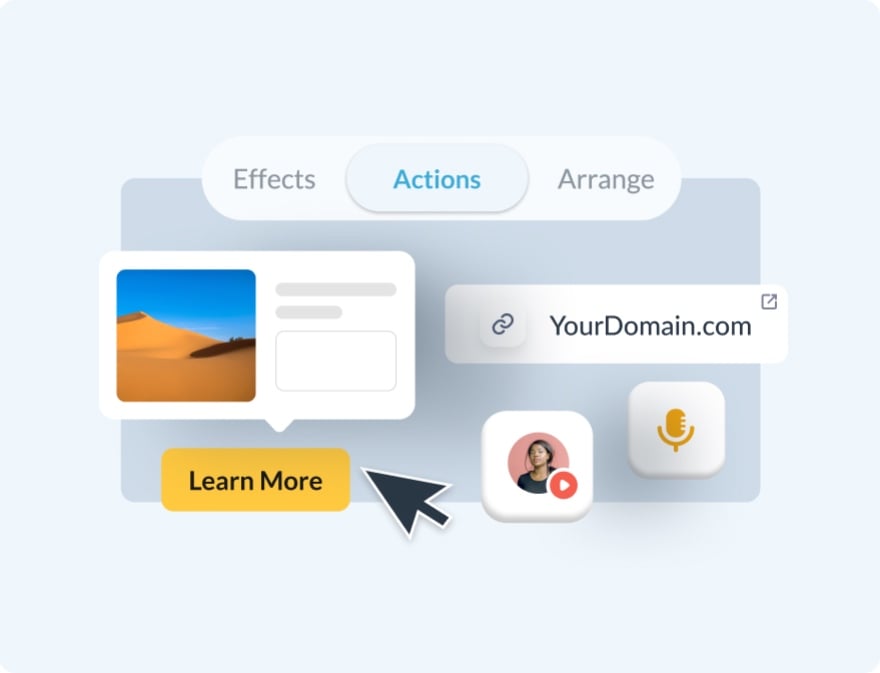
Make it engaging
Interactivity
Share AI-generated presentations online with animated and interactive elements to grab your audience’s attention and promote your business.
More AI tools in Visme
Ai image generator.
The Visme AI Image generator will automatically create any image or graphic. All you need to do is write a prompt and let AI magic do the rest.

Visme AI Writer helps you write, proofread, summarize and tone switch any type of text. If you’re missing content for a project, let AI Writer help you generate it.
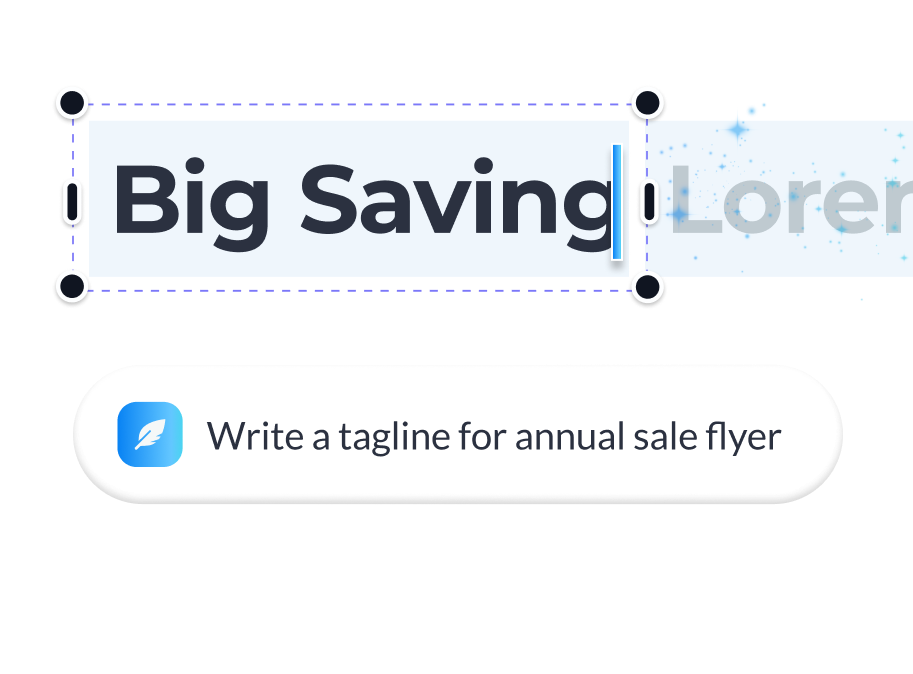
Save yourself hours of work with AI Resize. This feature resizes your project canvas and adjusts all content to fit the new size within seconds.

AI TouchUp Tools
The Visme AI TouchUp Tools are a set of four image editing features that will help you change the appearance of your images inside any Visme project. Erase and replace objects that you don’t want in your photos.
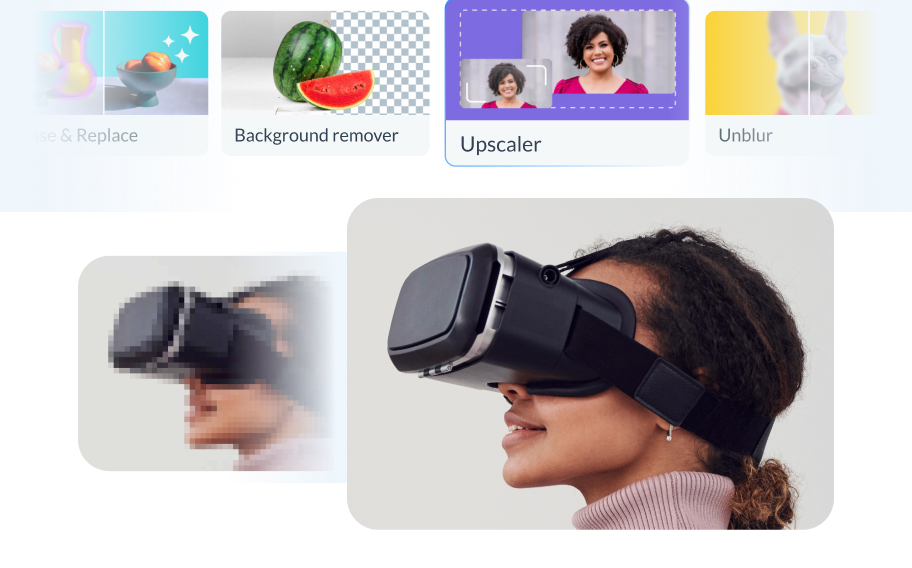
The Brand Wizard
The AI-based Visme Brand Wizard populates your brand fonts and styles across a beautiful set of templates.
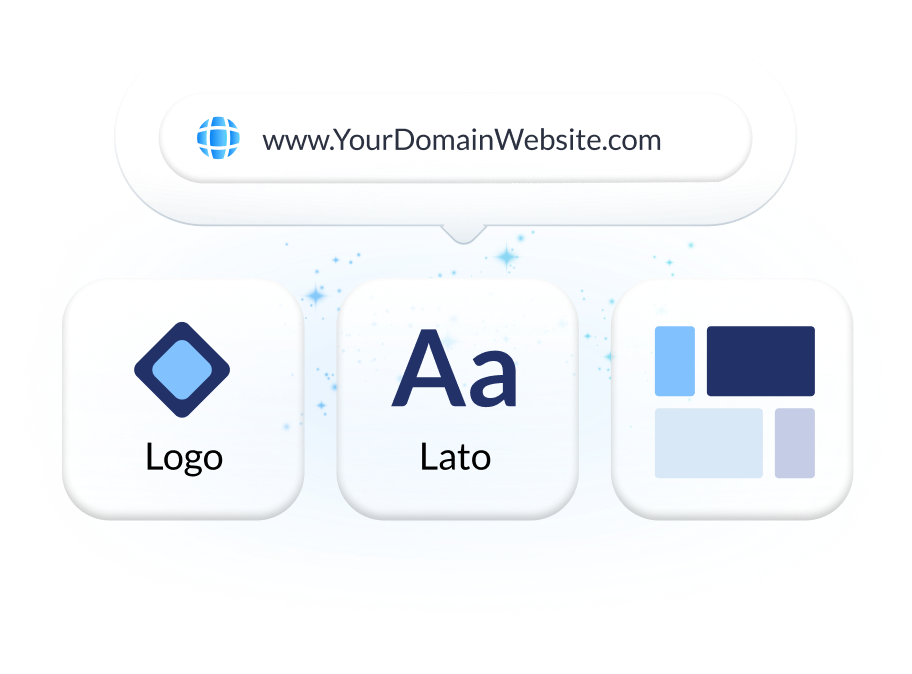
Make the most of Visme’s features
Choose the perfect visual from our extensive photo and video library . Search and find the ideal image or video using keywords relevant to the project. Drag and drop in your project and adjust as needed.
Incorporate 3D illustrations and icons into all sorts of content types to create amazing content for your business communication strategies. You won’t see these 3D designs anywhere else as they’re made by Visme designers.
When you share your Visme projects, they’ll display with a flipbook effect . Viewers can go from page to page by flipping the page like a digital magazine. If you don’t want the flipbook effect, you can disable it and share as a standard project.
Remove the background from an image to create a cutout and layer it over something else, maybe an AI-generated background. Erase elements of the image and swap them for other objects with AI-powered Erase & Replace feature.
Create scroll-stopping video and animation posts for social media and email communication. Embed projects with video and animation into your website landing page or create digital documents with multimedia resources.
With Visme, you can make, create and design hundreds of content types . We have templates for digital documents, infographics, social media graphics, posters, banners, wireframes, whiteboards, flowcharts.
Design and brainstorm collaboratively with your team on the Visme whiteboard . Build mind maps and flowcharts easily during online planning and strategy sessions. Save whiteboards as meeting minutes and ongoing notes for projects.
Edit your images , photos, and AI image-generated graphics with our integrated editing tools. On top of the regular editing features like saturation and blur, we have 3 AI-based editing features. With these tools, you can unblur an image, expand it without losing quality and erase an object from it.
Frequently Asked Questions (FAQs)
How can i get better results with the ai presentations maker.
Like any AI generator from a text tool, the prompt is everything. To get better results with the AI Presentation maker, you need better prompts. Write the prompt to be as detailed as possible. Include all the content topics you want the presentation to cover. As for style elements, there’s no need to include it in the prompt. Focus on choosing the style that you like from the Chatbot suggestions. Try to select the style that already features the color palette and shapes that you like. AI will change icons and photos based on text it generates.
How many AI Presentations can I generate?
Visme AI Presentation maker is available in all plans with higher credits/usage available in Premium plans. Note: AI credits are spread amongst all AI features. So if you use other AI features, your credits will be deducted.
Is the Visme AI Designer a third-party API?
No, Visme AI Presentation maker was developed in-house and is a unique tool. However, it does use third-party APIs: ChatGPT and Unsplash.
This website uses cookies to improve the user experience. By using our website you consent to all cookies in accordance with our cookie policies included in our privacy policy.
JavaScript is disabled in your browser. To view the website properly, please enable JavaScript in your browser settings and refresh the page.
Apply for and manage a grant or program for your business.
Manage your interactions with the R&D Tax Incentive program.
- Business plans
Develop your marketing plan
On this page
Why you need a marketing plan
Download our marketing plan template.
Having a marketing plan can help you to:
- identify your target market and how your product or service can benefit it
- identify how you might attract new customers
- encourage your existing customers to continue purchasing your product or service
- set goals and time frames for your marketing activities
- map out a strategy to reach your target audience, including the messages, channels and tools you’ll use
- evaluate your marketing activities
- provide a marketing budget and see your return on investment.
Our marketing plan template helps you identify who your customers are, how you'll meet their needs and what marketing tactics you might undertake.
Marketing plan template
Our template steps you through the process of developing a succession plan with links to extra information if you need it.
You may want to check our tips below before you start.
1. Analyse your market
Market research can help you to understand your strengths, weaknesses and the opportunities that you can take advantage of. Analysing your own business and your competition can help you identify where you're positioned in the market.
It’s important to analyse your competition to identify their strengths and weaknesses. This can help you refine your marketing strategy and what's unique about your business.
A strengths, weaknesses, opportunities and threats (SWOT) analysis can help you determine where your business fits within the market and your unique selling point. Use it to help identify what your business is doing well and how you can improve.
Identifying and understanding your customers is an essential part of your marketing plan. Not everyone is your potential buyer, so it’s important to have a clear understanding of your target market early on.
Identify your target market, competitors and potential customers .
2. Set your goals and objectives
Once you're clear about your business and its positioning, you can start thinking about what you want to achieve. Think about your main business goals, whether it's the size of your business, expansion plans or desired sales. Set specific, measurable, achievable, relevant and time bound (SMART) goals to increase your chances of success in achieving them.
3. Outline your marketing strategies
Once you’ve set some goals, consider what marketing activity, process or price will help you achieve them.
Try and choose marketing activities that suit your business and your customers. For example, if you want to target young adults, newspaper advertising may not be as effective as a social media campaign.
Choosing multiple activities that complement each other is a good way to help you get your message across. For example, if you're trying to establish a new product in the market, you may choose to advertise on the local radio, as well as setting up social media channels and introducing a low-cost pricing strategy for first-time buyers. When used together, these strategies complement each other and help you reach a broader market.
4. Set your marketing budget
Knowing how much you have to spend on marketing and how to spend it is critical to the success of your business. A marketing budget will ensure you accurately calculate your marketing campaign or advertising.
When developing your marketing budget, make sure you're only spending money on the activities that contribute to your current marketing goals. Advertising and promotion can be expensive. Make sure to pick options that will give you the best value while still reaching your target customers.
5. Keep your marketing plan up-to-date
It's important to evaluate your marketing activities. Analysing your results and being aware of new marketing trends is important to keeping your marketing plan up-to-date and reaching your business goals. You should tweak and change your plan as your business and market grow and change.
Find out the different types of advertising.
Read about business marketing to help position your business within your market., read about product labelling and how to label your products., was this page helpful, thanks for sharing your feedback with us..
Our live chat service is open from 8am - 8pm, Monday to Friday, across Australia (excluding national public holidays ).
Learn about the other ways you can contact us .
All our experts are busy now. Please try again later or contact us another way
We're open from 8am - 8pm, Monday to Friday, across Australia (excluding national public holidays ).
We use cookies to give you a better experience on our website. Learn more about how we use cookies and how you can select your preferences.

An official website of the United States government
Here’s how you know
Official websites use .gov A .gov website belongs to an official government organization in the United States.
Secure .gov websites use HTTPS A lock ( A locked padlock ) or https:// means you’ve safely connected to the .gov website. Share sensitive information only on official, secure websites.
- Heart-Healthy Living
- High Blood Pressure
- Sickle Cell Disease
- Sleep Apnea
- Information & Resources on COVID-19
- The Heart Truth®
- Learn More Breathe Better®
- Blood Diseases and Disorders Education Program
- Publications and Resources
- Blood Disorders and Blood Safety
- Sleep Science and Sleep Disorders
- Lung Diseases
- Health Disparities and Inequities
- Heart and Vascular Diseases
- Precision Medicine Activities
- Obesity, Nutrition, and Physical Activity
- Population and Epidemiology Studies
- Women’s Health
- Research Topics
- Clinical Trials
- All Science A-Z
- Grants and Training Home
- Policies and Guidelines
- Funding Opportunities and Contacts
- Training and Career Development
- Email Alerts
- NHLBI in the Press
- Research Features
- Past Events
- Upcoming Events
- Mission and Strategic Vision
- Divisions, Offices and Centers
- Advisory Committees
- Budget and Legislative Information
- Jobs and Working at the NHLBI
- Contact and FAQs
- NIH Sleep Research Plan
- < Back To Education and Awareness
DASH Eating Plan
- Following DASH
- Living with DASH
- Educational Resources
Description of the DASH Eating Plan
The DASH eating plan requires no special foods and instead provides daily and weekly nutritional goals. This plan recommends:
- Eating vegetables, fruits, and whole grains
- Including fat-free or low-fat dairy products, fish, poultry, beans, nuts, and vegetable oils
- Limiting foods that are high in saturated fat, such as fatty meats, full-fat dairy products, and tropical oils such as coconut, palm kernel, and palm oils
- Limiting sugar-sweetened beverages and sweets
Based on these recommendations, the following table shows examples of daily and weekly servings that meet DASH eating plan targets for a 2,000-calorie-a-day diet.
|
|
|
|---|---|
| Grains | 6–8 |
| Meats, poultry, and fish | 6 or less |
| Vegetables | 4–5 |
| Fruit | 4–5 |
| Low-fat or fat-free dairy products | 2–3 |
| Fats and oils | 2–3 |
| Sodium | 2,300 mg* |
|
|
|
| Nuts, seeds, dry beans, and peas | 4–5 |
| Sweets | 5 or less |
*1,500 milligrams (mg) sodium lowers blood pressure even further than 2,300 mg sodium daily.
When following the DASH eating plan, it is important to choose foods that are:
- Low in saturated and trans fats
- Rich in potassium, calcium, magnesium, fiber, and protein
- Lower in sodium
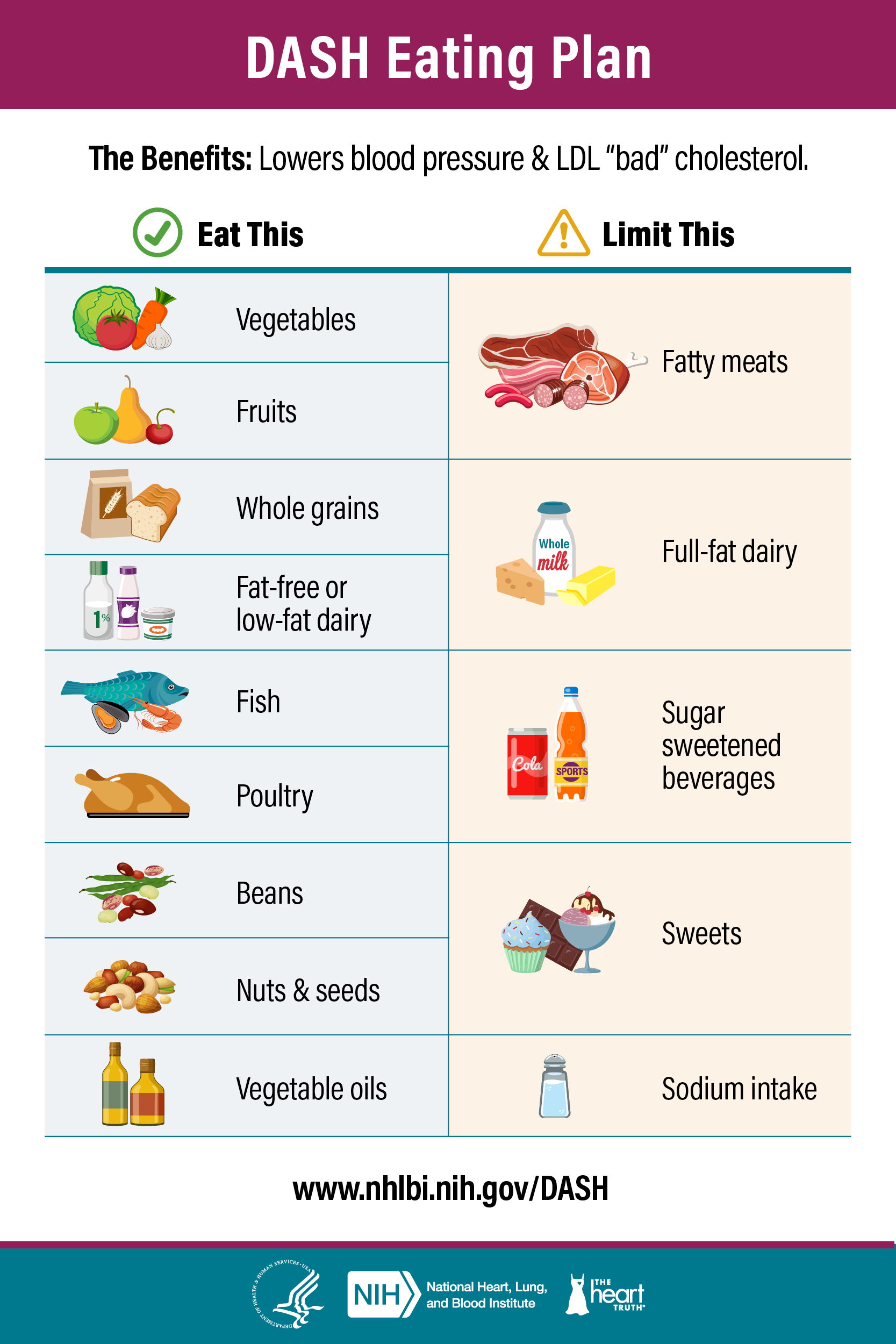
Related News
Nih-supported dash diet tops rankings for “heart-healthy” and “healthy eating”.


B2B Content Marketing Benchmarks, Budgets, and Trends: Outlook for 2024 [Research]
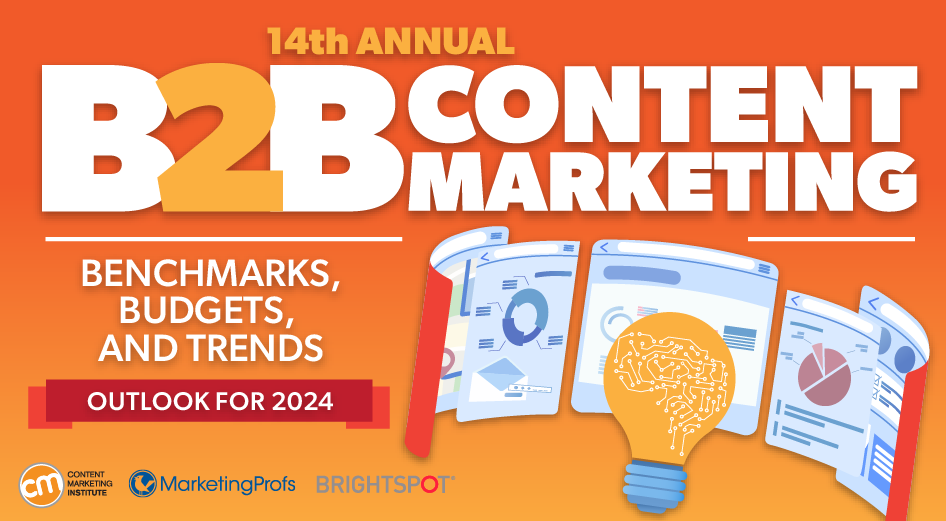
- by Stephanie Stahl
- | Published: October 18, 2023
- | Trends and Research
Creating standards, guidelines, processes, and workflows for content marketing is not the sexiest job.
But setting standards is the only way to know if you can improve anything (with AI or anything else).
Here’s the good news: All that non-sexy work frees time and resources (human and tech) you can apply to bring your brand’s strategies and plans to life.
But in many organizations, content still isn’t treated as a coordinated business function. That’s one of the big takeaways from our latest research, B2B Content Marketing Benchmarks, Budgets, and Trends: Outlook for 2024, conducted with MarketingProfs and sponsored by Brightspot .
A few symptoms of that reality showed up in the research:
- Marketers cite a lack of resources as a top situational challenge, the same as they did the previous year.
- Nearly three-quarters (72%) say they use generative AI, but 61% say their organization lacks guidelines for its use.
- The most frequently cited challenges include creating the right content, creating content consistently, and differentiating content.
I’ll walk you through the findings and share some advice from CMI Chief Strategy Advisor Robert Rose and other industry voices to shed light on what it all means for B2B marketers. There’s a lot to work through, so feel free to use the table of contents to navigate to the sections that most interest you.
Note: These numbers come from a July 2023 survey of marketers around the globe. We received 1,080 responses. This article focuses on answers from the 894 B2B respondents.
Table of contents
- Team structure
- Content marketing challenges
Content types, distribution channels, and paid channels
- Social media
Content management and operations
- Measurement and goals
- Overall success
- Budgets and spending
- Top content-related priorities for 2024
- Content marketing trends for 2024
Action steps
Methodology, ai: 3 out of 4 b2b marketers use generative tools.
Of course, we asked respondents how they use generative AI in content and marketing. As it turns out, most experiment with it: 72% of respondents say they use generative AI tools.
But a lack of standards can get in the way.
“Generative AI is the new, disruptive capability entering the realm of content marketing in 2024,” Robert says. “It’s just another way to make our content process more efficient and effective. But it can’t do either until you establish a standard to define its value. Until then, it’s yet just another technology that may or may not make you better at what you do.”
So, how do content marketers use the tools today? About half (51%) use generative AI to brainstorm new topics. Many use the tools to research headlines and keywords (45%) and write drafts (45%). Fewer say they use AI to outline assignments (23%), proofread (20%), generate graphics (11%), and create audio (5%) and video (5%).

Some marketers say they use AI to do things like generate email headlines and email copy, extract social media posts from long-form content, condense long-form copy into short form, etc.
Only 28% say they don’t use generative AI tools.
Most don’t pay for generative AI tools (yet)
Among those who use generative AI tools, 91% use free tools (e.g., ChatGPT ). Thirty-eight percent use tools embedded in their content creation/management systems, and 27% pay for tools such as Writer and Jasper.
AI in content remains mostly ungoverned
Asked if their organizations have guidelines for using generative AI tools, 31% say yes, 61% say no, and 8% are unsure.

We asked Ann Handley , chief content officer of MarketingProfs, for her perspective. “It feels crazy … 61% have no guidelines? But is it actually shocking and crazy? No. It is not. Most of us are just getting going with generative AI. That means there is a clear and rich opportunity to lead from where you sit,” she says.
“Ignite the conversation internally. Press upon your colleagues and your leadership that this isn’t a technology opportunity. It’s also a people and operational challenge in need of thoughtful and intelligent response. You can be the AI leader your organization needs,” Ann says.
Why some marketers don’t use generative AI tools
While a lack of guidelines may deter some B2B marketers from using generative AI tools, other reasons include accuracy concerns (36%), lack of training (27%), and lack of understanding (27%). Twenty-two percent cite copyright concerns, and 19% have corporate mandates not to use them.

How AI is changing SEO
We also wondered how AI’s integration in search engines shifts content marketers’ SEO strategy. Here’s what we found:
- 31% are sharpening their focus on user intent/answering questions.
- 27% are creating more thought leadership content.
- 22% are creating more conversational content.
Over one-fourth (28%) say they’re not doing any of those things, while 26% say they’re unsure.
AI may heighten the need to rethink your SEO strategy. But it’s not the only reason to do so, as Orbit Media Studios co-founder and chief marketing officer Andy Crestodina points out: “Featured snippets and people-also-ask boxes have chipped away at click-through rates for years,” he says. “AI will make that even worse … but only for information intent queries . Searchers who want quick answers really don’t want to visit websites.
“Focus your SEO efforts on those big questions with big answers – and on the commercial intent queries,” Andy continues. “Those phrases still have ‘visit website intent’ … and will for years to come.”
Will the AI obsession ever end?
Many B2B marketers surveyed predict AI will dominate the discussions of content marketing trends in 2024. As one respondent says: “AI will continue to be the shiny thing through 2024 until marketers realize the dedication required to develop prompts, go through the iterative process, and fact-check output . AI can help you sharpen your skills, but it isn’t a replacement solution for B2B marketing.”
Back to table of contents
Team structure: How does the work get done?
Generative AI isn’t the only issue affecting content marketing these days. We also asked marketers about how they organize their teams .
Among larger companies (100-plus employees), half say content requests go through a centralized content team. Others say each department/brand produces its own content (23%), and the departments/brand/products share responsibility (21%).

Content strategies integrate with marketing, comms, and sales
Seventy percent say their organizations integrate content strategy into the overall marketing sales/communication/strategy, and 2% say it’s integrated into another strategy. Eleven percent say content is a stand-alone strategy for content used for marketing, and 6% say it’s a stand-alone strategy for all content produced by the company. Only 9% say they don’t have a content strategy. The remaining 2% say other or are unsure.
Employee churn means new teammates; content teams experience enlightened leadership
Twenty-eight percent of B2B marketers say team members resigned in the last year, 20% say team members were laid off, and about half (49%) say they had new team members acclimating to their ways of working.
While team members come and go, the understanding of content doesn’t. Over half (54%) strongly agree, and 30% somewhat agree the leader to whom their content team reports understands the work they do. Only 11% disagree. The remaining 5% neither agree nor disagree.
And remote work seems well-tolerated: Only 20% say collaboration was challenging due to remote or hybrid work.
Content marketing challenges: Focus shifts to creating the right content
We asked B2B marketers about both content creation and non-creation challenges.
Content creation
Most marketers (57%) cite creating the right content for their audience as a challenge. This is a change from many years when “creating enough content” was the most frequently cited challenge.
One respondent points out why understanding what audiences want is more important than ever: “As the internet gets noisier and AI makes it incredibly easy to create listicles and content that copy each other, there will be a need for companies to stand out. At the same time, as … millennials and Gen Z [grow in the workforce], we’ll begin to see B2B become more entertaining and less boring. We were never only competing with other B2B content. We’ve always been competing for attention.”
Other content creation challenges include creating it consistently (54%) and differentiating it (54%). Close to half (45%) cite optimizing for search and creating quality content (44%). About a third (34%) cite creating enough content to keep up with internal demand, 30% say creating enough content to keep up with external demand, and 30% say creating content that requires technical skills.

Other hurdles
The most frequently cited non-creation challenge, by far, is a lack of resources (58%), followed by aligning content with the buyer’s journey (48%) and aligning content efforts across sales and marketing (45%). Forty-one percent say they have issues with workflow/content approval, and 39% say they have difficulty accessing subject matter experts. Thirty-four percent say it is difficult to keep up with new technologies/tools (e.g., AI). Only 25% cite a lack of strategy as a challenge, 19% say keeping up with privacy rules, and 15% point to tech integration issues.

We asked content marketers about the types of content they produce, their distribution channels , and paid content promotion. We also asked which formats and channels produce the best results.
Popular content types and formats
As in the previous year, the three most popular content types/formats are short articles/posts (94%, up from 89% last year), videos (84%, up from 75% last year), and case studies/customer stories (78%, up from 67% last year). Almost three-quarters (71%) use long articles, 60% produce visual content, and 59% craft thought leadership e-books or white papers. Less than half of marketers use brochures (49%), product or technical data sheets (45%), research reports (36%), interactive content (33%), audio (29%), and livestreaming (25%).

Effective content types and formats
Which formats are most effective? Fifty-three percent say case studies/customer stories and videos deliver some of their best results. Almost as many (51%) names thought leadership e-books or white papers, 47% short articles, and 43% research reports.

Popular content distribution channels
Regarding the channels used to distribute content, 90% use social media platforms (organic), followed by blogs (79%), email newsletters (73%), email (66%), in-person events (56%), and webinars (56%).
Channels used by the minority of those surveyed include:
- Digital events (44%)
- Podcasts (30%)
- Microsites (29%)
- Digital magazines (21%)
- Branded online communities (19%)
- Hybrid events (18%)
- Print magazines (16%)
- Online learning platforms (15%)
- Mobile apps (8%)
- Separate content brands (5%)

Effective content distribution channels
Which channels perform the best? Most marketers in the survey point to in-person events (56%) and webinars (51%) as producing better results. Email (44%), organic social media platforms (44%), blogs (40%) and email newsletters (39%) round out the list.

Popular paid content channels
When marketers pay to promote content , which channels do they invest in? Eighty-six percent use paid content distribution channels.
Of those, 78% use social media advertising/promoted posts, 65% use sponsorships, 64% use search engine marketing (SEM)/pay-per-click, and 59% use digital display advertising. Far fewer invest in native advertising (35%), partner emails (29%), and print display ads (21%).
Effective paid content channels
SEM/pay-per-click produces good results, according to 62% of those surveyed. Half of those who use paid channels say social media advertising/promoted posts produce good results, followed by sponsorships (49%), partner emails (36%), and digital display advertising (34%).

Social media use: One platform rises way above
When asked which organic social media platforms deliver the best value for their organization, B2B marketers picked LinkedIn by far (84%). Only 29% cite Facebook as a top performer, 22% say YouTube, and 21% say Instagram. Twitter and TikTok see 8% and 3%, respectively.

So it makes sense that 72% say they increased their use of LinkedIn over the last 12 months, while only 32% boosted their YouTube presence, 31% increased Instagram use, 22% grew their Facebook presence, and 10% increased X and TikTok use.
Which platforms are marketers giving up? Did you guess X? You’re right – 32% of marketers say they decreased their X use last year. Twenty percent decreased their use of Facebook, with 10% decreasing on Instagram, 9% pulling back on YouTube, and only 2% decreasing their use of LinkedIn.

Interestingly, we saw a significant rise in B2B marketers who use TikTok: 19% say they use the platform – more than double from last year.
To explore how teams manage content, we asked marketers about their technology use and investments and the challenges they face when scaling their content .
Content management technology
When asked which technologies they use to manage content, marketers point to:
- Analytics tools (81%)
- Social media publishing/analytics (72%)
- Email marketing software (69%)
- Content creation/calendaring/collaboration/workflow (64%)
- Content management system (50%)
- Customer relationship management system (48%)
But having technology doesn’t mean it’s the right technology (or that its capabilities are used). So, we asked if they felt their organization had the right technology to manage content across the organization.
Only 31% say yes. Thirty percent say they have the technology but aren’t using its potential, and 29% say they haven’t acquired the right technology. Ten percent are unsure.

Content tech spending will likely rise
Even so, investment in content management technology seems likely in 2024: 45% say their organization is likely to invest in new technology, whereas 32% say their organization is unlikely to do so. Twenty-three percent say their organization is neither likely nor unlikely to invest.

Scaling content production
We introduced a new question this year to understand what challenges B2B marketers face while scaling content production .
Almost half (48%) say it’s “not enough content repurposing.” Lack of communication across organizational silos is a problem for 40%. Thirty-one percent say they have no structured content production process, and 29% say they lack an editorial calendar with clear deadlines. Ten percent say scaling is not a current focus.
Among the other hurdles – difficulty locating digital content assets (16%), technology issues (15%), translation/localization issues (12%), and no style guide (11%).

For those struggling with content repurposing, content standardization is critical. “Content reuse is the only way to deliver content at scale. There’s just no other way,” says Regina Lynn Preciado , senior director of content strategy solutions at Content Rules Inc.
“Even if you’re not trying to provide the most personalized experience ever or dominate the metaverse with your omnichannel presence, you absolutely must reuse content if you are going to deliver content effectively,” she says.
“How to achieve content reuse ? You’ve probably heard that you need to move to modular, structured content. However, just chunking your content into smaller components doesn’t go far enough. For content to flow together seamlessly wherever you reuse it, you’ve got to standardize your content. That’s the personalization paradox right there. To personalize, you must standardize.
“Once you have your content standards in place and everyone is creating content in alignment with those standards, there is no limit to what you can do with the content,” Regina explains.
Why do content marketers – who are skilled communicators – struggle with cross-silo communication? Standards and alignment come into play.
“I think in the rush to all the things, we run out of time to address scalable processes that will fix those painful silos, including taking time to align on goals, roles and responsibilities, workflows, and measurement,” says Ali Orlando Wert , senior director of content strategy at Appfire. “It takes time, but the payoffs are worth it. You have to learn how to crawl before you can walk – and walk before you can run.”
Measurement and goals: Generating sales and revenue rises
Almost half (46%) of B2B marketers agree their organization measures content performance effectively. Thirty-six percent disagree, and 15% neither agree nor disagree. Only 3% say they don’t measure content performance.
The five most frequently used metrics to assess content performance are conversions (73%), email engagement (71%), website traffic (71%), website engagement (69%), and social media analytics (65%).
About half (52%) mention the quality of leads, 45% say they rely on search rankings, 41% use quantity of leads, 32% track email subscribers, and 29% track the cost to acquire a lead, subscriber, or customer.

The most common challenge B2B marketers have while measuring content performance is integrating/correlating data across multiple platforms (84%), followed by extracting insights from data (77%), tying performance data to goals (76%), organizational goal setting (70%), and lack of training (66%).

Regarding goals, 84% of B2B marketers say content marketing helped create brand awareness in the last 12 months. Seventy-six percent say it helped generate demand/leads; 63% say it helped nurture subscribers/audiences/leads, and 58% say it helped generate sales/revenue (up from 42% the previous year).

Success factors: Know your audience
To separate top performers from the pack, we asked the B2B marketers to assess the success of their content marketing approach.
Twenty-eight percent rate the success of their organization’s content marketing approach as extremely or very successful. Another 57% report moderate success and 15% feel minimally or not at all successful.
The most popular factor for successful marketers is knowing their audience (79%).
This makes sense, considering that “creating the right content for our audience” is the top challenge. The logic? Top-performing content marketers prioritize knowing their audiences to create the right content for those audiences.
Top performers also set goals that align with their organization’s objectives (68%), effectively measure and demonstrate content performance (61%), and show thought leadership (60%). Collaboration with other teams (55%) and a documented strategy (53%) also help top performers reach high levels of content marketing success.

We looked at several other dimensions to identify how top performers differ from their peers. Of note, top performers:
- Are backed by leaders who understand the work they do.
- Are more likely to have the right content management technologies.
- Have better communication across organizational silos.
- Do a better job of measuring content effectiveness.
- Are more likely to use content marketing successfully to generate demand/leads, nurture subscribers/audiences/leads, generate sales/revenue, and grow a subscribed audience.
Little difference exists between top performers and their less successful peers when it comes to the adoption of generative AI tools and related guidelines. It will be interesting to see if and how that changes next year.

Budgets and spending: Holding steady
To explore budget plans for 2024, we asked respondents if they have knowledge of their organization’s budget/budgeting process for content marketing. Then, we asked follow-up questions to the 55% who say they do have budget knowledge.
Content marketing as a percentage of total marketing spend
Here’s what they say about the total marketing budget (excluding salaries):
- About a quarter (24%) say content marketing takes up one-fourth or more of the total marketing budget.
- Nearly one in three (29%) indicate that 10% to 24% of the marketing budget goes to content marketing.
- Just under half (48%) say less than 10% of the marketing budget goes to content marketing.
Content marketing budget outlook for 2024
Next, we asked about their 2024 content marketing budget. Forty-five percent think their content marketing budget will increase compared with 2023, whereas 42% think it will stay the same. Only 6% think it will decrease.

Where will the budget go?
We also asked where respondents plan to increase their spending.
Sixty-nine percent of B2B marketers say they would increase their investment in video, followed by thought leadership content (53%), in-person events (47%), paid advertising (43%), online community building (33%), webinars (33%), audio content (25%), digital events (21%), and hybrid events (11%).

The increased investment in video isn’t surprising. The focus on thought leadership content might surprise, but it shouldn’t, says Stephanie Losee , director of executive and ABM content at Autodesk.
“As measurement becomes more sophisticated, companies are finding they’re better able to quantify the return from upper-funnel activities like thought leadership content ,” she says. “At the same time, companies recognize the impact of shifting their status from vendor to true partner with their customers’ businesses.
“Autodesk recently launched its first global, longitudinal State of Design & Make report (registration required), and we’re finding that its insights are of such value to our customers that it’s enabling conversations we’ve never been able to have before. These conversations are worth gold to both sides, and I would imagine other B2B companies are finding the same thing,” Stephanie says.
Top content-related priorities for 2024: Leading with thought leadership
We asked an open-ended question about marketers’ top three content-related priorities for 2024. The responses indicate marketers place an emphasis on thought leadership and becoming a trusted resource.
Other frequently mentioned priorities include:
- Better understanding of the audience
- Discovering the best ways to use AI
- Increasing brand awareness
- Lead generation
- Using more video
- Better use of analytics
- Conversions
- Repurposing existing content
Content marketing predictions for 2024: AI is top of mind
In another open-ended question, we asked B2B marketers, “What content marketing trends do you predict for 2024?” You probably guessed the most popular trend: AI.
Here are some of the marketers’ comments about how AI will affect content marketing next year:
- “We’ll see generative AI everywhere, all the time.”
- “There will be struggles to determine the best use of generative AI in content marketing.”
- “AI will likely result in a flood of poor-quality, machine-written content. Winners will use AI for automating the processes that support content creation while continuing to create high-quality human-generated content.”
- “AI has made creating content so easy that there are and will be too many long articles on similar subjects; most will never be read or viewed. A sea of too many words. I predict short-form content will have to be the driver for eyeballs.”
Other trends include:
- Greater demand for high-quality content as consumers grow weary of AI-generated content
- Importance of video content
- Increasing use of short video and audio content
- Impact of AI on SEO
Among the related comments:
- “Event marketing (webinars and video thought leadership) will become more necessary as teams rely on AI-generated written content.”
- “AI will be an industry sea change and strongly impact the meaning of SEO. Marketers need to be ready to ride the wave or get left behind.”
- “Excitement around AI-generated content will rise before flattening out when people realize it’s hard to differentiate, validate, verify, attribute, and authenticate. New tools, processes, and roles will emerge to tackle this challenge.”
- “Long-form reports could start to see a decline. If that is the case, we will need a replacement. Logically, that could be a webinar or video series that digs deeper into the takeaways.”
What does this year’s research suggest B2B content marketers do to move forward?
I asked CMI’s Robert Rose for some insights. He says the steps are clear: Develop standards, guidelines, and playbooks for how to operate – just like every other function in business does.
“Imagine if everyone in your organization had a different idea of how to define ‘revenue’ or ‘profit margin,’” Robert says. “Imagine if each salesperson had their own version of your company’s customer agreements and tried to figure out how to write them for every new deal. The legal team would be apoplectic. You’d start to hear from sales how they were frustrated that they couldn’t figure out how to make the ‘right agreement,’ or how to create agreements ‘consistently,’ or that there was a complete ‘lack of resources’ for creating agreements.”
Just remember: Standards can change along with your team, audiences, and business priorities. “Setting standards doesn’t mean casting policies and templates in stone,” Robert says. “Standards only exist so that we can always question the standard and make sure that there’s improvement available to use in setting new standards.”
He offers these five steps to take to solidify your content marketing strategy and execution:
- Direct. Create an initiative that will define the scope of the most important standards for your content marketing. Prioritize the areas that hurt the most. Work with leadership to decide where to start. Maybe it’s persona development. Maybe you need a new standardized content process. Maybe you need a solid taxonomy. Build the list and make it a real initiative.
- Define . Create a common understanding of all the things associated with the standards. Don’t assume that everybody knows. They don’t. What is a white paper? What is an e-book? What is a campaign vs. an initiative? What is a blog post vs. an article? Getting to a common language is one of the most powerful things you can do to coordinate better.
- Develop . You need both policies and playbooks. Policies are the formal documentation of your definitions and standards. Playbooks are how you communicate combinations of policies so that different people can not just understand them but are ready, willing, and able to follow them.
- Distribute . If no one follows the standards, they’re not standards. So, you need to develop a plan for how your new playbooks fit into the larger, cross-functional approach to the content strategy. You need to deepen the integration into each department – even if that is just four other people in your company.
- Distill . Evolve your standards. Make them living documents. Deploy technology to enforce and scale the standards. Test. If a standard isn’t working, change it. Sometimes, more organic processes are OK. Sometimes, it’s OK to acknowledge two definitions for something. The key is acknowledging a change to an existing standard so you know whether it improves things.
For their 14 th annual content marketing survey, CMI and MarketingProfs surveyed 1,080 recipients around the globe – representing a range of industries, functional areas, and company sizes — in July 2023. The online survey was emailed to a sample of marketers using lists from CMI and MarketingProfs.
This article presents the findings from the 894 respondents, mostly from North America, who indicated their organization is primarily B2B and that they are either content marketers or work in marketing, communications, or other roles involving content.

Thanks to the survey participants, who made this research possible, and to everyone who helps disseminate these findings throughout the content marketing industry.
Cover image by Joseph Kalinowski/Content Marketing Institute
About Content Marketing Institute

Content Marketing Institute (CMI) exists to do one thing: advance the practice of content marketing through online education and in-person and digital events. We create and curate content experiences that teach marketers and creators from enterprise brands, small businesses, and agencies how to attract and retain customers through compelling, multichannel storytelling. Global brands turn to CMI for strategic consultation, training, and research. Organizations from around the world send teams to Content Marketing World, the largest content marketing-focused event, the Marketing Analytics & Data Science (MADS) conference, and CMI virtual events, including ContentTECH Summit. Our community of 215,000+ content marketers shares camaraderie and conversation. CMI is organized by Informa Connect. To learn more, visit www.contentmarketinginstitute.com .
About MarketingProfs
Marketingprofs is your quickest path to b2b marketing mastery.

More than 600,000 marketing professionals worldwide rely on MarketingProfs for B2B Marketing training and education backed by data science, psychology, and real-world experience. Access free B2B marketing publications, virtual conferences, podcasts, daily newsletters (and more), and check out the MarketingProfs B2B Forum–the flagship in-person event for B2B Marketing training and education at MarketingProfs.com.
About Brightspot
Brightspot , the content management system to boost your business.
Why Brightspot? Align your technology approach and content strategy with Brightspot, the leading Content Management System for delivering exceptional digital experiences. Brightspot helps global organizations meet the business needs of today and scale to capitalize on the opportunities of tomorrow. Our Enterprise CMS and world-class team solves your unique business challenges at scale. Fast, flexible, and fully customizable, Brightspot perfectly harmonizes your technology approach with your content strategy and grows with you as your business evolves. Our customer-obsessed teams walk with you every step of the way with an unwavering commitment to your long-term success. To learn more, visit www.brightspot.com .
Stephanie Stahl

IMAGES
VIDEO
COMMENTS
Master templates are the best way to create a successful and effective UX research plan. Using a template as a starting point makes planning and writing easier and helps you and your team stay focused on the who, what, why, and when of research. Read on for tips and examples for how you can build a user research plan that works.
How to plan a UX research study. This is a step-by-step guide to planning user research. It explains the process by which a research plan comes together into a shareable document (like the one above) that enables team alignment, accountability, and efficiency throughout your study. 1. Identify your research goals.
6. Prepare the brief. The next component of a research plan is to create a brief or guide for your research sessions. The kind of brief you need will vary depending on your research method, but for moderated methods like user interviews, field studies, or focus groups, you'll need a detailed guide and script.
Next is your step-by-step guide for creating a solid user research plan. Creating a UX Research plan, step-by-step. If you do a quick search, you'll see that the world is full of many different UX research podcasts, resources, and approaches when it comes to creating a research plan. In my role as a User Research Lead, I've found that a ...
Creating a user research plan. Qualitative or quantitative, generative or evaluative, moderated or unmoderated, beginner or pro—this flexible how-to guide can be adapted to any type of user research project. Writing great user research questions that are specific, practical, and actionable. Plenty of examples and best practices included.
User Research Plan Template. Every project and research setting is different. This template leads you through the relevant plan sections ensuring that you have everything you need for your research project. Save the template, go through each of the 5 sections and fill in your project details. Open Template.
The 7 core components of a user research plan: The background of the research project detailing why we are conducting this study. This can also include the internal stakeholders involved. The objectives and goals of the research, what the teams want to learn from the research, or what they would like the outcome to be.
How to Create a UX Research Plan. Creating a UX research plan is an important step in ensuring that your product or service is user-friendly and meets the needs of your target audience. Here are the essential steps to create a research plan that drives meaningful insights and successful user experiences: Step 1: Alignment & Requirements Gathering
Let's dive into each item. 1. Research purpose. Write down in a few sentences the overall question you want to answer. Example: "The purpose of this UX research plan is to gather data on user ...
A UX research plan, also known as a user research plan, is a brief reference document that outlines your research project's goals, key contributors, important dates, and timelines. Think of your research plan as a UX-focused kick-off document for your project. The plan offers an overview of the research initiative, encourages well-defined and ...
Creating a user research plan fosters consensus and gains support. A solid UX research strategy is a great way to gain stakeholder buy-in and set reasonable expectations for the research process and results. It should meet their goals, connect research to business objectives, and concisely summarize the methods and logistics involved.
Creating a user research plan ensures that your research is focused and likely to produce valuable insights. Conclusion. A user research plan is a document that outlines the goals, objectives, and logistical considerations of a research project focused on understanding the needs, behaviors, and motivations of users. ...
UX research is the study of user interaction to obtain insights that improve the design process. UX researchers study a group of target users to collect and analyze data that leads to user-friendly products. The primary goal of UX research is to build products for the end-user based on real data not what you think the user wants.
You can read more about user research tools in the Appendix. And do check out the UX Research Tools Map for a visual overview of the current UXR tools landscape. Step 3. Create a user research plan. A research plan creates alignments, prevents careless slip ups, and helps keep your research focused on its goals. Title (descriptive, clear)
Craft a clear problem statement. As with most plans, you should start by clearly identifying and stating the problem that you're trying to solve. A UX research plan is no different. Your problem statement should be clear, specific, and give enough detail that stakeholders understand what the research is trying to solve.
Step 2: Create your research plan With a few key research questions to focus on, it's time to create your research plan. A great research plan covers your project's goals, scope, timing, and deliverables. It's essential for keeping yourself organized but also for getting key stakeholder signoff. Step 3: Prepare any research logistics
Project Management for User Research: The Plan. Every UX research project should start with a plan. Project plans document the goals, methods, and logistics necessary to repeat the study. Video Author. Sarah Gibbons is Vice President of Nielsen Norman Group. She works at the intersection of research, strategy, and design.
Step #1: Define research objectives. Go ahead - create that fake persona. Step #2: Pick your methods. Qualitative methods - the WHY. Quantitative methods - the WHAT. Behavioral and attitudinal methods. Step #3: Find your participants. How to recruit participants.
When writing a user research plan begin with defining a clear goal. According to the goals, your needs and the budget chose methods and tools that you will use and write down the timeline. Prepare the tasks and questions for the testing. define your target audience and decide on the tester recruitment process.
Creating a user research plan is one of a design team's initial steps before conducting UX research. If written correctly, it facilitates the project's flow, preventing any logistics and communication issues. UX research plans help set clear deadlines, keep all stakeholders involved, and identify the key steps to take later on. ...
User Research Plan Structure. 1. Problem Statement & Objectives. Every research starts with a clear idea of what it is you want to actually study. Define a clear problem or POV statement for your project. Next, based on the POV you defined, create a set of research objectives.
There are three main components that I like to talk about in user research. The first one is compassion. We have to have compassion for our users. Second is storytelling, so being able to tell the user's story and the third one is spotting patterns or trends. Seeing different patterns across a bunch of different users.
Why Plans Matter. Creating a project plan structures your thinking around the research activity. Plans keep stakeholders involved and informed, while reducing the need for calls and meetings. Documenting your research-project planning can help prevent misunderstandings, unwanted method variation, and unnecessary rework. A research-project plan ...
Step 7. Create a social media content calendar. Step 8. Create compelling content. Step 9. Track performance and make adjustments. Bonus: Get a free social media strategy template to quickly and easily plan your own strategy. Also use it to track results and present the plan to your boss, teammates, and clients.
CHIPS for America encompasses two offices responsible for implementing the law: The CHIPS Research and Development Office is investing $11 billion into developing a robust domestic R&D ecosystem, while the CHIPS Program Office is dedicating $39 billion to provide incentives for investment in facilities and equipment in the United States.
In the U.S. and Canada, Coursera charges $49 per month after the initial 7-day free trial period. The Google UX Design Certificate can be completed in less than 6 months at under 10 hours per week of part-time study, so most learners can complete the certificate for less than $300 USD.
Free AI Presentation Maker for Generating Projects in Minutes. Generate ready-to-use presentations from a text prompt. Select a style and Visme's AI Presentation Maker will generate text, images, and icon. Customize your presentation with a library of royalty-free photos, videos, & graphics. Generate a presentation with AI.
Our template steps you through the process of developing a succession plan with links to extra information if you need it. You may want to check our tips below before you start. 1. Analyse your market. 2. Set your goals and objectives. 3. Outline your marketing strategies. 4.
The DASH eating plan, also known as the DASH diet, is a flexible and balanced eating plan that helps create a heart-healthy eating pattern for life. Learn more about the health benefits of the plan and how to follow the DASH eating plan and limit calories and sodium in your daily life.
Many B2B marketers surveyed predict AI will dominate the discussions of content marketing trends in 2024. As one respondent says: "AI will continue to be the shiny thing through 2024 until marketers realize the dedication required to develop prompts, go through the iterative process, and fact-check output.